|
virginorange (OP)
|
 |
March 28, 2024, 02:03:12 PM
Last edit: April 26, 2024, 06:12:30 PM by virginorange Merited by hugeblack (25), Turbartuluk (15), d5000 (10), mk4 (5), bitcoincidence (4), Wexnident (2), fachant (2), o48o (1), slaman29 (1), Solosanz (1), Pandorak (1), SilverCryptoBullet (1) |
|
Can we time the Bitcoin cycle?The case for Dollar Cost Averaging (DCA)Most people discover Bitcoin during a bull market, invest money, get discouraged during the bear market and sell. As a result, they can lose in USD terms even though they have invested in an asset with a huge average trend growth. Investing the same amount in Bitcoin every month is an easy rule to follow. It saves you the mental load of thinking about when and how much to invest and prevents you from buying at the euphoric top and selling at the depressed bottom. The case for countercyclical buyingHowever, if we could be reasonably sure that Bitcoin were near the top or near the bottom, we could invest accordingly. For example, we could stop DCA during the euphoria and double DCA during the bear market. Or we could sell some of our bitcoin close to the top and buy back close to the bottom. This would be a simple DCA strategy. In this article, I attempt to develop a reasonable strategy for the timing of bitcoin cycles.TL;DR: A smart and disciplined investor can outperform a simple dollar cost average strategy, by buying Bitcoin depending to its price cycle. If Bitcoin is cheap (40% below trend), I would take a full position. If Bitcoin's price is expensive (more than 750 days ahead of trend), I would not add to my position and possibly even trim my position. If Bitcoin is neither cheap nor expensive I would dollar cost average into Bitcoin.
Seperating Trend and cycleMy Bitcoin price history dates from 16.07.2010 (0,07€) to now 20.03.2024 (64.000€) and price increase of six orders of magnitude 10^6. There seems to be an uptrand of higher highs and higer lows. 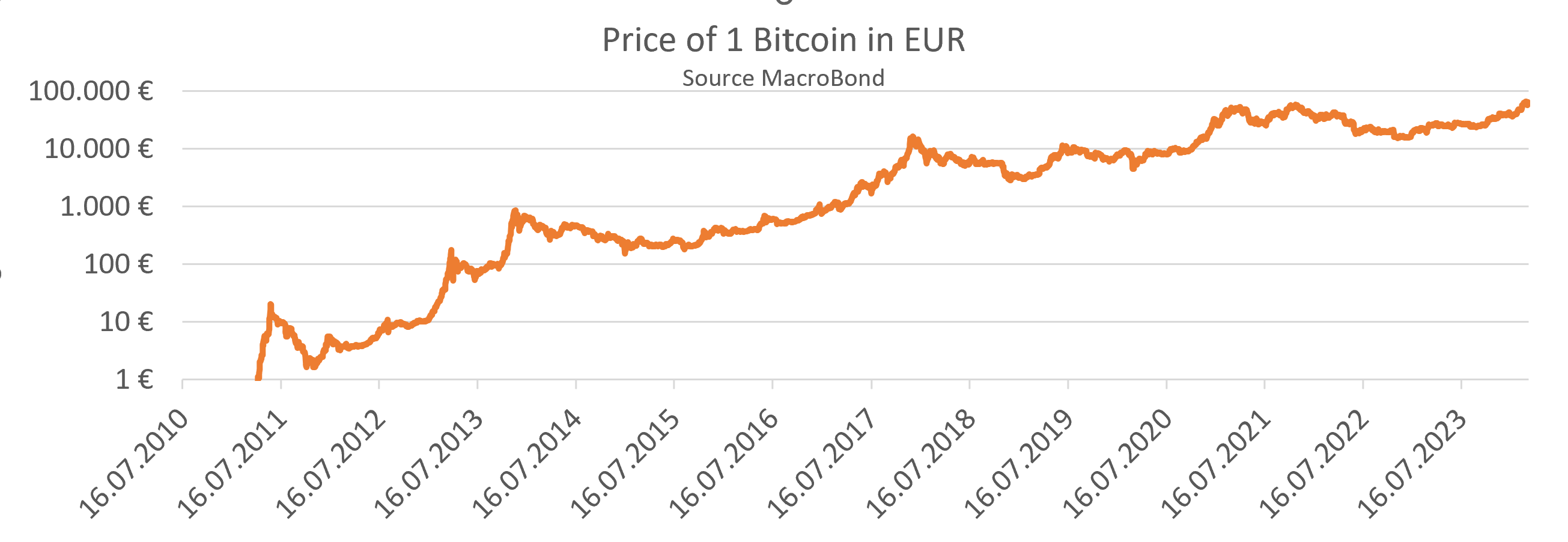 There seems to be an upward trend with some movement around the trend. Which function could describe this trend? I perform a logarithmic transformation on both axes of my chart. The new y-axis is ln(Bitcoinprice_in_EUR) and the x-axis is the ln number of days since the Bitcoin genesis block ln(Date - 03 Jan 2009). 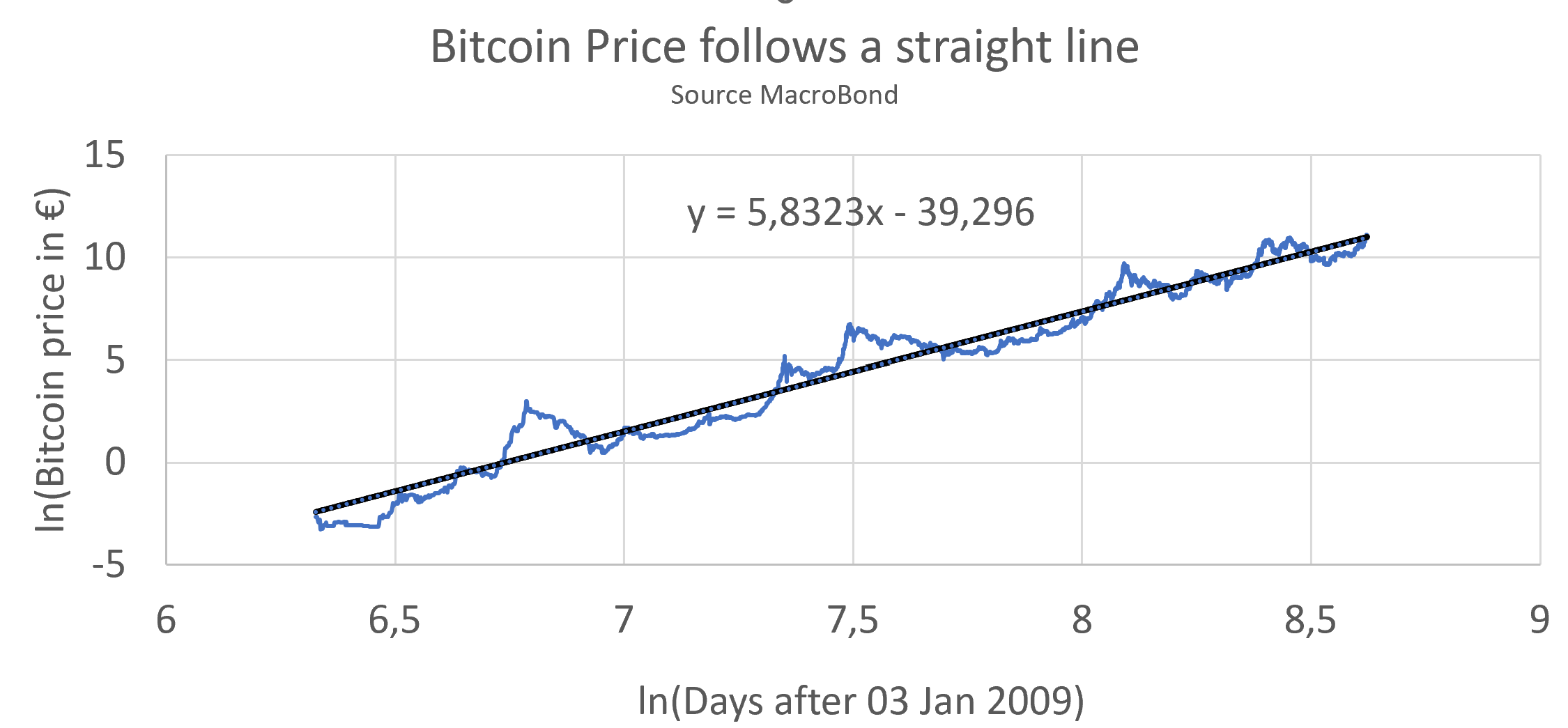 The in ln-space the Bitcoin price follows the trend: y = 5,8323x - 39,296This translates into (= black line): Bitcoin_price_in_EUR = e^[ 5,8323 * ln(Date - 03.Jan.2009) - 39,296 ]Making the graphs easier to followA Bitcoin price in ln(EUR) and a Bitcoin age in ln(days) is easy to draw, but difficult to understand. Therefore I added the Bitcoin price in EUR and the calendar year. 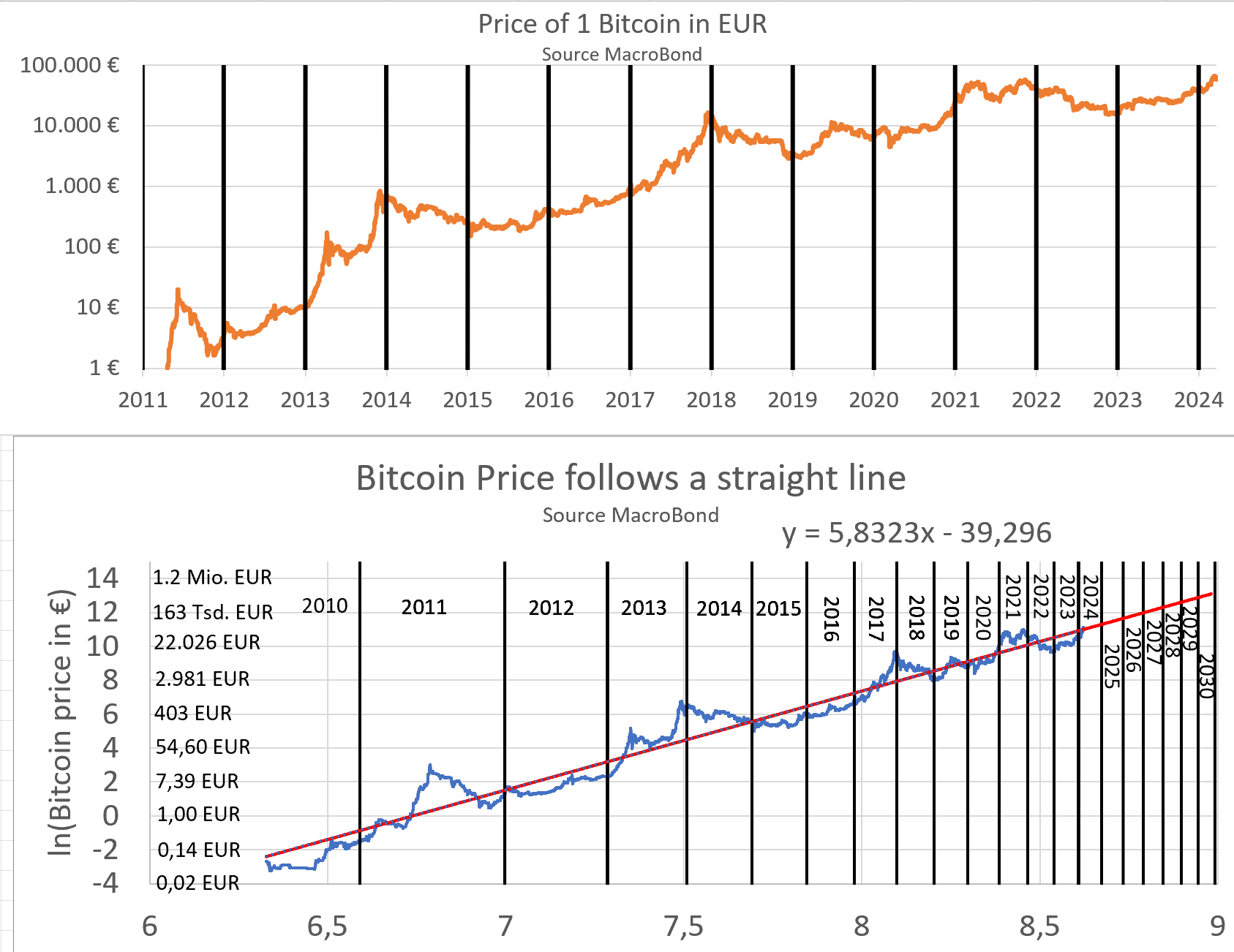 Interestingly, the Bitcoin price does not seem to fall more than 1 below the trend (= red line). Bitcoin_price_in_EUR_low = e^[ 5,8323 * ln(Date - 03.Jan.2009) - 39,296 -1]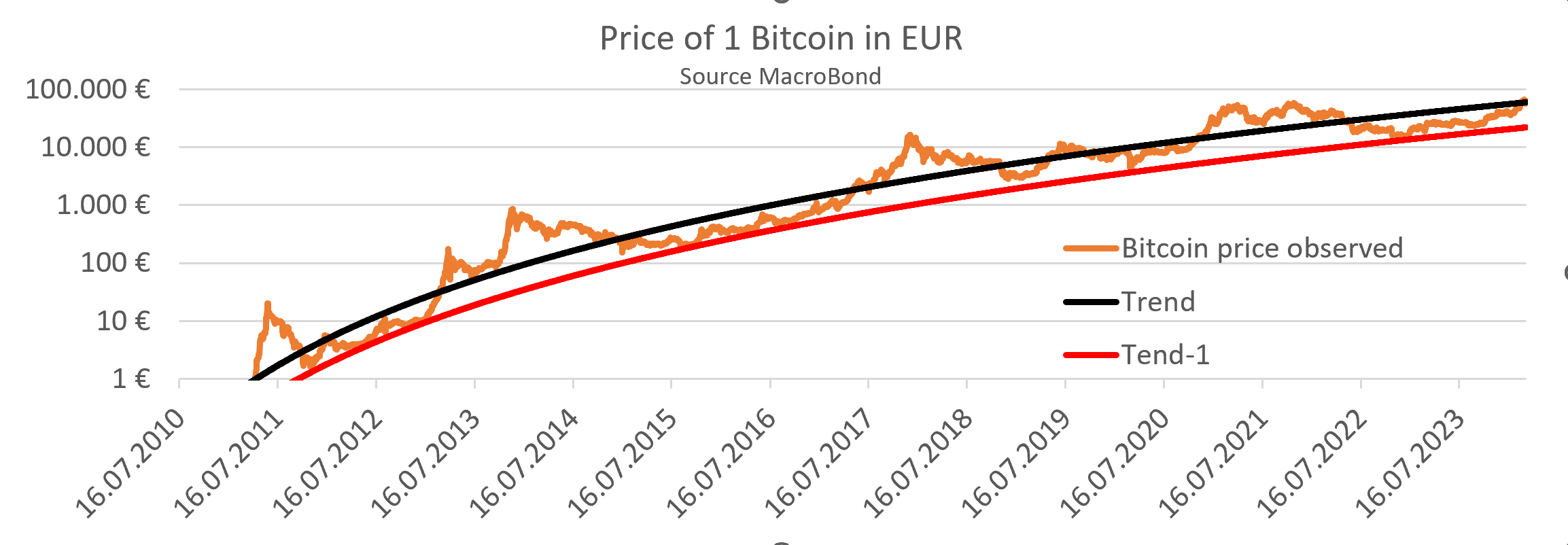 This chart is similar to the bitcoin rainbow charts produced by others*. We can now subtract the observed price from the trend to separate the cyclical component of the bitcoin price from the trend component. *https://www.blockchaincenter.net/en/bitcoin-rainbow-chart/ 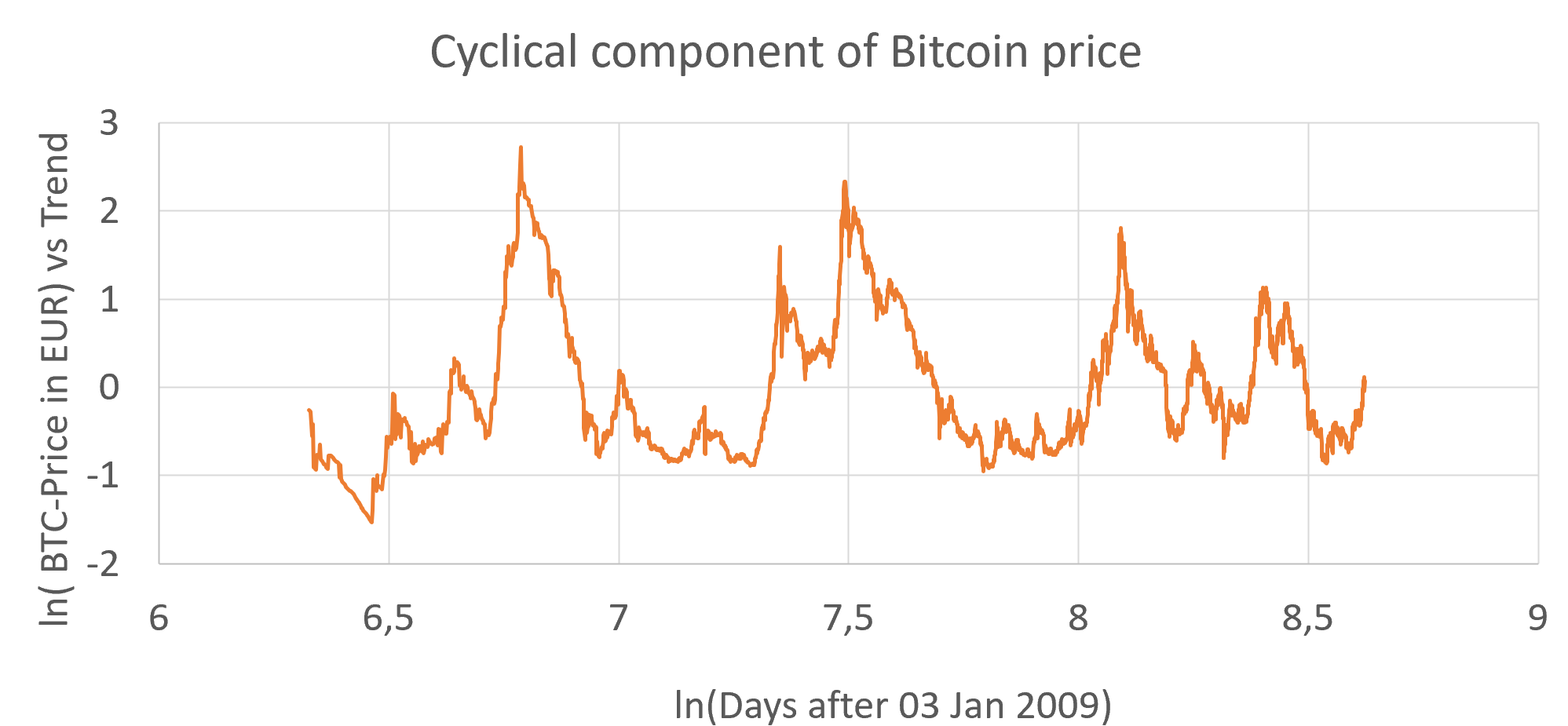 A graph of -1 on the y-axis means the Bitcoinprice was 63% below trend. If the trend was 10.000€, then the Price at -1 would be at 3679, since exp(-1) = 0.36 . Can we use the cycle information to buy at a low price and sell at a high price?A quick back-of-the-envelope chart shows us that there may be value in knowing whether bitcoin is currently cheap or expensive. If we buy bitcoin when it is expensive, we can expect a worse return than if we buy it when it is cheap. 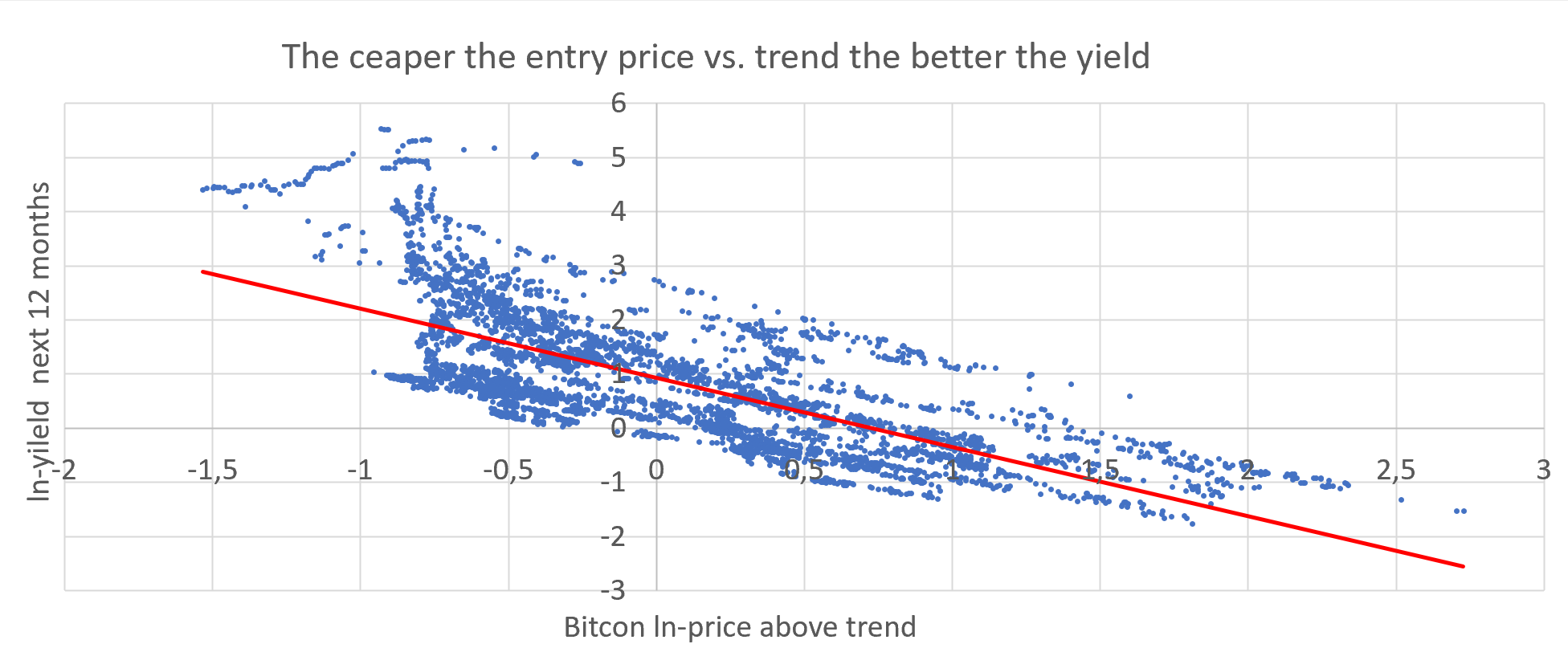 Even in recent history, the rule remains that "the cheaper you buy your bitcoin, the better": 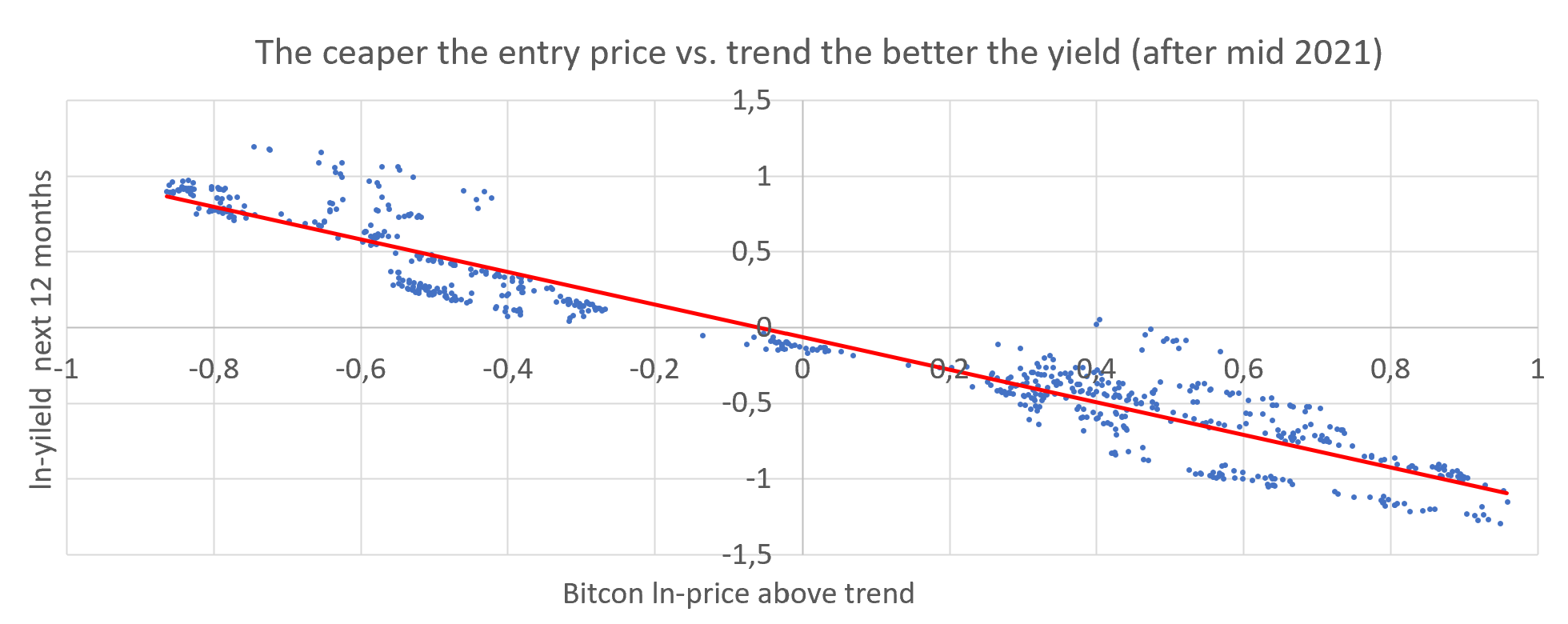 Can we find some trading rules when to buy Bitcoin and when to sell Bitcoin to outperform DCA? Finding the bottoms of the cycleWe can see that all the bottoms (except the first one on 04 Feb 2011) are between 0.5 and 1.0 below the trend:  To see the exact bottoms, I have zoomed into this chart at 0.5 to 1.0 below trend. Especially between -0.7 and -1.0 there are many bottoms. Only one bottom is lower than -1.0. 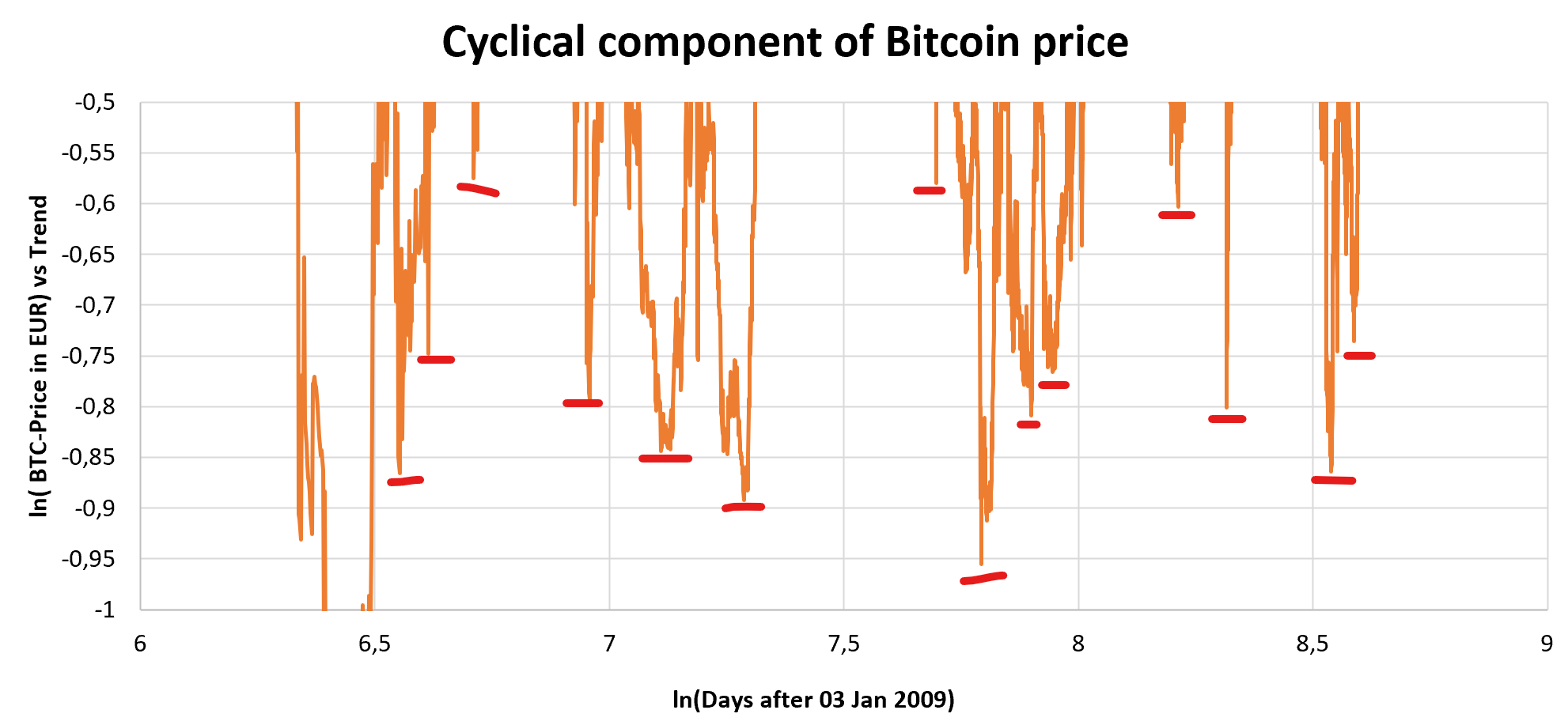 We now have a pretty good understanding of where the bottoms are. However, this assumes that the shape of the function and the parameters are stable going forward. Later I will show that the parameters are quite stable. When we are between 0.5 and 1.0 below the trend, it has always been a good time to invest in bitcoin, because bitcoin has managed to come back to the trend every time until today. Your return has been quite nice as you have received bitcoin trend growth + catching up to the trend line.Overvaluation alone is not enough to find cycle topsFinding the top of the cycle is a bit more complicated for three reasons. 1. Bitcoin tops fall into a wider range than bottoms, as can be seen in the green box.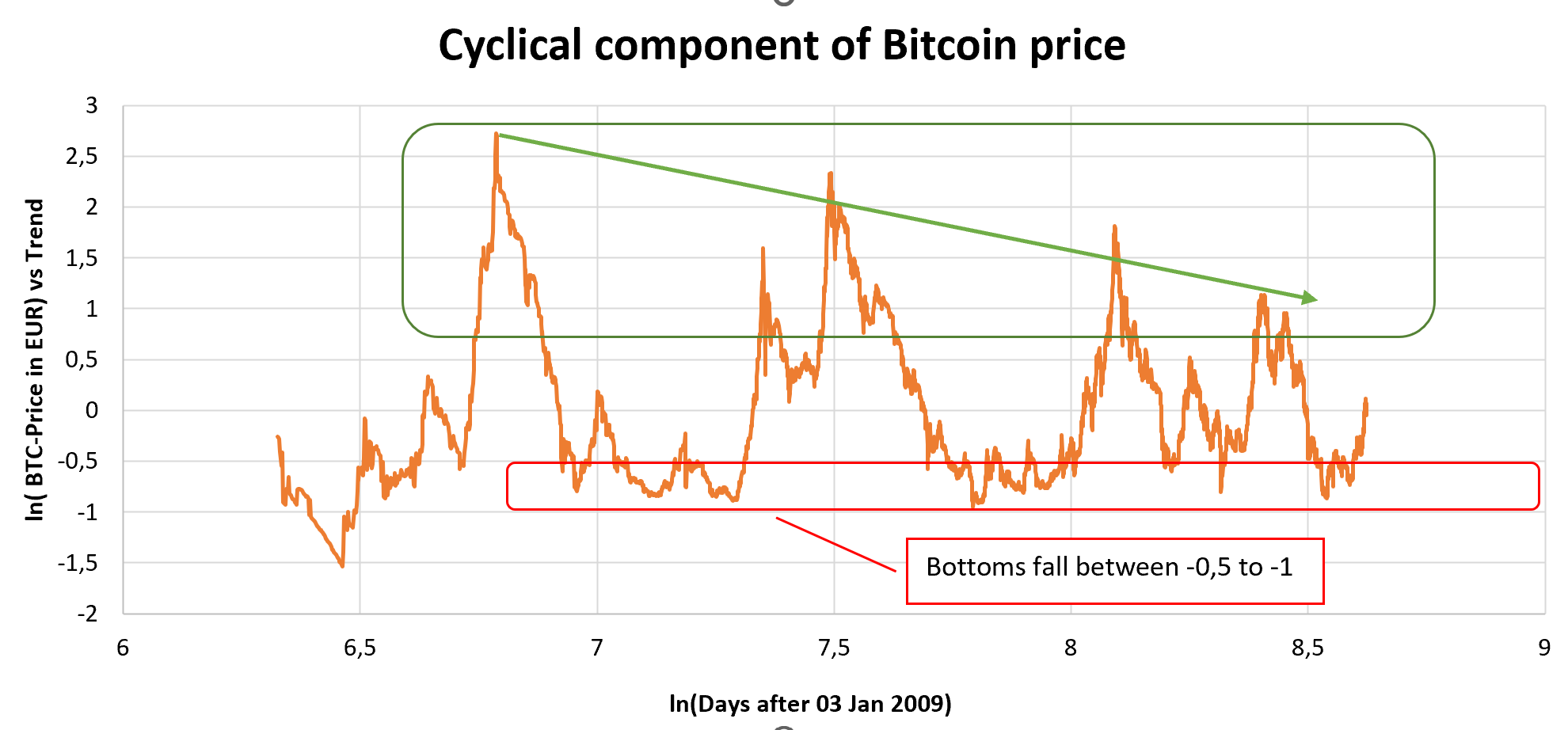 While the bottoms range from -0.5 to -1, the tops range from 0.88 to 2.7. If you think you bought the bottom at -0.5 and the price goes to -1, you lose 39%. If you think you bought the top at +0.88 and the price goes to 2.7, you miss out on a return of 517%. 2. Bitcoin's tops are getting smaller and smaller, which means you might miss the next top.For the bottoms we don't see a trend, the bottoms fall randomly between -0.5 and -1, so we could expect the next bottom to fall between -0.5 and -1 again. For the tops, we can see a declining trend. This means that the next top could be even lower than 0.88. Maybe only 0.5. 3. Selling expensive bitcoin to buy cheap bitcoin could backfire in fiat termsSelling expensive bitcoin to buy cheap bitcoin later seems like a good idea. However, waiting in cash or gold for bitcoin to become cheap again takes time. The longer you wait, the higher the trend will be. If Bitcoin does not become cheap soon enough, the trend growth will exceed the cycle contraction. So you sell expensive bitcoin at a low USD price only to buy cheap bitcoin at a much higher USD price later.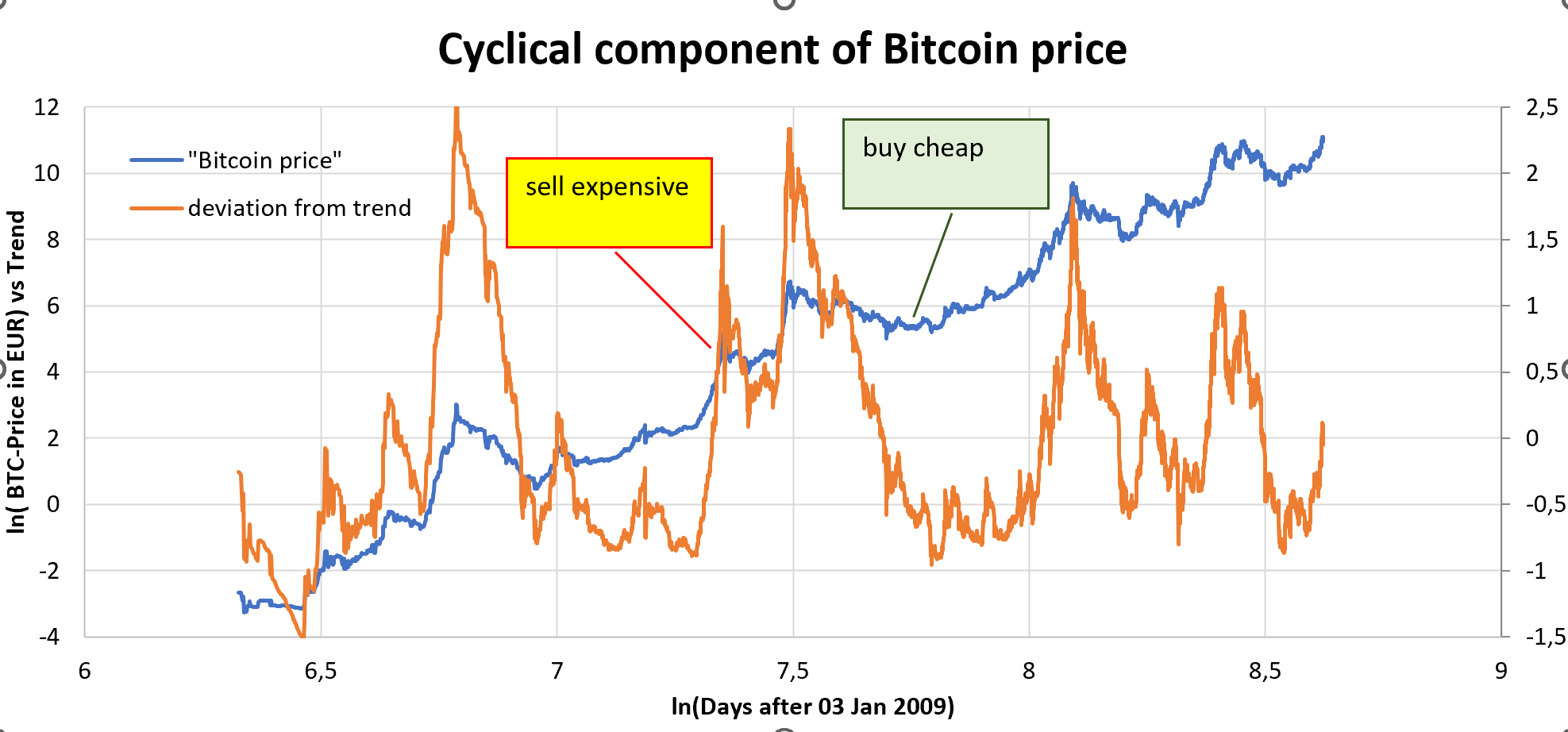 I think Bitcoin bubbles (How much new retail will join?) are less predictable than bitcoin bear markets (The stable core of bitcoiners keeps buying bitcoin). Bubbles are also more difficult to trade, because you are trading against the trend, whereas in bear markets you have the trend on your side. Selling in bubbles gives you a short window before the trend catches up. Buying in bear markets has the trend on your side. Because one of the main risks of selling bitcoin during a bubble is running out of time, therefore I ask: "How much time do we have before the trend catches up with us?". So instead of saying "the current bitcoin price is e^1 too expensive", we could say "The current bitcoin price will only be justified in 500 days.". Also, bitcoin bubbles are not dominated by growing bitcoin network effects, but by human behavior. So we work with simple days (e.g. 500 days) and not the growth of days relative to the bitcoin genesis block ln(Date - 03 Jan 2009). 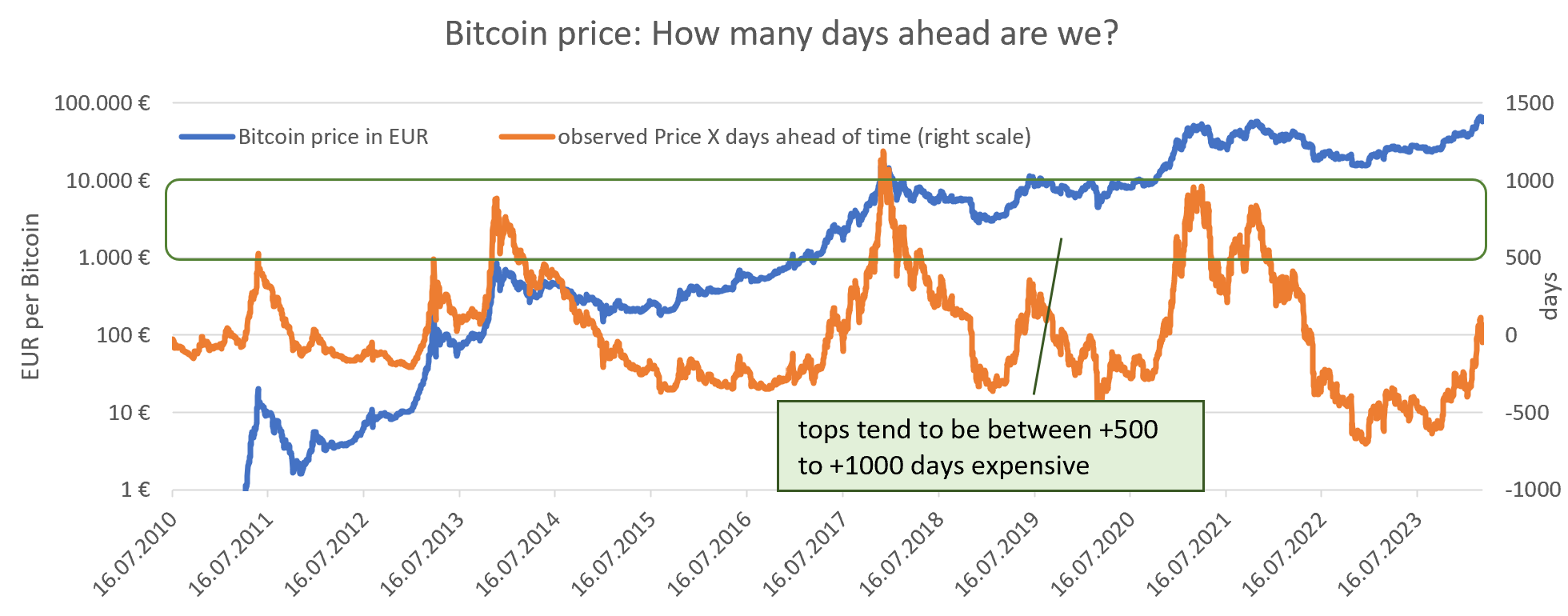 During peaks, the price of bitcoin is 500-1200 ahead of its trend. This means that the trend would have to continue for 500-1200 days to catch up with the current price. I like this chart because the peaks fall into a narrower band and since the peaks don't show a trend, you have to worry less about the next peak being outside of this band. How many days ahead are too many?Since we have found our peak indicator "days ahead of price", we can now think about a cut-off point. If the current bitcoin price is 1000 or 1500 days ahead, we will probably be able to buy bitcoin cheaper if we wait a bit. However, if the current price of bitcoin is only 10 days ahead, we are unlikely to get a cheaper price until the trend catches up with the current price. 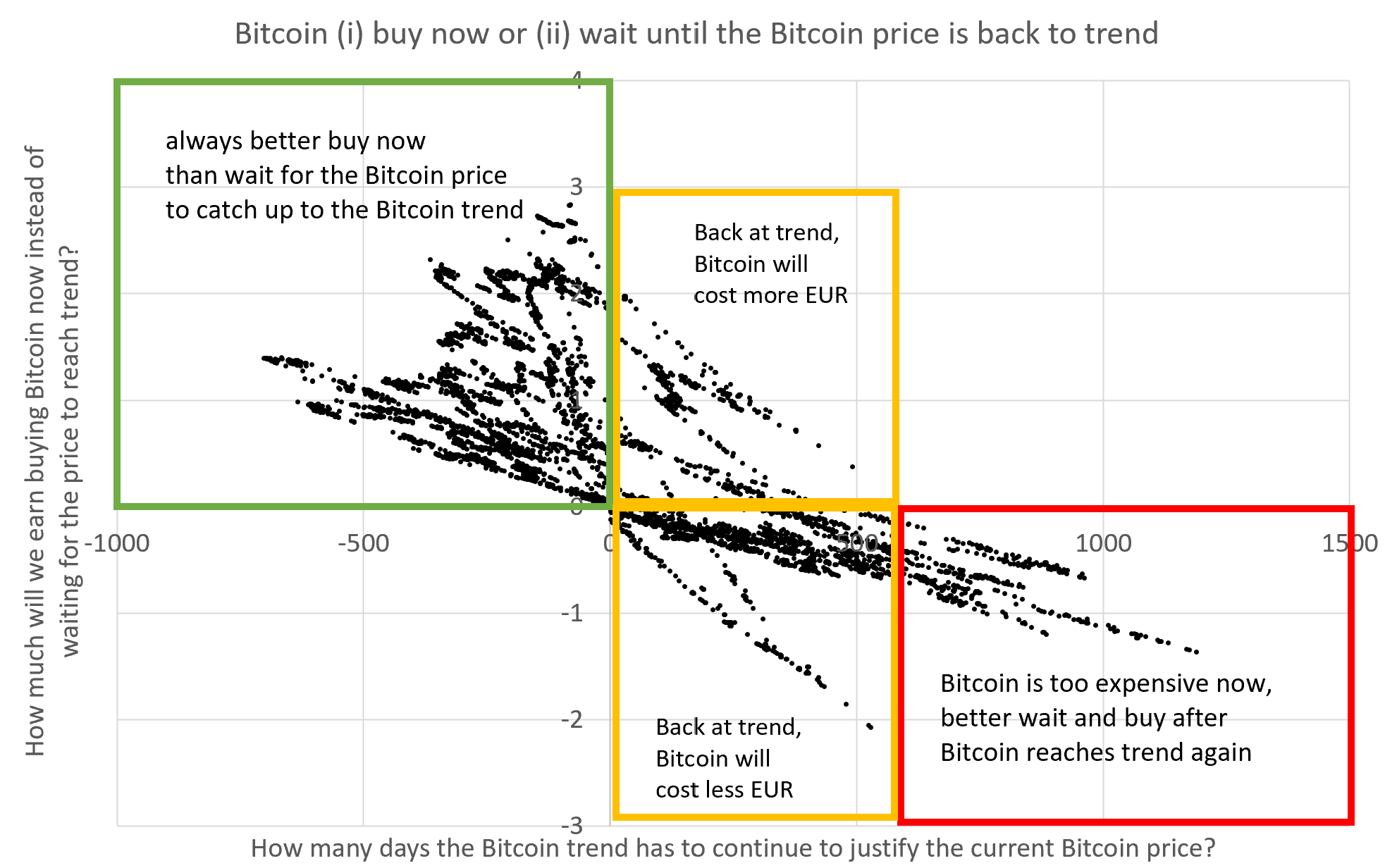 Green box: Green box: Since the bitcoin price has always returned to the trend, it was always good to buy bitcoin below the trend, as you got the increase in the trend price of bitcoin plus the cyclical price increase to return to the trend. Red box: If bitcoin has become so expensive that the trend would have to continue for more than 700 days to justify the current price, then it was always better to wait to buy bitcoin until the current price is supported by the trend again. Yellow box: When bitcoin was moderately expensive (0 - 700 days ahead of the trend), the picture is not clear. Sometimes waiting gave you cheaper prices in the future, sometimes not. If you decided to wait until you could buy bitcoin without a premium to the trend, you would have been able to get cheaper bitcoin in more than half of the cases:  Does this mean that we should never buy expensive bitcoin and instead always wait until we can buy bitcoin at the trend price? No! First of all, when bitcoin is moderately expensive (e.g. trend + 10 days), in most cases you can successfully wait for the trend to return and buy bitcoin slightly cheaper (e.g. for 5% less EUR). However, sometimes you will have to wait a long time to buy bitcoin back at fair value, which will cost you much more in fiat terms (e.g. for 200% more EUR). Second, if bitcoin is cyclically expensive, we could always wait for bitcoin to become even more expensive before selling.
Putting our strategy to the test.We invest 1000€ each month. We can either DCA or try to buy low and sell high. If bitcoin is too expensive, we sell our bitcoin for gold. If bitcoin is too cheap, we sell our gold for bitcoin. If bitcoin is neither cheap nor expensive, we DCA into bitcoin and maintain our gold position. How much do we outperform a DCA strategy depending on our definition of cheap and expensive? Backtest 1:Cheap Bitcoin means Bitcoin is 18% (e^-0.2) to 59% (e^-0.9) below trend. Expensive Bitcoin means that Bitcoin is 500 days ahead of the trend. 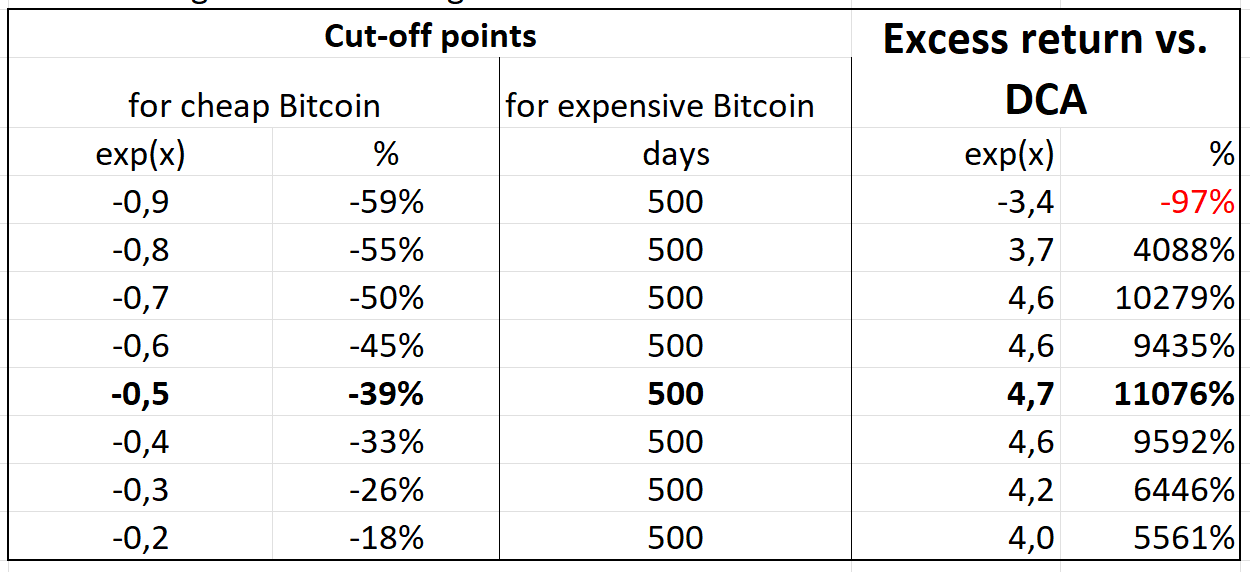 What do we learn?1.) In most scenarios we can significantly outperform DCA by up to 11076%. What do we learn?1.) In most scenarios we can significantly outperform DCA by up to 11076%.
2.) If we are too greedy and wait for Bitcoin 0.9 or 59% below trend, we will miss the re-entry into Bitcoin and thus underperform.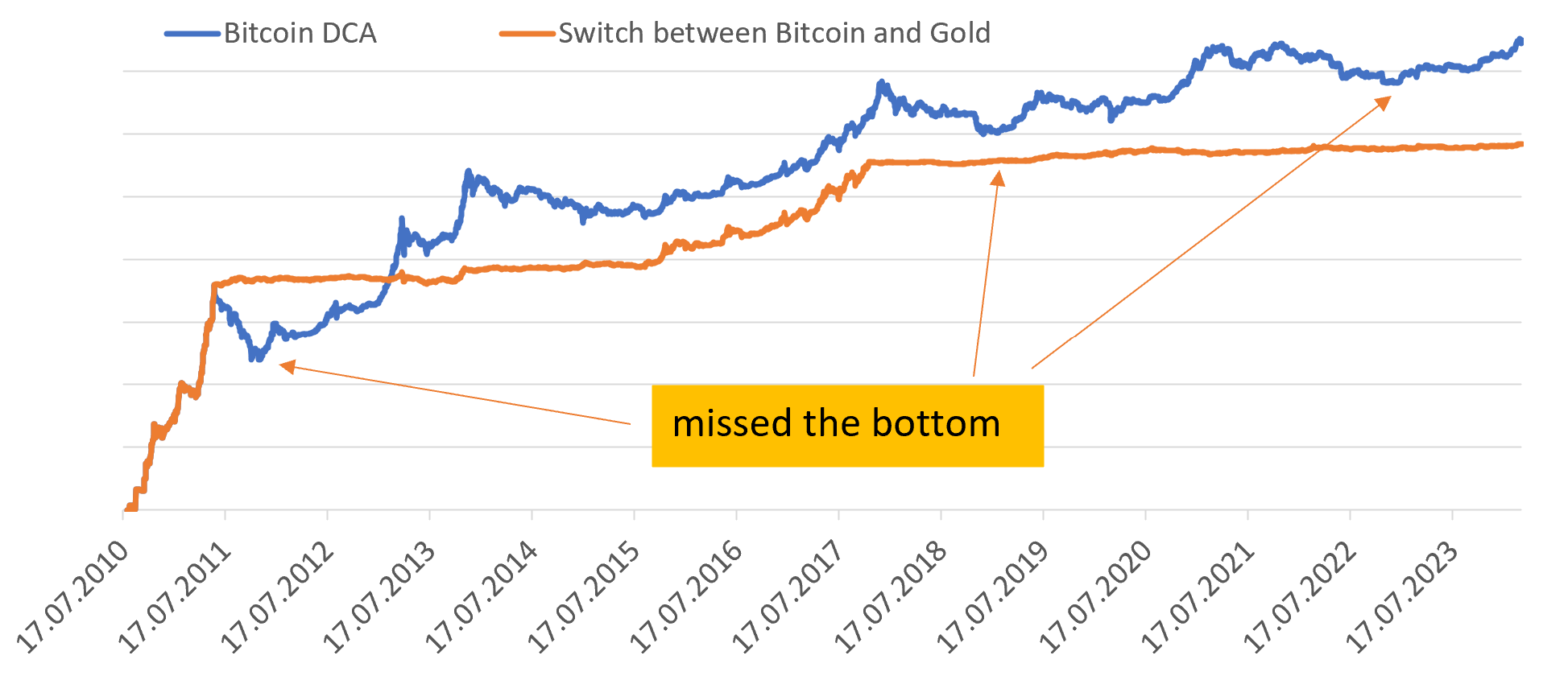 3.) It is worse to be a little too greedy than a little too cautious. Waiting to buy bitcoin 18% below trend instead of 39% below trend will cost you 2x performance. Waiting to buy bitcoin 59% below trend instead of 55% below trend will cost you 12x performance. 3.) It is worse to be a little too greedy than a little too cautious. Waiting to buy bitcoin 18% below trend instead of 39% below trend will cost you 2x performance. Waiting to buy bitcoin 59% below trend instead of 55% below trend will cost you 12x performance.Sorry for the typo, the chart title should be: Sell Gold, if Bitcoin is 39% below trend. Buy Gold if Bitcoin is 500 days ahead of trend. Otherwise keep your Gold position and DCA into Bitcoin. -> A re-entry into bitcoin at 0.5% or 39% below the trend looks best to me. Backtest 2:Ceap Bitcoin means Bitcoin is 39% (e^-0.5) below trend. Expensive Bitcoin means Bitcoin is between 200 and 1000 days above trend. 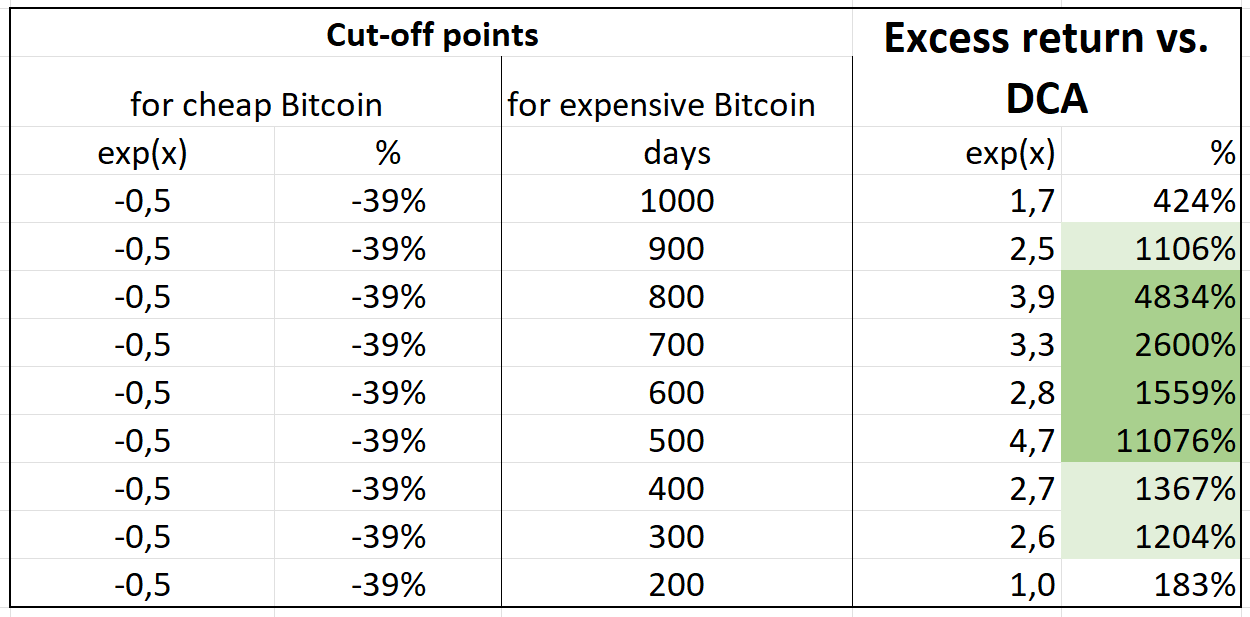 What do we learn?1.) Again, we can significantly outperform DCA by up to 11076%. What do we learn?1.) Again, we can significantly outperform DCA by up to 11076%.
2.) We have two peaks at 4834% outperformance and 11076% outperformance. In between we have lower outperformance. There seem to be several local maxima that we can only hit with the benefit of hindsight. As my default position is in bitcoin and not gold, I would only sell my bitcoin when it is 700-800 days expensive. Backtest 3: Backtest 3:To determine whether bitcoin is cheap relative to our trend function, we must first estimate the function. Therefore, we could not have started measuring Bitcoin vs. Trend from day 1. Currently we are about 5600 days from the Genesis block. Therefore, I assume that we can only start selling expensive bitcoin and buying cheap bitcoin 3000 days after the genesis block, as only then will we have a stable trend function. Will we still outperform from day 3001 to day 5550? Cheap bitcoin means bitcoin is 18% (e^-0.2) to 59% (e^-0.9) below trend. Expensive Bitcoin means that Bitcoin is 750 days ahead of the trend.  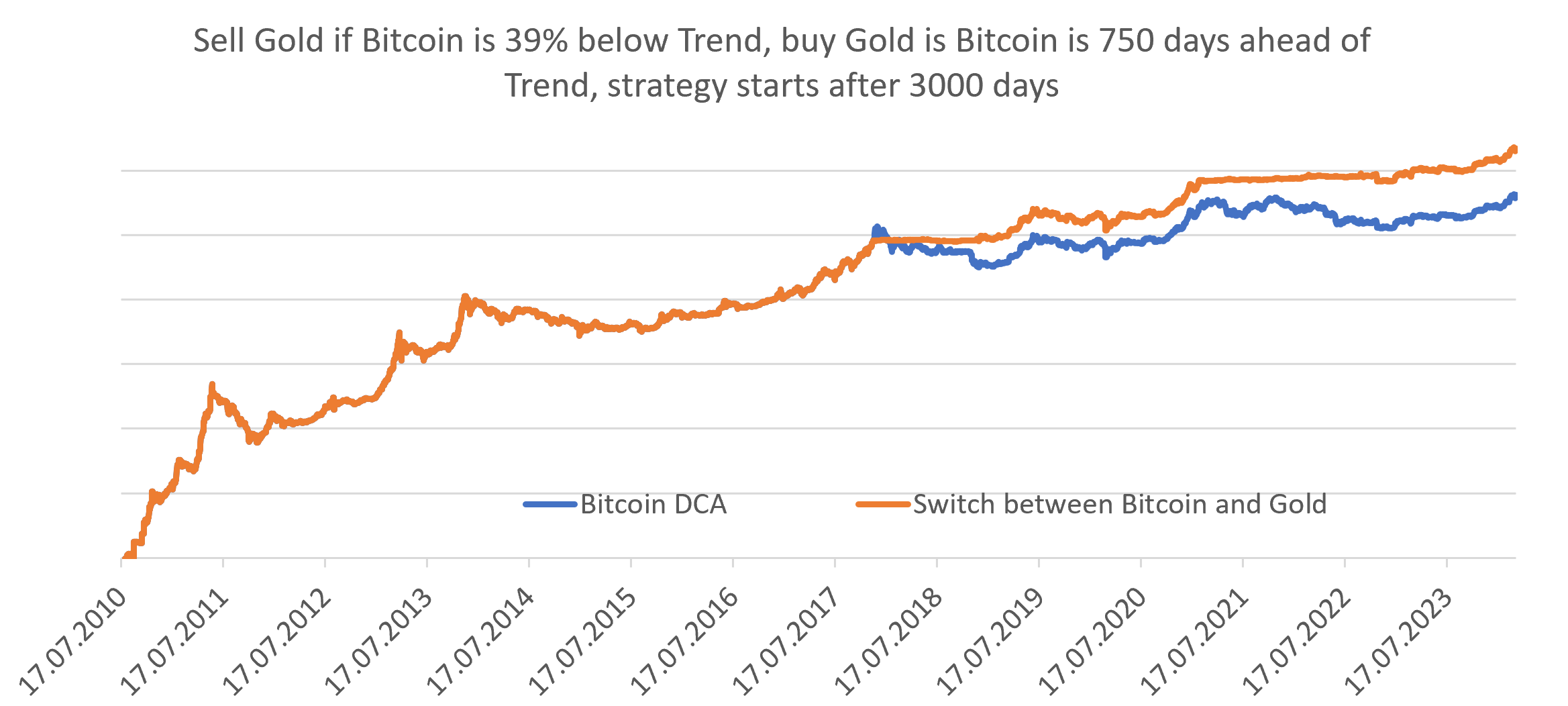 What do we learn?We can confirm past results. In recent history, the strategy still offers significant outperformance. We should be cautious when trading bitcoin and not wait for too big a drawdown. What do we learn?We can confirm past results. In recent history, the strategy still offers significant outperformance. We should be cautious when trading bitcoin and not wait for too big a drawdown.Selling late (750 days high) is also better than selling early (500 days high). 
Crating a simple decision chart for day to day useThe analysis in this post helped us to understand the Bitcoin trend, the Bitcoin cycle and optimum entry and exit points within the cycle. For daily usage I will visualize the relevant information in an simple chart. 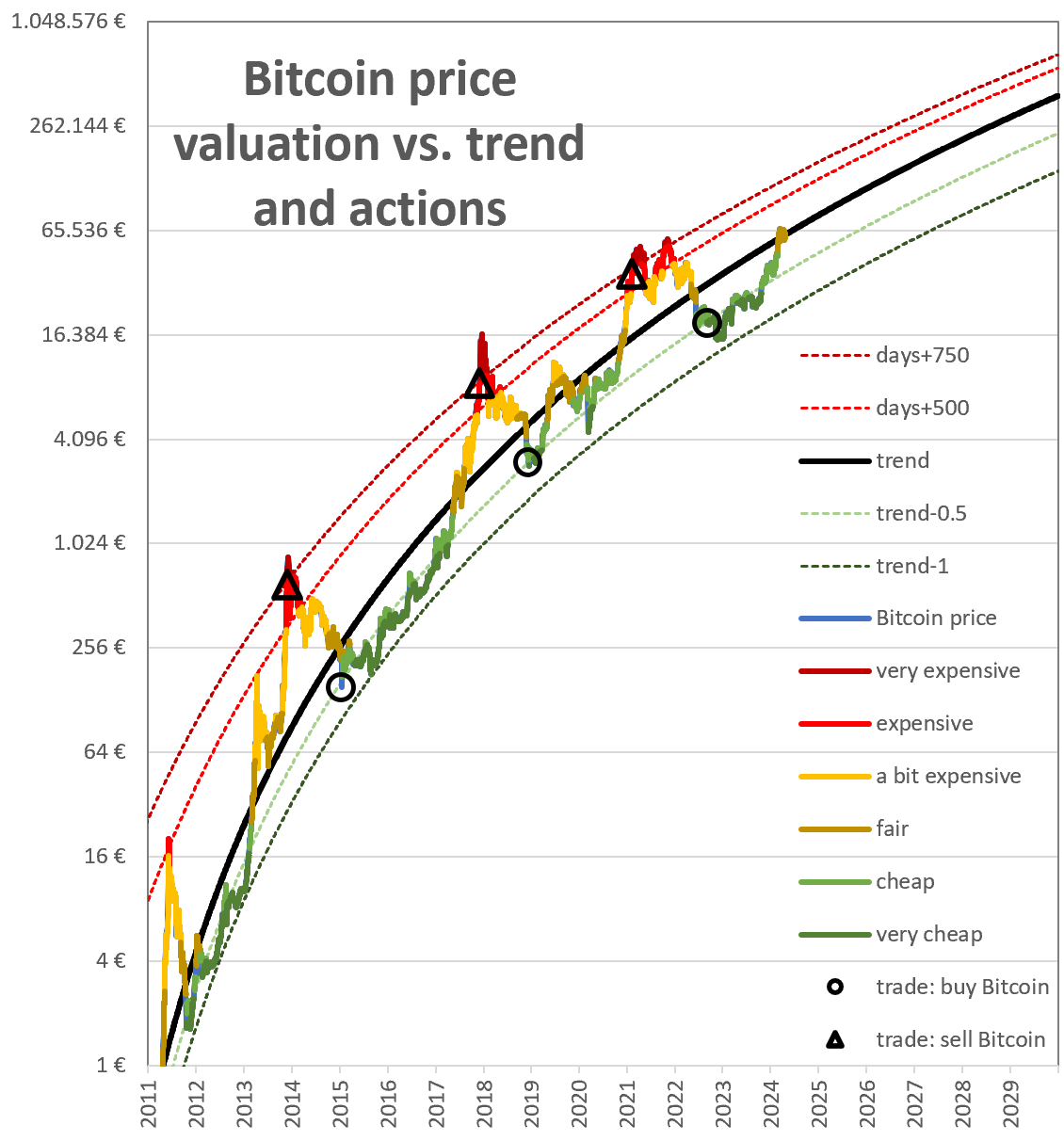 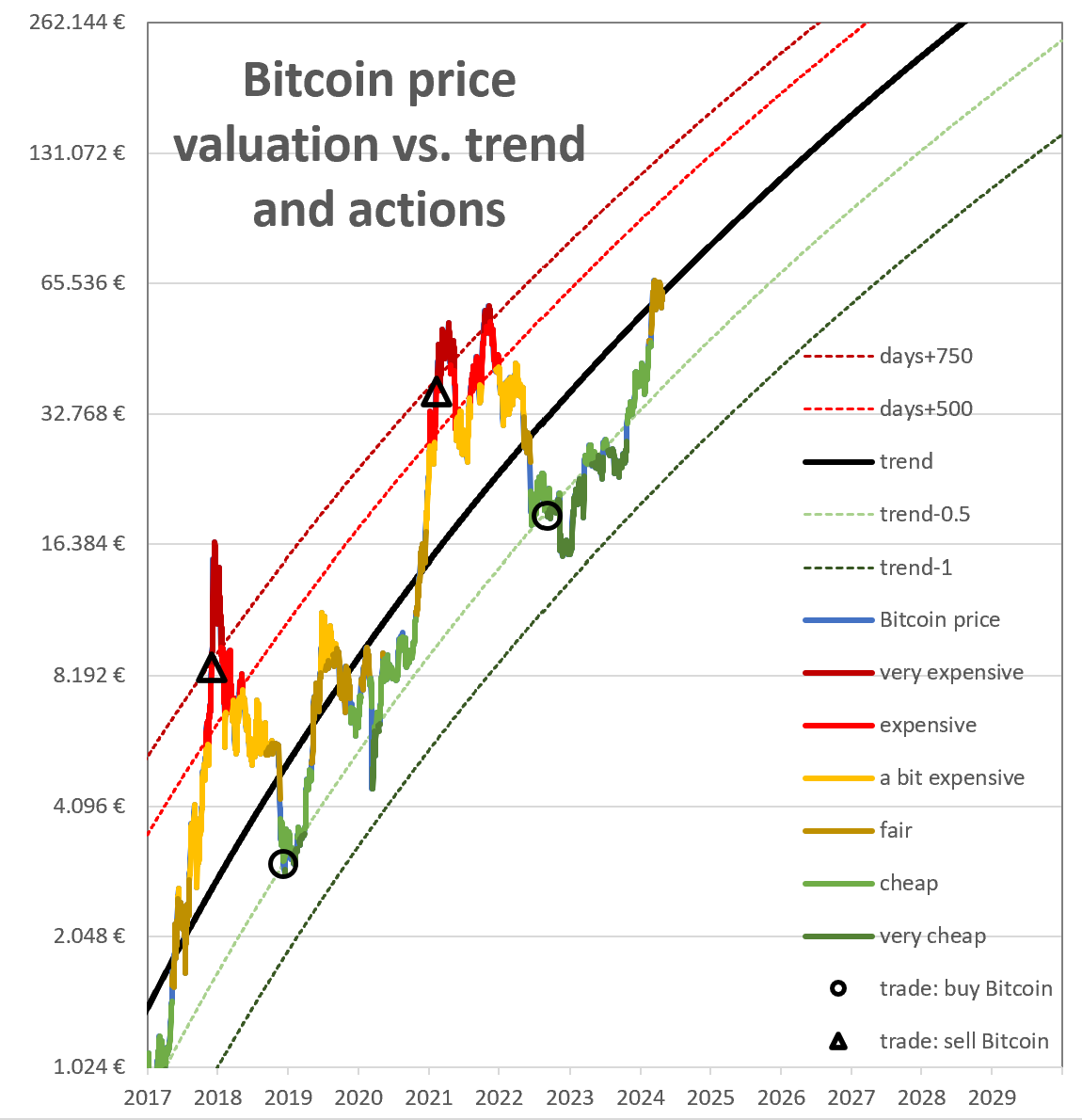 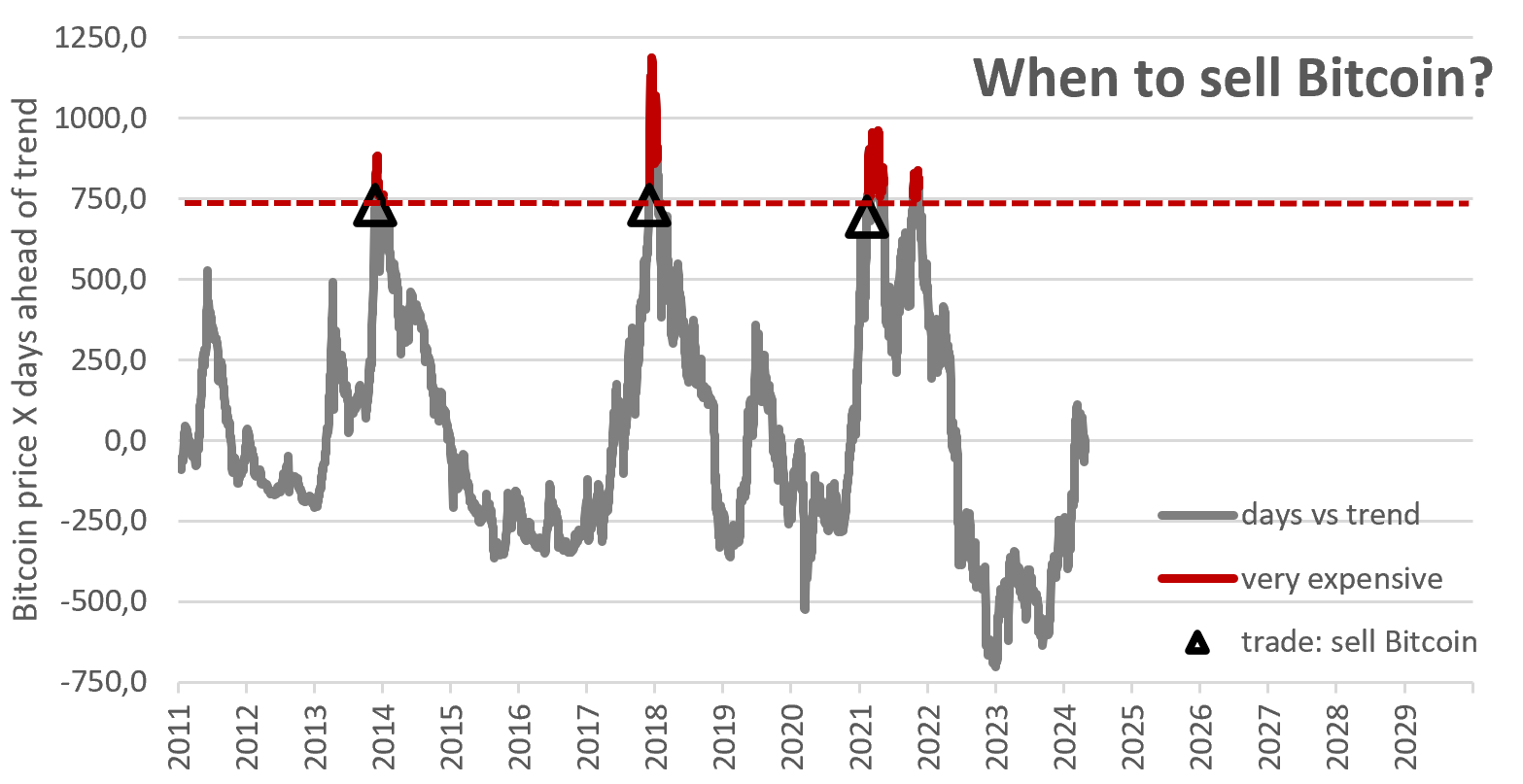 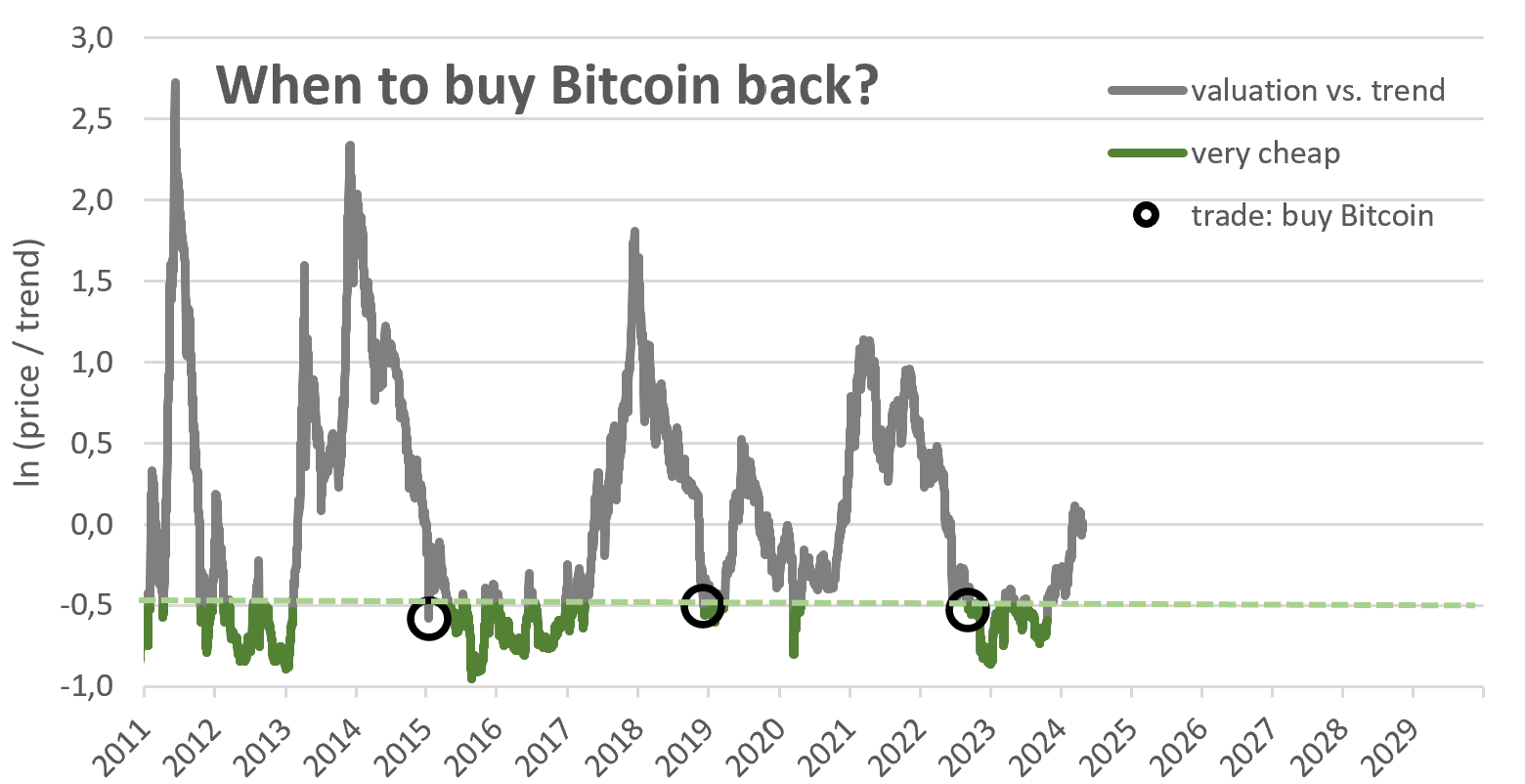
Checking the model for weaknessesChecking the stability of the bitcoin trend lineRisk: We believe that bitcoin is cyclically cheap, but the bitcoin price trend just went down. We need to measure the bitcoin price trend correctly in order to extract the cyclical price component correctly. Otherwise, we wouldn't know where we are in the cycle and would make inefficient decisions when buying and selling bitcoin. However, the early days of bitcoin's adoption dominate the data set, masking possible recent changes in the trend. I would like to see a stable trend in the past. A stable trend in the past gives us more confidence in extrapolating that trend than an unstable trend in the past. 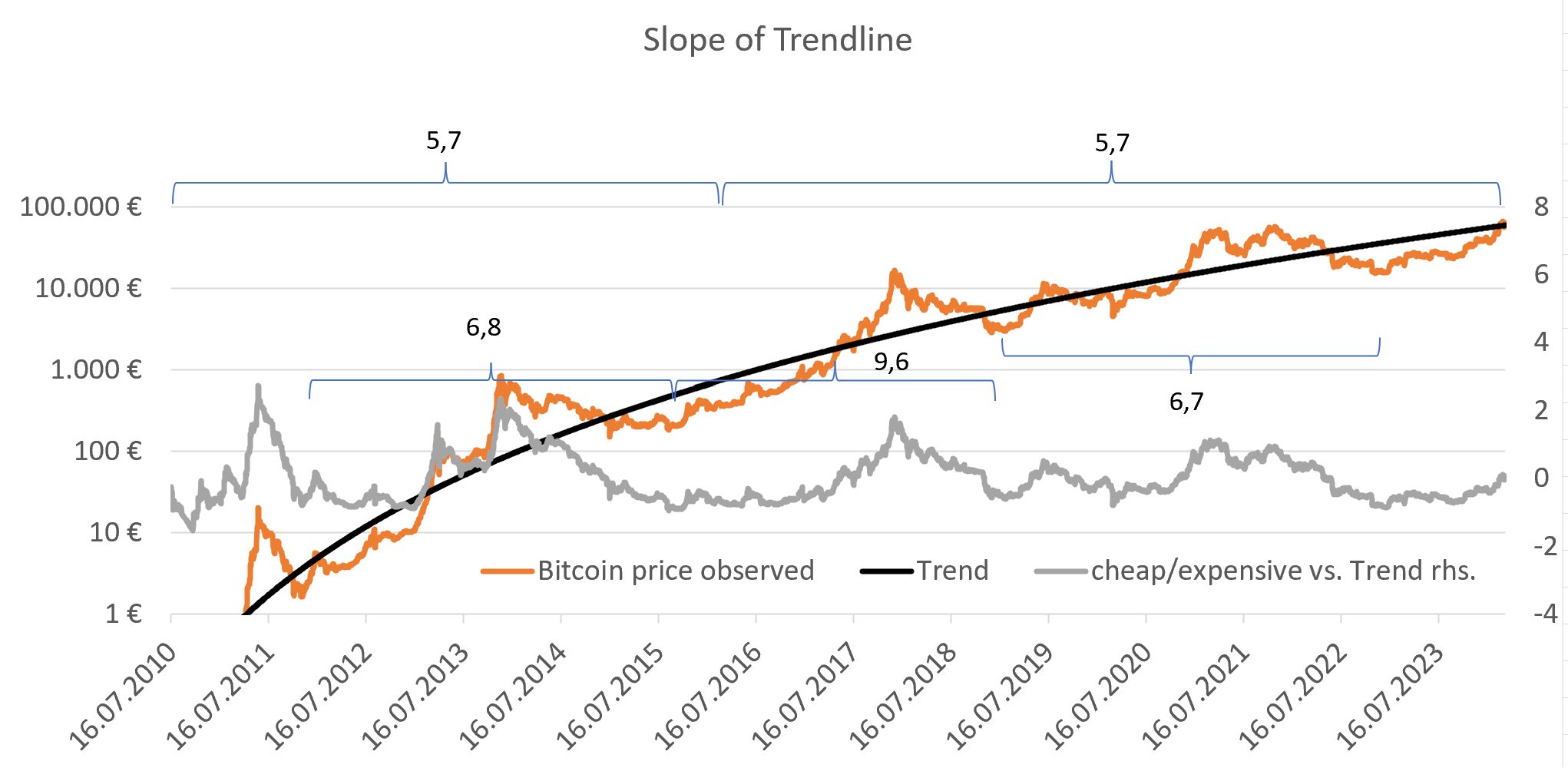  Stable: Stable: If we divide our data set into the first two major tops (16/10/2010 - 01/05/2016) and the second two major tops (02/05/2016 - 21/03/2024), we get a trend of almost 5.7 in both periods. More or less stable: If we divide the data set into 3 sets from cycle bottom to cycle bottom, we get a slope of 6.7, 9.6, 6.7. If we divide the data set into 3 sets from cycle top to cycle top, we get a slope of 5.8, 3.5, 5.5. The trend looks reasonably stable at around 6. One day in the future, the price of Bitcoin could change its behaviour and break our current model (when Bitcion is cheap or expensive). This model will need to be revised if the bitcoin price falls significantly more than 63% (e^-1 = -63%) below trend. This model will also need to be revised if the slope of our function changes significantly. This could be the case due to significant regulatory changes in the US or due to the introduction of Mayor. This could also happen if bitcoin adoption runs out of steam. In the long run, financial assets (cash, bonds, loans, gold, part of the value of real estate, most of the value of art) can't grow faster than the amount of goods and services. The bitcoin trend looks stable so far and we can reasonably expect this trend to continue for some years into the future. However, we should be aware that one day our model will break. -> The model is stable so far Introduction of M2 inflation for USD and EUR not necessary at presentWe measure the value of bitcoin against fiat. However, money printing devalues fiat and could affect our results. Adjusting for inflation reduces our slope from 5.8 to 5.2, but so far has not had a major impact on the model's results. This would change if the pace of inflation or monetary expansion in the US or the eurozone were to increase significantly. A much stronger monetary expansion in the future would increase the slope of our trend function. This could lead to a premature switch from bitcoin to gold, which would then also rise due to inflation, making this mistake less costly. -> I use a bitcoin price that is not adjusted for M2 because bitcoin price data is more recent than M2 data and to keep the model simple. However, one should keep an eye on the monetary expansion of the major central banks. TaxationSwitching between gold and bitcoin has an additional tax burden on realised taxes. As a rule of thumb, it is more efficient to let your wealth compound and pay your legal taxes later than earlier. In my country there is no capital gains tax on gold or bitcoin after 12 months, but your tax situation may be different. PrivacyTrading in and out of bitcoin leaves data with exchanges, banks, etc. You may value your privacy more than additional financial wealth and therefore refrain from trading. Even if privacy and tax concerns limit your trading decisions, you can still choose to postpone your regular DCA close to a top. If you are planning to sell some of your bitcoin anyway, you could choose the top. If bitcoin is significantly undervalued, you can buy additional bitcoin.
How do I apply this knowledge to my investment decisions?In general, I have two constraints on my bitcoin investments: 1. Liquidity constraint: I need a liquidity buffer for (i) expected negative future cash flows and (ii) unexpected liquidity needs, for which I assume 2 annual salaries. This liquidity buffer is invested in cash (for short term needs) and a minimum drawdown portfolio of equities/gold (for medium term needs). I make a cash flow projection for the next 8 years (salary plus other income minus food minus mortgage) and calculate my minimum excess liquidity during these 8 years. This excess liquidity is earmarked for buying bitcoin. 2. Single position risk constant: I'm willing to invest 2/3 of my current and expected future net worth in bitcoin. After 2/3, I can only buy bitcoin in the bear market if I sold bitcoin during the bull market. I divide my excess liquidity into 3 equal buckets:1. bucket will be invested when we reach e^-1 undervaluation. 2. bucket will be invested when we reach fair value. 3. bucket will be partially invested each month as long as bitcoin does not exceed 150 days of overvaluation. Unfortunately the current bitcoin price is lightly above trend. Therefore I can only deploy bucket nr. 3. I should have invested earlier, but I'm still in the process of formulating my strategy.
I hope my post offered some value to some of you. I personally got some insights out of my calculations. However since I'm relatively new to the Bitcoin space, it is possible that my thoughts are not new for some members here. Therefore I would like to get some feedback, if I made some mistakes to how to improve my model. Do you think, it is possible to outperform investing into Bitcoin taking the cycle into account instead of just dollar cost averaging into Bitcoin?
Did you find any mistakes in my thought process?
|
Sicherheit für deine Familie, dich und deine BTC, dank der fundierten Sicherheits-Tipps der KryptoArche. Wir kaufen Bitcoin zum Vermögensaufbau oder zur Krisenvorsorge. Wir kaufen Bitcoin dezentral als Schutz vor Räubern, mit guter Historie und verwahren unsere Bitcoin sicher vor Verlust, Räubern und Dieben sowie versteckt Wir nutzen sichere Passwörter, Betriebssysteme, Software und sufen sicher. Sicher dir deinen kostenlosen Platz auf der KryptoArche! Die Zeit läuft ab! Steig ein, bevor es zu spät ist! Gemeinsam bleiben wir immer über Wasser!
|
|
|
|
|
|
|
|
|
|
It is a common myth that Bitcoin is ruled by a majority of miners. This is not true. Bitcoin miners "vote" on the ordering of transactions, but that's all they do. They can't vote to change the network rules.
|
|
|
Advertised sites are not endorsed by the Bitcoin Forum. They may be unsafe, untrustworthy, or illegal in your jurisdiction.
|
|
|
|
|
|
|
|
Solosanz
|
 |
March 28, 2024, 02:44:39 PM |
|
Long thread, but it's really informative.
The only suggestion I can give is you might need to resize your image a bit smaller, probably like "[img width=700" or less, because it's too big IMO.
Selling Bitcoin for gold or vice versa isn't easy because the seller won't accept Bitcoin or gold as currency, so you're need to sell your Bitcoin to fiat then buy gold, it would cost additional fees.
The thing that I learn, despite Bitcoin keep break new ATH for every four years, but actually the trend tops are getting smaller and smaller, probably in the next two halving events, the tops and bottom are close, which make Bitcoin become more stable...
|
| .
.Duelbits. | │ | | │ | ▄▄█▄▄░░▄▄█▄▄░░▄▄█▄▄
███░░░░███░░░░███
▀░░░▀░░▀░░░▀░░▀░░░▀
▄░░░░░░░░░░░░
▀██████████
░░░░░███░░░░▀
░░█░░░███▄█░░░█
░░██▌░░███░▀░░██▌
░█░██░░███░░░█░██
░█▀▀▀█▌░███░░█▀▀▀█▌
▄█▄░░░██▄███▄█▄░░▄██▄
▄███▄
░░░░▀██▄▀ | .
REGIONAL
SPONSOR | | ███▀██▀███▀█▀▀▀▀██▀▀▀██
██░▀░██░█░███░▀██░███▄█
█▄███▄██▄████▄████▄▄▄██
██▀ ▀███▀▀░▀██▀▀▀██████
███▄███░▄▀██████▀█▀█▀▀█
████▀▀██▄▀█████▄█▀███▄█
███▄▄▄████████▄█▄▀█████
███▀▀▀████████████▄▀███
███▄░▄█▀▀▀██████▀▀▀▄███
███████▄██▄▌████▀▀█████
▀██▄███▀██▄█▄▄▄██▄████▀
▀▀██████████▄▄███▀▀
▀▀▀▀█▀▀▀▀ | .
EUROPEAN
BETTING
PARTNER | |
|
|
|
|
thecodebear
|
 |
March 28, 2024, 03:44:21 PM
Last edit: March 28, 2024, 04:06:57 PM by thecodebear Merited by virginorange (1) |
|
Can we time the Bitcoin cycle?
The case for Dollar Cost Averaging (DCA)
Most people discover Bitcoin during a bull market, invest money, get discouraged during the bear market and sell. As a result, they can lose in USD terms even though they have invested in an asset with a huge average trend growth. Investing the same amount in Bitcoin every month is an easy rule to follow. It saves you the mental load of thinking about when and how much to invest and prevents you from buying at the euphoric top and selling at the depressed bottom.
The case for countercyclical buying
However, if we could be reasonably sure that Bitcoin were near the top or near the bottom, we could invest accordingly. For example, we could stop DCA during the euphoria and double DCA during the bear market. Or we could sell some of our bitcoin close to the top and buy back close to the bottom. This would be a simple DCA strategy.
Yeah since Bitcoin has a very well known 4 year market cycle and clear bull runs and bear markets in the four year cycle, it is easy to DCA extra during the lower part of the cycle and then save up fiat during the high part in order to DCA extra when the low part of the cycle comes back. That's my strategy from here on out. It's still DCA, but using the most basic knowledge about Bitcoin's market cycles to get a much improved DCA over a typical steady buying DCA strategy. For example, I've been DCA'ing recently in the $60,000s and low $70,000s, but probably won't do any more from this point onward this bull run. I'll wait until prices get back under $80k next bear market to resume DCA around bottom of the next bear market, and then I'll continue doing it until price passes whatever the high ends up being this cycle. There really is no reason to DCA during the main part of the bull markets, you're just buying higher than you would be buying if you waited for the bear market. This better strategic DCA of course only works with Bitcoin (and things that follow Bitcoin), as opposed to the stock market where a consistent DCA is best because there is no way to guess when asset prices will be higher or lower than today. Bitcoin following an regular market cycle allows us to easily beat out the typical consistent DCA with a strategic DCA only buying on the lower half of the market cycle. In terms of selling at the top, you COULD do that as well, but then you have the risk of missing the top by a lot and maybe after taxes it wouldn't even be worth it, I dunno thats for each person to decide for themselves. I personally would prefer the super low risk strategy of strategically only DCA during low part of the market cycle and save during the high part of the cycle, while holding everything long term. |
|
|
|
|
Ascended_Intellect
Newbie

 Offline Offline
Activity: 12
Merit: 0

|
 |
March 28, 2024, 03:46:46 PM |
|
Fantastic breakdown!
Your analytical approach may prove to be accurate but time will answer this.
Some may complain about the "complicated nature" of the breakdown but when the average person is consumed by short form entertainment it's a given.
Personal standpoint for this current cycle is that we are below the ATH by a good margin, my guess is that BTC will top out at 67-70K GBP.
My theory even though the market is unpredictable is that we cannot possibly have a downtrend in price back to base level due to the recent bear market we just had, I've seen assumptions that this bull run will last into 2025 but November 2024 seems like a more reasonable guess.
|
|
|
|
|
|
348Judah
|
 |
March 28, 2024, 04:13:24 PM |
|
If you think the use of DCA is what you can afford to go with, then the best thing is to embrace using such purchasing pattern for your bitcoin accumulation and you could easily get going well with your investment over a long term, this method has been seen as part of the most simplest means everyone can afford to use in making an investment, you have done well in bringing all these together OP, there is more we can also learn extensively using these same pattern from this link. https://dcabtc.com/ |
| R |
▀▀▀▀▀▀▀██████▄▄
████████████████
▀▀▀▀█████▀▀▀█████
████████▌███▐████
▄▄▄▄█████▄▄▄█████
████████████████
▄▄▄▄▄▄▄██████▀▀ | LLBIT | │ | CRYPTO
FUTURES | | | | | | | │ | 1,000x
LEVERAGE | │ | COMPETITIVE
FEES | │ | INSTANT
EXECUTION | │ | .
TRADE NOW |
|
|
|
|
Turbartuluk
|
 |
March 28, 2024, 04:38:00 PM
Last edit: April 09, 2024, 01:44:48 PM by Turbartuluk Merited by virginorange (1) |
|
Very impressive, it is a pleasure to see your brain working.
Indeed it was occasionally hard to understand your process, due to the deepness of analysis. I guess it takes me about 90min to read and understand everything, but it was worth every second.
In the end everything was plausible to me and i was not able to find mistakes in your thought process.
Just one suggestion for improvement: Instead of switching to gold you could switch to a "betting against beta" portfolio. Choosing Altcoins with lower performance than BTC in the bull and betting against them via Altcoin short BTC long could help you to minimize risks and peak out the bull market.
It might also be an approach for entry in the bear market to eliminate the risk of BTC going to zero, but obviously the risk of marketwide altcoinrun is much highter when entering Alts short / BTC long in the Bear market.
|
|
|
|
|
|
Queentoshi
|
Very long read, but I managed to follow through till I could really make meaning of it. Do you think, it is possible to outperform investing into Bitcoin taking the cycle into account instead of just dollar cost averaging into Bitcoin?
Your strategy of Dollar cost averaging according to the circles will be effective for a smart investor with a good knowledge of bitcoins and understanding of the market, a newer investor in bitcoins may not be able to monitor the market properly to know when they should DCA more and pause DCA, so we advise them to just first develop the habit of investing by regular DCA, before they are mature enough to now do DCA more smartly like with this your strategy. |
| R |
▀▀▀▀▀▀▀██████▄▄
████████████████
▀▀▀▀█████▀▀▀█████
████████▌███▐████
▄▄▄▄█████▄▄▄█████
████████████████
▄▄▄▄▄▄▄██████▀▀ | LLBIT | │ | CRYPTO
FUTURES | | | | | | | | | [ | 1,000x
LEVERAGE | ] | [ | .
COMPETITIVE
FEES | ] | [ | INSTANT
EXECUTION | ] | | | ██████
██
██
██
██
██
██
██
██
██
██
██
██████ | ████████████████████████████████████████████████████████
.
TRADE NOW
.
████████████████████████████████████████████████████████ | ██████
██
██
██
██
██
██
██
██
██
██
██
██████ |
|
|
|
|
virginorange (OP)
|
 |
March 28, 2024, 07:55:34 PM
Last edit: March 28, 2024, 08:08:37 PM by virginorange Merited by hugeblack (10) |
|
Very long read, but I managed to follow through till I could really make meaning of it.
Thanks for you feedback. I added a TL;DR summary. TL;DR: A smart and disciplined investor can outperform a simple dollar cost average strategy, by buying Bitcoin depending to its price cycle. If Bitcoin is cheap (40% below trend), I would take a full position. If Bitcoin's price is expensive (more than 750 days ahead of trend), I would not add to my position and possibly even trim my position. If Bitcoin is neither cheap nor expensive I would dollar cost average into Bitcoin.
I also agree with you, that DCA is better for most investors. The bulk of my Bitcoin buys were end 2021, which only recently turned green. So I personally unperformed a simple DCA strategy. However during the bear market I continued studying Bitcoin, kept my money off changes, didn't sell and continued to add slightly to my position. For the next cycle I try to improve my setup.
Thanks for your compliments, I always enjoy you high quality feedback. Indeed it was occasionally hard to understand your process, ... I guess it takes me about 90min to read and understand everything, but it was worth every second.
If I you would like me dig deeper into a particular point or make my explanation easier to follow, let me know. Choosing Altcoins with lower performance than BTC in the bull and betting against them via Altcoin short BTC long could help you to minimize risks and peak out the bull market.
How would you short? Via a centralized exchange or on Defi-projects in Etherium with Wrapped BTC. I think this would be quite a challenge managing all the margin requirements. Also shorting is difficult. You can loose 100% going long, but you can loose 500% or 1000% going short. So either you short with a stopp loss, forcing you to buy back even higher or you leave enough liquidity to survive the exuberance. Enough spare liquidity means low position size and low potential return. I tried shorting stocks, which ultimately went to zero, but with many spikes in between. |
Sicherheit für deine Familie, dich und deine BTC, dank der fundierten Sicherheits-Tipps der KryptoArche. Wir kaufen Bitcoin zum Vermögensaufbau oder zur Krisenvorsorge. Wir kaufen Bitcoin dezentral als Schutz vor Räubern, mit guter Historie und verwahren unsere Bitcoin sicher vor Verlust, Räubern und Dieben sowie versteckt Wir nutzen sichere Passwörter, Betriebssysteme, Software und sufen sicher. Sicher dir deinen kostenlosen Platz auf der KryptoArche! Die Zeit läuft ab! Steig ein, bevor es zu spät ist! Gemeinsam bleiben wir immer über Wasser!
|
|
|
coolcoinz
Legendary

 Offline Offline
Activity: 2604
Merit: 1103

|
 |
March 28, 2024, 08:32:13 PM |
|
I to answer the question if we can do better, yes we can, by performing a lump sum buy when bitcoin is in a correction. I used to start buying bitcoin in bear markets which I identified as -50% from the top. Everything below 50% was cheap in my view and worth buying and because of this I've managed to get my hands on $20k bitcoin last year. Sure, I could have done better by waiting and buying the bottom, but at that point nobody knew what the bottom was.
Going to gold and back is only for people who are willing to risk paying exchange fees, network fees, taxes on their gains. If I were to switch back and forth, every $1k transaction would mean paying $10 in exchange fees and another $20 in network fees, holding my bitcoin on exchanges and exposing myself as a holder... I prefer anonymity of a physical bitcoin exchange, where I do no KYC, pay with cash, don't have to report any gains and the only fee I pay is to the network.
|
|
|
|
btc78
Full Member
  
 Offline Offline
Activity: 2478
Merit: 212
Eloncoin.org - Mars, here we come!

|
 |
March 29, 2024, 05:12:12 AM |
|
Really impressive breakdown. I am sure this took you days or maybe even weeks to have completed.
Many think that those who invest understand all the complexities and technological nature of investing but that is simply not true. Many actually do not know how to analyze the market and only buys when it seems to be going up and sell when it seems to be going down. This really could help a lot of people myself included. Props and keep up the good work!
|
|
|
|
|
Turbartuluk
|
 |
March 29, 2024, 09:43:00 AM
Last edit: March 29, 2024, 09:54:23 AM by Turbartuluk |
|
Thanks for your compliments, I always enjoy you high quality feedback. Indeed it was occasionally hard to understand your process, ... I guess it takes me about 90min to read and understand everything, but it was worth every second.
If I you would like me dig deeper into a particular point or make my explanation easier to follow, let me know. Choosing Altcoins with lower performance than BTC in the bull and betting against them via Altcoin short BTC long could help you to minimize risks and peak out the bull market.
How would you short? Via a centralized exchange or on Defi-projects in Etherium with Wrapped BTC. I think this would be quite a challenge managing all the margin requirements. Also shorting is difficult. You can loose 100% going long, but you can loose 500% or 1000% going short. So either you short with a stopp loss, forcing you to buy back even higher or you leave enough liquidity to survive the exuberance. Enough spare liquidity means low position size and low potential return. I tried shorting stocks, which ultimately went to zero, but with many spikes in between. Let's start with some idea's for possible improvements: 1. Formula y = 5,8323x - 39,296-> I guess you have done some kind of logarithmic Regression like Trolololo did it once-> therefore i guess the formula will be outdated with the years going and it would be helpful to reference the way of calculations 2. "Cyclical Component of Bitcoin price" graphics -> due to logarithmic timeline it's somehow difficult to assign the peaks/years -> maybe vertical halving-lines or labeling the peaks with year count could help as a guideline 3. Entry Price vs. Trend graphic-> regarding the cloud of blue dots it might be possible to separate dataset into 3-4 parts (coresponding full cycles) and use different colours for the dots and regression lines -> maybe some trend will show up (regarding hight or incline) 4. Finding the Tops-> while i understand the days ahead model itself i find it somehow difficult to switch between two different models for Highs and Lows -> maybe you could use an approach like: y = (5,8323 -1 )x - 39,296 +9,5 for the Highs (numbers roughly estimated, mistaken thinking is very likely)
Regarding a switch to an Altcoins/BTC short portfolio it is meant to be a kind of hedge. I guess i would use Kraken CFDs as i am familiar with them. There are about 50+ pairs for margin trading. I would sort out all those Altcoins with a better performance than BTC during the Bull (regarding sharpe or sortino ratio). I would also sort out Alcoins with extreme volatility like Memecoins. Lets say there are 40 Altcoins left which build the portfolio. During the rest of the Bull (and regarding ETFs which only push BTC) it should be likely that these Altcoins do not excessive outperform BTC even in an Altcoin-Run (which could lead to margin call). On the other hand the crash for those Altcoins after the Peak should be much harder in comparison to BTC so you could profit from the crash. Obviously you need collateral on CEX so you are affectet by Counterparty Risk. Also there might be drawbacks regarding privacy and taxes. |
|
|
|
|
Husires
Legendary

 Offline Offline
Activity: 1582
Merit: 1284


|
 |
March 29, 2024, 11:06:10 AM |
|
Since Dollar cost averaging is a strategy for beginners, and without going into details, beginners will prefers to follow the approach of buying an amount every week or month, and after gaining sufficient experience, will moves on to more complex strategies, so why not create a simple site called advanced DCA that has a simple recommendation indicator for beginners, where the indicator is suggested to either increase the amount of your investments or reduce them, something like the Fear & Greed Index, but it is for advanced DCA, through which there are points on the index that indicate whether you are investing in large amounts or not. Then the strategy will be better because it is intended for beginners, and beginners may not be able to understand the charts you mentioned above.  |
|
|
|
SilverCryptoBullet
Member
 
 Offline Offline
Activity: 82
Merit: 38

|
 |
March 30, 2024, 11:55:40 AM |
|
With ROI, very high, it is attractive enough to DCA Bitcoin. https://casebitcoin.com/I appreciated your work that is complex and I don't understand all of your charts and math but you did good works to convince newbies that Bitcoin is a good investment choice for them. https://dcabtc.com/ |
|
|
|
|
d5000
Legendary

 Offline Offline
Activity: 3892
Merit: 6140
Decentralization Maximalist

|
Very good thread I would have missed if there wasn't a post in a well known German thread. I should frequent this subforum more  In general terms I agree with most of your points, and I think even newbies can come to the simple conclusion that you can almost safely "catch the falling knife" (in an intelligent way, like the described DCA-based strategy, not going all-in at once!) if the price has fallen low enough from the last top. This is always what baffles me: Many people wait way too long to buy when the bear market reaches its end, waiting for even lower and lower lows, but then they return when the bull market is already fully in force (this was the case when $32.000 was passed in late 2023 - those going in at this point missed more than 100% profit!) . Such strategies becoming more popular would also increase the stability and confidence in Bitcoin in general, the bear markets would be less deep and progressively cause less fear which is a virtuous cycle.
I have only one thing to add: One could perhaps improve the model trying to spot anomalies caused by external effects. This is based on the theory that the long-term price trend is generally based on an "adoption" curve and has thus "fundamental" reasons, but there can be some temporary effects in place, which seem to change the trend but in reality are only temporary increases of either demand or supply. The best example was the crash in March 2020 due to the Coronavirus crisis. But there are of course also more gradual and longer-lasting effects, like the influence of the interest rate in major markets like the US and Europe. I believe that for example in 2019-2021 the bull market could have started earlier in full force and have been stronger if the Corona crisis didn't materialize, and the May 2021 top possibly was "lower than normal" for the effect caused by the China mining ban, late Coronavirus crisis effects and the start of the inflation increase in the US and Europe. On the other hand, the El Salvador Bitcoin law could have led to an anomalous second top in late 2021, which was not seen in most other coins. If the market had developed like in previous cycles, without this "positive black swan", then the late 2021 top would perhaps only be at 60% of the May 2021 top. How to include that into a mathematical model? One could add a kind of "positive/negative general market sentiment bonus" to the figures. This bonus would take into account the situation in high-risk markets (mainly stock markets in US, Europe, India and other relevant countries) but also very relevant Bitcoin- or crypto-specific news and add or subtract this number from the expected tops or bottoms. |
|
|
|
|
Turbartuluk
|
 |
March 31, 2024, 05:45:34 AM |
|
How to include that into a mathematical model? One could add a kind of "positive/negative general market sentiment bonus" to the figures. This bonus would take into account the situation in high-risk markets (mainly stock markets in US, Europe, India and other relevant countries) but also very relevant Bitcoin- or crypto-specific news and add or subtract this number from the expected tops or bottoms.
Interesting approach. What kind of sentiment analysis you have in mind? Do you know some good "pure sentiment" indicators? The first sentiment indicator i had in mind was the fear and greed Index, but as it has a lot TA in it (volatility, momentum, volume, dominance) i am not sure if it is suitable, it could depend more on chart history than predicting it. |
|
|
|
|
d5000
Legendary

 Offline Offline
Activity: 3892
Merit: 6140
Decentralization Maximalist

|
 |
March 31, 2024, 04:49:15 PM |
|
Interesting approach. What kind of sentiment analysis you have in mind? Do you know some good "pure sentiment" indicators?
First, I don't know if "sentiment" is the correct word, because "sentiment"-based indices like Greed & Fear are partly based on the price evolution itself. Perhaps one could call this indicator "general market situation". Or simply "External effects influence". I'd thought about a simple "bucket list" of items you can assign a value and apply it to the general "trend index". For example: - Interest rates in a significant part of the most markets (North America, Europe, India, China) more than 1.5 percentual points above the 20-year average --> -10% - " " more than 1.5 percentual points below the 20-year average --> +10% - same for world economic growth rate (this would explain the Covid anomaly) - Regulatory/political event affecting demand negatively in a significant part of the Bitcoin market (e.g. trading/mining ban in China) -> -5% to -20% depending on the size of the market affected and so on. - Regulatory/polical event of high impact in a smaller market, but first of its kind (example: El Salvador's acceptance as legal tender) +/- 10% The good thing is that such indicators are hard enough be tested with past market data. I would limit them to important events. For example, El Salvador's Bitcoin law would be an item I'd include, but the Central African Republic's short-lived Bitcoin law not as it wasn't the first of its kind and its impact was also low. It would be of course object of debate which "hard" indicators determine what to include, but that's a challenge for any of such indices. |
|
|
|
|
Turbartuluk
|
 |
March 31, 2024, 06:54:15 PM |
|
~
Hmm. While I agree, that those items mentioned have major impact, i am not a friend of that "bucket list" idea. As it is easy to add items it is likely that you get an overfitted model in the end. And when that model does not fit the future prices anymore it is likewise easy to say, that is because another item that is not on the list and has to be added. Even if you had something different in mind, i dont have a clue how you want to prevent that risk?! On the other hand you could also argue, that all those items mentioned (an much more major and minor impacts) were already priced in and therefore part of chart history. Additionally you don't have to discuss weighting of the list items, as market has already decided for you. In the end you come back to a (mathematical) model based on chart history as it keeps things more simple. To my mind it is fine if you keep flexibility and don't get a 100% fit with past price history. Such a high fit is often only possible with a very small number of target points (e.g. only highs or lows instead of 1D closing prices) and would suggest an accuracy which is unrealistic for future "prediction". |
|
|
|
|
|
Etranger
|
 |
March 31, 2024, 07:00:26 PM |
|
To my mind it is fine if you keep flexibility and don't get a 100% fit with past price history. Such a high fit is often only possible with a very small number of target points (e.g. only highs or lows instead of 1D closing prices) and would suggest an accuracy which is unrealistic for future "prediction".
I agree that historical analysis cannot be considered a sufficient basis for building future forecasts, but still it is necessary to rely on it, because retrospective image gives an idea of what was already possible for the crypto market, and therefore - can be possible again. It also makes it real to draw analogies with those new events that have taken place and what their impact on the price may be. |
.
.BLACKJACK ♠ FUN. | | | ███▄██████
██████████████▀
████████████
█████████████████
████████████████▄▄
░█████████████▀░▀▀
██████████████████
░██████████████
█████████████████▄
░██████████████▀
████████████
███████████████░██
██████████ | | CRYPTO CASINO &
SPORTS BETTING | | │ | | │ | ▄▄███████▄▄
▄███████████████▄
███████████████████
█████████████████████
███████████████████████
█████████████████████████
█████████████████████████
█████████████████████████
███████████████████████
█████████████████████
███████████████████
▀███████████████▀
███████████████████ | | .
|
|
|
|
d5000
Legendary

 Offline Offline
Activity: 3892
Merit: 6140
Decentralization Maximalist

|
 |
March 31, 2024, 09:33:37 PM |
|
Hmm. While I agree, that those items mentioned have major impact, i am not a friend of that "bucket list" idea. As it is easy to add items it is likely that you get an overfitted model in the end. And when that model does not fit the future prices anymore it is likewise easy to say, that is because another item that is not on the list and has to be added. Even if you had something different in mind, i dont have a clue how you want to prevent that risk?! Obviously an exact price prediction is impossible. What virginorange instead pretends (if I interpret correctly) is to find general guidelines for retail investors to know when it's a good time to increase the position in Bitcoin, and when it's better to decrease it, not an exact moment when to buy or sell (which would be impossible). The idea is basically to not ignore these "external" factors. Everybody interested in this model can vary his own bucket list and add or remove items - different traders will always process information differently (at least if they're not using the same trading bot or so  ) and thus concede some factors more and others less weight. It would be interesting to create a software tool to be able to contrast such variables with the past price data, being able to adjust the weights of each factor. This tool could then be used in combination with virginorange's general model. On the other hand you could also argue, that all those items mentioned (an much more major and minor impacts) were already priced in and therefore part of chart history. Additionally you don't have to discuss weighting of the list items, as market has already decided for you. In the end you come back to a (mathematical) model based on chart history as it keeps things more simple. The problem is that if you base a model on a chart history which was partly influenced by external factors, you may get a distorted model. The most significant example would be the "underperforming" 2021 bull run. In my opinion without Covid and the begin of inflation growth later that year, the bull run could have been stronger and already reached or approached $100.000 in that year. That was expected by many Bitcoiners that time. The theory about an "underperformance" of course is only an assumption, like everything we discuss in these sections. But this "underperforming" bull run could lead that in the current bull run (and the next ones, if there are any left  ) you may sell too early because the model considered 2021's "underperforming" run part of a general trend where highs tend to be lower. I don't dispute here that the volatility to the upside is probably decreasing, but from my impression particularly the last stretch of 2021 bull (November high was less than 10% above the May high) was quite weak compared with earlier bulls. To my mind it is fine if you keep flexibility and don't get a 100% fit with past price history. Such a high fit is often only possible with a very small number of target points (e.g. only highs or lows instead of 1D closing prices) and would suggest an accuracy which is unrealistic for future "prediction".
Fully agree here. |
|
|
|
laijsica
Member
 
 Online Online
Activity: 70
Merit: 10

|
 |
April 01, 2024, 09:51:59 AM
Last edit: April 02, 2024, 03:40:46 PM by laijsica |
|
The case for countercyclical buying
However, if we could be reasonably sure that Bitcoin were near the top or near the bottom, we could invest accordingly. For example, we could stop DCA during the euphoria and double DCA during the bear market. Or we could sell some of our bitcoin close to the top and buy back close to the bottom. This would be a simple DCA strategy.
Your opinion about DCA strategies is very reasonable and a good example of investment. DCAing in the bear market is limited and the tendency to increase in the upper market is promising. Bubbles are constantly entering the market, even in a bull market. I've covered long-term moving averages in the past on DCAing. But I didn't think like you. As this analytical thinking opens new windows for market trending |
|
|
|
|
|
Turbartuluk
|
The problem is that if you base a model on a chart history which was partly influenced by external factors, you may get a distorted model.
I am not sure about that. Obviously there are external factors which influence the chart history, but the approach to exclude those factors from the model is not helpful to my mind, as those factors will also exist in the future and cant be forecasted. Let us assume that i agree to the theory of "underperforming" 2021 bull run due to corona pandamic. With an "adopted peak" of 100k€ the price would have been ~1,5 above trend instead of ~1. It would than perfectly fit the trend line of previous peaks. 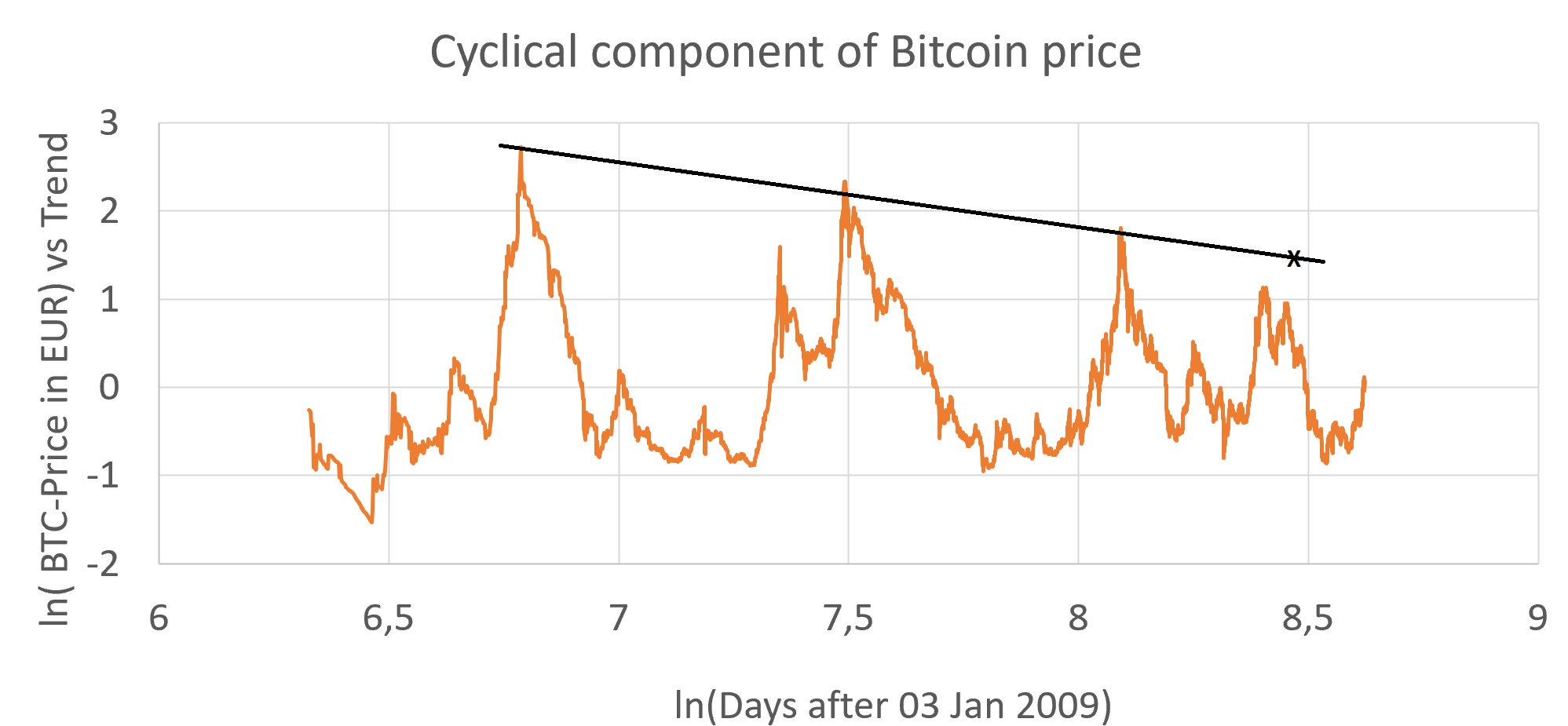 But what is the message out of it for future peaks? The "peak line" now pretends to predict the next peak more precisly, but that is just not true, as the "model" is still based on very few (=4) target points and other black swan events in both directions could occure at any time. Therefore it would be kind of missleading to my mind. If there is one weakness in the analysis of @virginorange than it is including some sort of peak or bottom area instead of letting trend line speak for itself. While the trend line is build from thousands of data points (1D close prices) there are only a few peaks or bottoms and therefore much less statistical evidence for envelope lines. But obviously everbody wants to buy the bottom and sell the peak so that the readers focus is on those bottom and peak areas instead of trend line itself.
@virginorange: this might also be a mistake in the thought process regarding the cut-off points as the backtests for buy and sell might be dominated by a few bottoms / peaks. Regarding your Backtest 2 that could exemplary mean: 1000 Days ahead -> sell 1 Peak 900 Days ahead -> sell 2 Peaks 800 Day ahead -> sell 4 Peaks -> 1st maximum 700/600 Days ahead -> sell 4 Peaks (less effective) 500 Days ahead -> sell 6 Peaks -> 2nd maximum in conclusion the prediction power of results would be very limited due to small amount of peaks.... |
|
|
|
|
clone4502
Newbie

 Offline Offline
Activity: 1
Merit: 0

|
 |
April 02, 2024, 03:27:19 PM |
|
Excellent post. Thanks!
Have you ever compared dollar-cost averaging with value-averaging?
Value average appears to work better for volatile assets like crypto.
I used the strategy to accumulate XMR with surprising results.
It is a disciplined strategy that takes the guessing out of where asset prices are trending and has you buying more as asset prices decrease and less as asset prices rise.
|
|
|
|
|
d5000
Legendary

 Offline Offline
Activity: 3892
Merit: 6140
Decentralization Maximalist

|
But what is the message out of it for future peaks? The "peak line" now pretends to predict the next peak more precisly, but that is just not true, as the "model" is still based on very few (=4) target points and other black swan events in both directions could occure at any time. Therefore it would be kind of missleading to my mind.
Thank you for your calculations, I think you have a valid point here. And in general I think to simply outperform DCA for the next few years @virginorange's model in its pure form would work even if it was slightly distorted. Taking external factors into account would mainly be useful for longer timeframes, but also could yield a slightly better performance in the mid term. But the longer a model seems to work although it is distorted, the bigger the risks that its predictions will be totally off for the next cycle. We have already an example where a model which was based on the past price history and "seemed to work fine" for years but then failed because it was distorted: Stock to Flow. People who adopted risky strategies based on the original model which predicted a 2021 peak of well over 100.000$ will very likely have suffered big losses in the 2021-2022 bear. Virginorange's model is much, much better than S2F, but the "problem" that it is only based on price history remains. The big question is of course: Is there a fundamental reason for the long term Bitcoin trend? If we assume the answer is "yes", like I wrote before assuming that the "grade of adoption" is the main factor here, then it would be useful to "isolate" this trend curve in some way. And then there is room to improve the model with such an "external effect factor". If however your answer is "no", which is also a valid assumption, then I'd go for the "pure" price history based model. Many traders/investors would disagree about this question, and that's totally fine. |
|
|
|
SilverCryptoBullet
Member
 
 Offline Offline
Activity: 82
Merit: 38

|
 |
April 03, 2024, 02:09:07 AM |
|
S2F model, DCA, Bitcoin Power Law and try to find bottom of market. If we apply all of these, we will be very confusing with the market and no longer be able to apply DCA well. Models are for every senior investors who have enough experience but with new investors, I can not understand models and DCA is my strategy. |
|
|
|
|
|
Turbartuluk
|
 |
April 03, 2024, 12:06:31 PM |
|
Virginorange's model is much, much better than S2F, but the "problem" that it is only based on price history remains.
Taking external factors into account would not solve this "problem", because you have to quantify those factors based on historical experience. This approach in 2019 would not have had a pandamic on the bucket list, or at least not within the Top10 external factors. In 2020/21 it would have been Top1, but even if you are able to quantify it's influence for 2020/21, the next black swan event will not be a pandemic and the next pandemic will be different from the last one. The big question is of course: Is there a fundamental reason for the long term Bitcoin trend?
To my mind that is not the question. Regarding that trendline, the likelihood that the relationship between Price and Date is caused by chance is close to zero. In other words: there must be some fundamental reasons. The question is what are those reasons and how to quantify them? Is it possible at all to quantify those external factors as some of them an single events with major impact? Building a model on price history is far from perfect, but at least it is a simplification we could reasonable prove right or wrong with "scientific" methodes. For me those models are like driving on the street, you need to take into account the latest data to adjust direction and stay on track. But even then a truck from the side street could slingshot you to a complete different direction. |
|
|
|
|
d5000
Legendary

 Offline Offline
Activity: 3892
Merit: 6140
Decentralization Maximalist

|
 |
April 03, 2024, 08:34:37 PM |
|
The big question is of course: Is there a fundamental reason for the long term Bitcoin trend?
To my mind that is not the question. Regarding that trendline, the likelihood that the relationship between Price and Date is caused by chance is close to zero. In other words: there must be some fundamental reasons. I think I should have written: Is there a fundamental reason outside the price history itself?The alternative would not be "chance", but that the growth's reason is related to the past price history. The price growth itself could have led to an increasing interest and thus cause a prolongation of the increasing trend (the "Bitcoin: I can get rich quick!" theory). But also the "I see there are bull-bear cycles of 4 years, thus I ride the waves" theory is such a "investment principle" without external influence which could have caused the long term trend. On the other ("a fundamental reason exists outside of price history") side, aside from the simple "adoption" theory there could be also something like "static demand surplus combined with increasingly lower supply growth" like in S2F. About more specific details of such a model I'll open a dedicated thread (as said per PM). The important thing for me is that you should be able to try several independent variables and test them empirically with a software tool. But such a model could not find the reason for every price movement, this would be too complex/next to imposssible. It's only meant to fine-tune a more general, price-history based model like virginorange's. |
|
|
|
el kaka22
Legendary

 Offline Offline
Activity: 3500
Merit: 1162
www.Crypto.Games: Multiple coins, multiple games

|
 |
April 03, 2024, 11:45:03 PM |
|
We practically can't. People failing at DCA as it is, they see it go down and instead of buying more they end up selling, hence makes it go down even more than that too, and it would not be something that could take a long time neither, should be alright. I believe that we need to learn to do DCA better and should be considering that as a normal thing as we can.
This is the most important thing, and as long as we keep doing this, it shouldn't really be living in a different kinds of world of it. I know that it is going to take a while, but we are going to get better at it with time as well, without a doubt. I hope that price will go up so that people wouldn't really end up with anything that will require any learning of it.
|
|
|
|
|
OcTradism
|
 |
April 04, 2024, 02:41:29 AM |
|
We practically can't. People failing at DCA as it is, they see it go down and instead of buying more they end up selling, hence makes it go down even more than that too, and it would not be something that could take a long time neither, should be alright. I believe that we need to learn to do DCA better and should be considering that as a normal thing as we can.
DCA is a famous investment strategy and it's more easily to talk about it than actually practice it with our money. It's more easier to say that "I am planning to do DCA with Bitcoin" than actually spending money regularly to purchase Bitcoin. First barrier is our failure to assign our money for DCA. Second barrier is our failure to maintain our belief in Bitcoin and control our emotion and psychology in the volatile market. DCA strategy is helpful to avoid effects from emotion and psychology but in practice, not all people can avoid fear when market is bad and do their DCA plan. People who are fearful will need to look at Michael Saylor and MicroStrategy as example of DCA. They have been doing DCA since 2020 and they are winning big. |
| | | .
.Duelbits. | | | █▀▀▀▀▀
█
█
█
█
█
█
█
█
█
█
█
█▄▄▄▄▄ | TRY OUR
NEW UNIQUE
GAMES! | | .
..DICE... | ███████████████████████████████
███▀▀ ▀▀███
███ ▄▄▄▄ ▄▄▄▄ ███
███ ██████ ██████ ███
███ ▀████▀ ▀████▀ ███
███ ███
███ ███
███ ███
███ ▄████▄ ▄████▄ ███
███ ██████ ██████ ███
███ ▀▀▀▀ ▀▀▀▀ ███
███▄▄ ▄▄███
███████████████████████████████ | .
.MINES. | ███████████████████████████████
████████████████████████▄▀▄████
██████████████▀▄▄▄▀█████▄▀▄████
████████████▀ █████▄▀████ █████
██████████ █████▄▀▀▄██████
███████▀ ▀████████████
█████▀ ▀██████████
█████ ██████████
████▌ ▐█████████
█████ ██████████
██████▄ ▄███████████
████████▄▄ ▄▄█████████████
███████████████████████████████ | .
.PLINKO. | ███████████████████████████████
█████████▀▀▀ ▀▀▀█████████
██████▀ ▄▄███ ███ ▀██████
█████ ▄▀▀ █████
████ ▀ ████
███ ███
███ ███
███ ███
████ ████
█████ █████
██████▄ ▄██████
█████████▄▄▄ ▄▄▄█████████
███████████████████████████████ | 10,000x
MULTIPLIER | │ | NEARLY UP TO
.50%. REWARDS | | | ▀▀▀▀▀█
█
█
█
█
█
█
█
█
█
█
█
▄▄▄▄▄█ |
|
|
|
|
virginorange (OP)
|
 |
April 08, 2024, 03:03:24 PM
Last edit: April 08, 2024, 05:07:58 PM by virginorange Merited by Turbartuluk (10) |
|
[3. Entry Price vs. Trend graphic
-> regarding the cloud of blue dots it might be possible to separate dataset into 3-4 parts (coresponding full cycles) and use different colours for the dots and regression lines
-> maybe some trend will show up (regarding hight or incline)
Thanks for your improvement proposals Tubabuluk, I will start with #3 and shine a bit more light on the cloud of blue dots. TL;DR: Bitcoin is slightly overvalued, but it is still a good time to buy Bitcoin.
Predicting [1 year Bitcoin yield] depending on [the current cycle (measured in % overvaluation)]x-axsis shows how much the historical Bitcoin price exceeded its trend (right = expensive, left = cheap). y-axsis shows how the yield the following 12 months (high = Bitcoin gains vs. EUR, low = Bitcoin looses vs. EUR)  What do we learn? What do we learn?1.) We can see that the red lines have a declining slope. You get better 1-year forward returns by buying bitcoin cheaply. This makes sense as the mean of the cycle reverses around the trend. It is still interesting to see this result on a time horizon of only 12 months, not 2 or 4 years. 1st orange arrow2.) We can see that the red line (2010-2013) is the highest, the red line (2014-2017) is lower, the red line (2018-2021) is even slightly lower and the last line (2022-March 2023) is even lower. As time goes on, you can expect less return on your bitcoin investment for the same level of overvaluation relative to the trend. This makes sense as the price trend of bitcoin flattens out. 2nd orange arrow3.) We can see the red lines crossing the x-axis at lower and lower values. 2nd orange arrow 2010-2013 we cross at 1.5, 2014-2021 at 0.6 and recently at 0. Buying relatively expensive bitcoin (trend +0 to trend +1.5) in 2010-2013 still gave you positive returns, recently buying only slightly expensive bitcoin gave you negative returns. 3rd blue arrow4.) In our four charts we see 2 grey lines. We can see 2 different trend lines for each 4y cycle. One trend is on the way to the top. The second trend is on the way from the top to the bottom. Obviously you can get a better return the way up vs. on the way down. Unfortunately, it is only partly tradable:  Falling from the green peaks, we could assume that we are on the way down. Excessive overvaluation can be traded. At the yellow tops, however, we could have assume in real time that we were still climbing to a green top. Only in hindsight we would have realized we missed the yellow top. Since we can't tell the yellow tops in real time moderate overvaluation is not tradable. Looking at our most recent dot plot, we can see that the red line crosses 0/0. Does only the cycle matter now? Bitcoin price trend growth is declining. Maybe it is declining much quicker than the cycle? Is trading the Bitcoin cycle more important than holding Bitcoin? The answer is no. 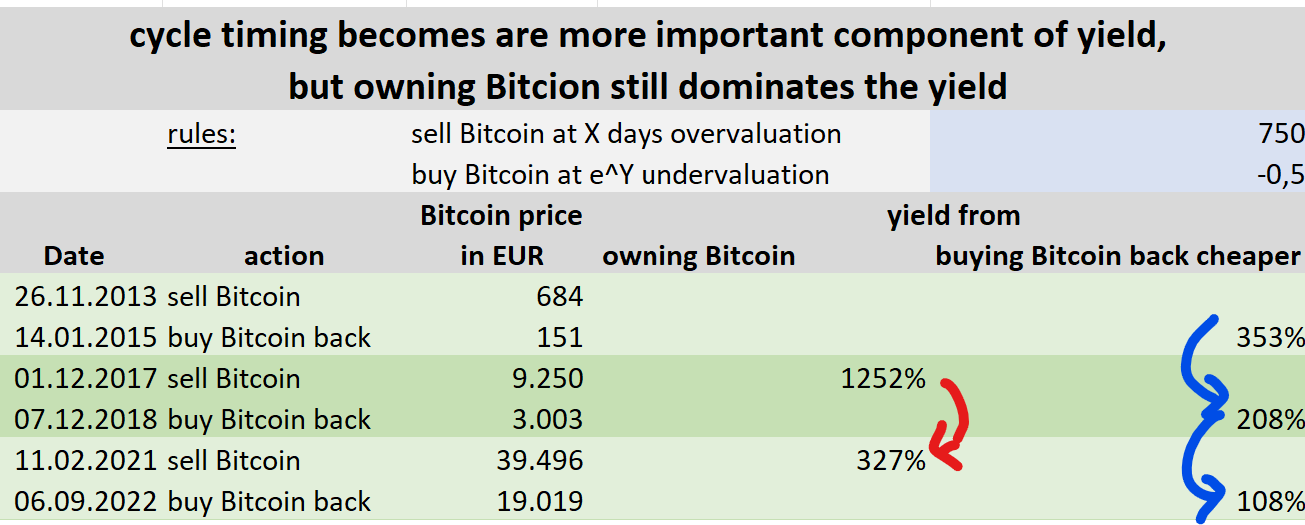 It is true that the yield from owning Bitcoin (red arrow) declines faster (from 1200% to 300%) than the yield from trading the cycle (blue arrow, 350% to 200% to 100%) and therefore the cycle matters relatively more. However the return from just holding Bitcoin is still much higher than the yield from timing the Bitcoin cycle. The main take away is: trading the cycle can juice your returns, but the most imposant decision is buying Bitcoin at all. The red line crosses 0/0, not because the cycle dominates the returns, but because it represents a bear market. Therefore the line is naturally lower than a bull market line (see: what can we learn #4, the two grey lines).
Predicting [1 year change in Bitcoin cycle] depending on [the current cycle (measured in % overvaluation)]x-axsis shows how much the historical Bitcoin price exceeded its trend (right = expensive, left = cheap). y-axsis shows how the yield the following 12 months (positive = Bitcoin price growth exceeds trend, negative = Bitcoin price growth is slower than trend) 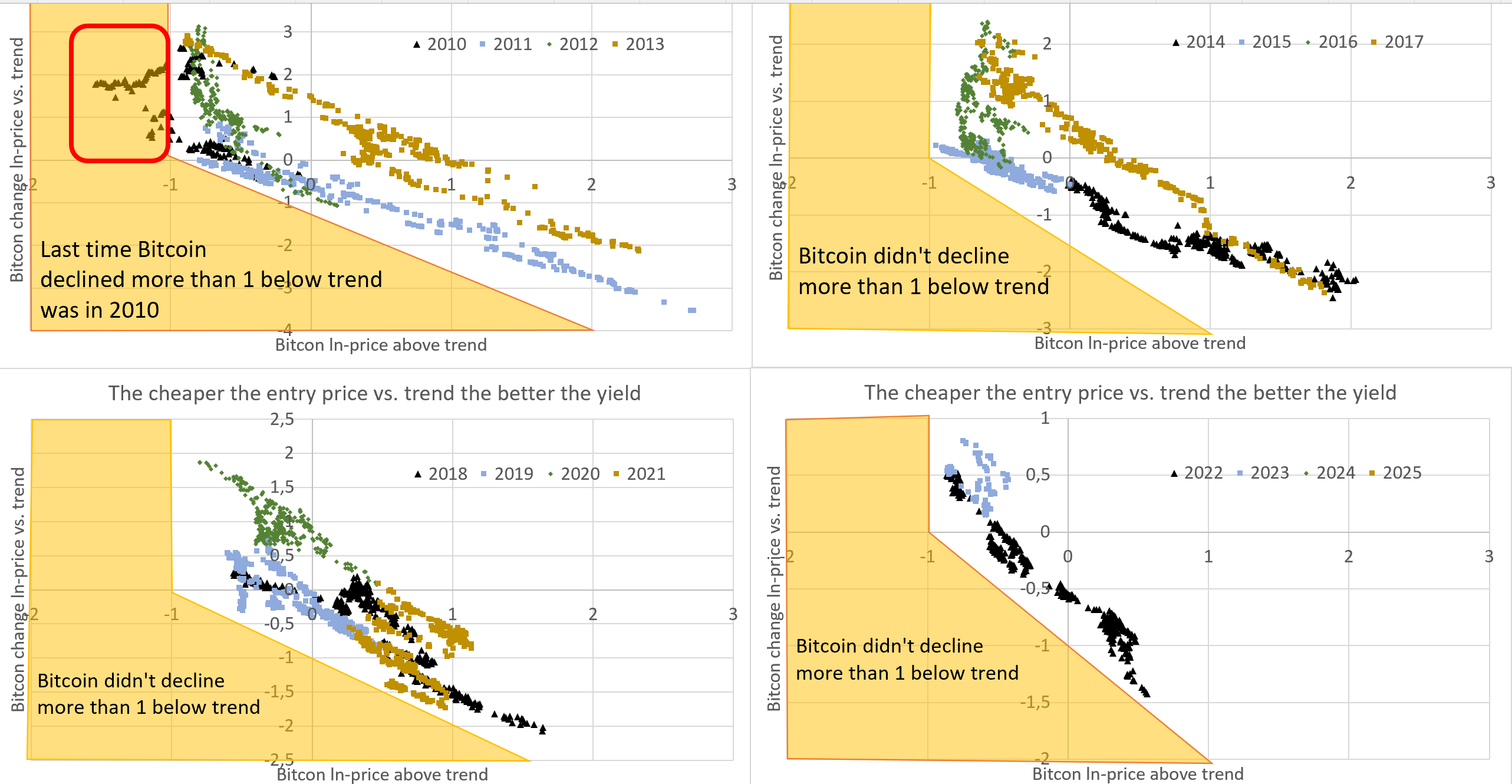 What do we learn? What do we learn?1.) We see a clear mean reversion in the Bitcoin trend with the dot-plots now sitting crossing 0/0 on average. Cyclically cheap Bitcoin becomes more expensive after 12 months. Cyclically expensive Bitcoin becomes cheaper after 12 months. 2.) I marked the area of 1 below trend (e-1 = 0,37*trend = 63% below trend) in orange. The last time we touched the orange area was in 2010 (red box). This information is slightly usefull to project future returns and future drawdowns. What does the dotplot tell us about the current Bitcoin market? Bitcoin (currently at 64.500€) vs. trend (currently at 60.500€) is slightly overvalued. The slight overvaluation is represented by the green line at x>0. We didn't go below -1 (currently at 22.250€) since 2010. So a drawdown to less than 22.500€ is reasonably unlikely (<8%). If we get a severe drawdown, I would expect a price of -0.8 (currently at 27.000€). What kind of valuation would be realistic 12 months from now?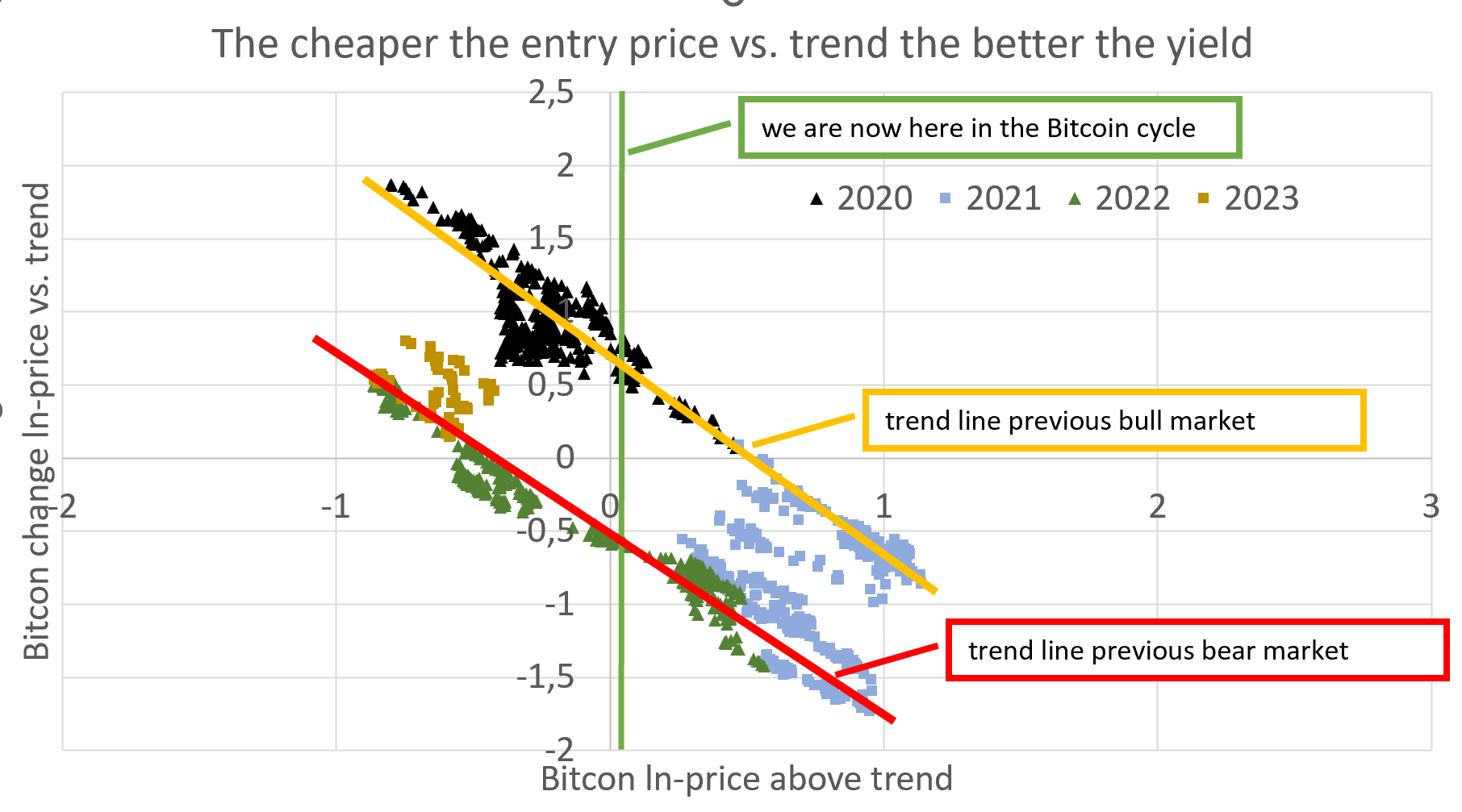 The orange trend line shows for a given historical bitcoin valuation: "How did the Bitcoin price change after 12 months during the last bull market?" The red trend line shows, for a given historical bitcoin valuation: "How did the bitcoin price change after 12 months during the last bear market?" The green line shows the current valuation of bitcoin. Price projection for a bull market (probability = 50%):The intersection of orange and green is +0,6. Bitcoin is now at trend+0,065. So during a bull market, I would expect Bitocoin to go to trend+0,665. Trend in one year will rise to 87.700€. Trend+0,665 will be at 170.000€. This would be roughly in line with our previous result for taking profits at trend+750 days (175.000€). Price projection for a bear market (probability = 42%):The intersection of orange and green is -0,6. Bitcoin is now at trend+0,065. So during a bear market, I would expect Bitocoin to go to trend-0,535. Trend in one year will rise to 87.700€. Trend-0,535 will be at 51.000€. This would be roughly in line with our previous result for going all in trend-0,5 (53.000€). Price projection for model break (probability = 8%):If my model breaks, I would assume Bitcoin to be at trend-2 (12.000€). Expected value of Bitcoin in one year = 8%*12k + 42%*53k + 50%*174k = 110k. Sounds too good to be true. The relationship between bitcoin's overvaluation and the expected return (orange line) from the past bull market is probably a bit optimistic, as the trend and cycle flatten over time. However, as long as bitcoin continues to get adopted, the strong growth in the trend price makes investing in bitcoin still very attractive. However, we should not take it for granted that we are now in a bull market:  Maybe we are on the way to a new green top. Maybe we just get a yellow top and a big contraction until we get to the next green top. Don't invest more than you can stomach during a drawdown.
Predicting [1 year Bitcoin yield] depending on [the current cycle (measured in days overvaluation)]x-axsis shows how much the historical Bitcoin price exceeded its trend measured in days (right = expensive, left = cheap). y-axsis shows how the yield the following 12 months (high = Bitcoin gains vs. EUR, low = Bitcoin looses vs. EUR) 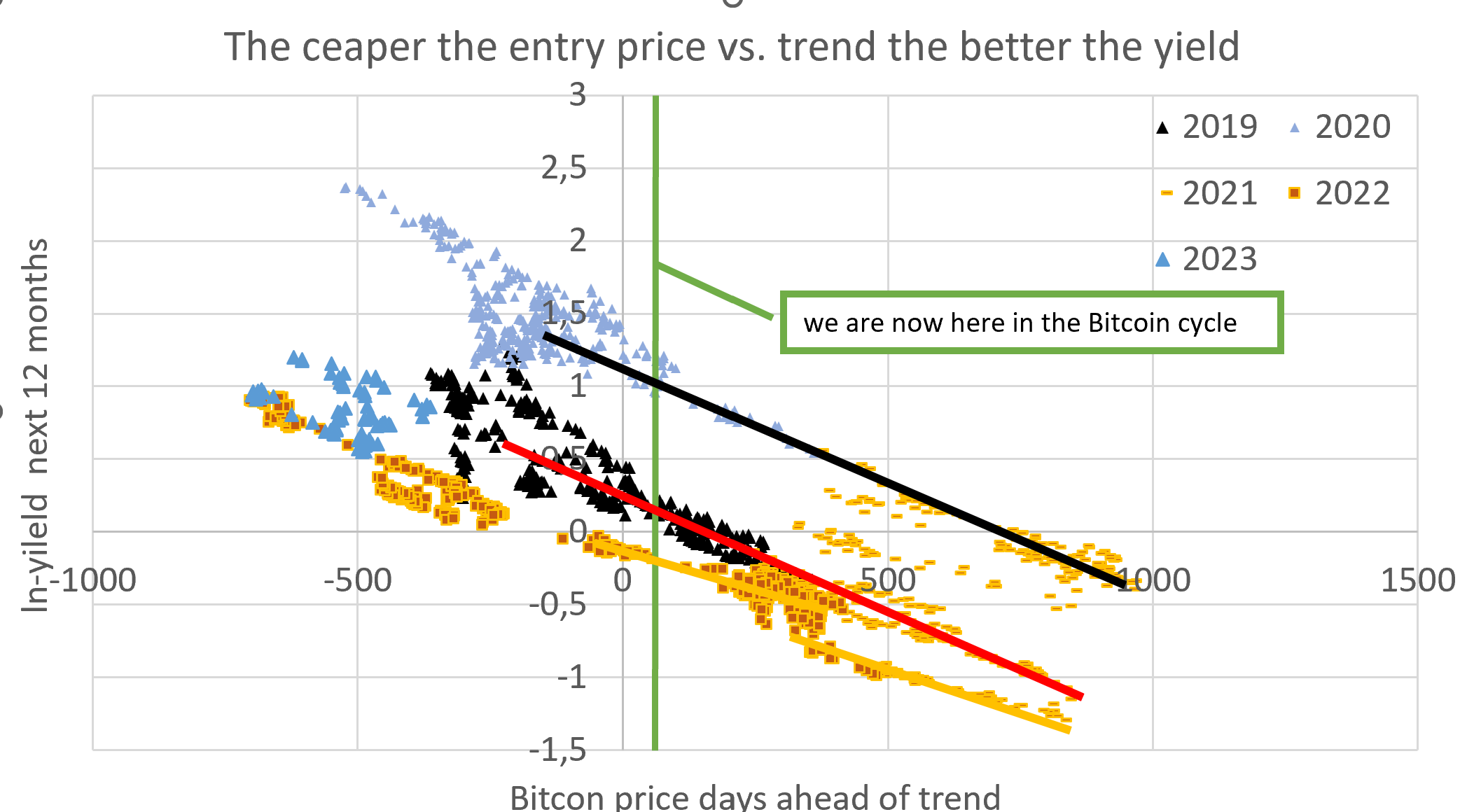 I think 2020 ( black line) is too optimisitc, since we were heading out of Corona with a massive monetary stimulus and the trend line tends to go down anyway each cycle. I think 2022 ( yellow line) is too pessimistic. Maybe 2019 is reasonable ( red line). Here we would expect a yield of e^0,2 which is 22%. This price prediction +22% (days overvaluation and 2019 scenario) is less optimistic than my previous prediction >+50% (expected value, % overvaluation). In both calculations however it pays out to buy Bitcoin now, since the expected return of Bitcoin exceeds my cost of capital (around 6-10%). It is not too late to buy Bitcoin yet.When would the expected return on Bitcoin over the next 12 months fall below my cost of capital?When the Bitcoin price exceeds trend+106 days (currently $68k, at 10% cost of capital) or trend+127 days (currently $70k, at 6% cost of capital), buying Bitcoin on a 12-month time horizon would no longer make sense. However, it could still make sense to buy Bitcoin on a shorter time horizon (selling into the bubble) or on a longer time horizon (riding the adoption trend). In general, I would stick to my overvaluation threshold of trend+750 days. However, I would scale back by buying at trend+150 days to buy more Bitcoin at e^-1*trend. |
Sicherheit für deine Familie, dich und deine BTC, dank der fundierten Sicherheits-Tipps der KryptoArche. Wir kaufen Bitcoin zum Vermögensaufbau oder zur Krisenvorsorge. Wir kaufen Bitcoin dezentral als Schutz vor Räubern, mit guter Historie und verwahren unsere Bitcoin sicher vor Verlust, Räubern und Dieben sowie versteckt Wir nutzen sichere Passwörter, Betriebssysteme, Software und sufen sicher. Sicher dir deinen kostenlosen Platz auf der KryptoArche! Die Zeit läuft ab! Steig ein, bevor es zu spät ist! Gemeinsam bleiben wir immer über Wasser!
|
|
|
|
virginorange (OP)
|
 |
April 08, 2024, 06:50:27 PM
Last edit: April 09, 2024, 01:14:59 PM by virginorange |
|
1. Formula y = 5,8323x - 39,296-> I guess you have done some kind of logarithmic Regression like Trolololo did it once-> therefore i guess the formula will be outdated with the years going and it would be helpful to reference the way of calculations You are correct, as new data points arrive the formula will see minor changes. The formula is created with a simple least squares linear regression in excel. y = ln(Bitcoinprice_in_EUR) and x = ln(number of days since the Bitcoin genesis block) = ln(Date - 03 Jan 2009). We will see a new change in trend quite late, since most of the old data still supports the trend. Therefore we have to check the trend for the new data only, which I did in " Checking the stability of the bitcoin trend line" in my initial post. Ultimately we will see a weaker trend as adoption finalises 2. "Cyclical Component of Bitcoin price" graphics
-> due to logarithmic timeline it's somehow difficult to assign the peaks/years
-> maybe vertical halving-lines or labeling the peaks with year count could help as a guideline
Thanks for your feedback. I added one more chart to my initial post to translate our ln-values into values we can understand. Making the graphs easier to followA Bitcoin price in ln(EUR) and a Bitcoin age in ln(days) is easy to draw, but difficult to understand. Therefore I added the Bitcoin price in EUR and the calendar year.  |
Sicherheit für deine Familie, dich und deine BTC, dank der fundierten Sicherheits-Tipps der KryptoArche. Wir kaufen Bitcoin zum Vermögensaufbau oder zur Krisenvorsorge. Wir kaufen Bitcoin dezentral als Schutz vor Räubern, mit guter Historie und verwahren unsere Bitcoin sicher vor Verlust, Räubern und Dieben sowie versteckt Wir nutzen sichere Passwörter, Betriebssysteme, Software und sufen sicher. Sicher dir deinen kostenlosen Platz auf der KryptoArche! Die Zeit läuft ab! Steig ein, bevor es zu spät ist! Gemeinsam bleiben wir immer über Wasser!
|
|
|
|
Turbartuluk
|
 |
April 09, 2024, 10:17:04 AM
Last edit: April 09, 2024, 01:51:58 PM by Turbartuluk Merited by virginorange (7), d5000 (2) |
|
Thank you very much for digging even deeper. It takes me some time to assume the scope of results. As i have a slightly different interpretation of past data, i will share what i do see on those pictures starting with the latest data (last 4 years): 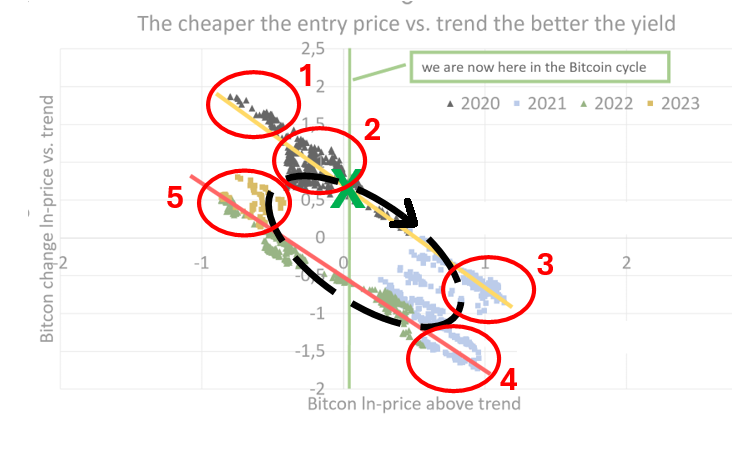 Black line: First of all you can see clearly some sort of cycle within the last 4 years, with the direction shown in the graphic Red 1: Bought in Corona Dip 2020, sold in 1st Peak 2021, i expect this area to be outliers which will not repeat Red 2: Bought after Bottom 10k+, sold in 2nd Peak 2021 Red 3: Bought in 1st Peak 2021, sold 1 year after Red 4: Bought in 2nd Peak 2021, sold 1 year after Red 5: Bought 1y+ before now, latest data Green X: possible cycle position right now, 1y ahead of latest dots If cycle repeats (big if) and Green X is assumed correctly you could draw following conclusions from that: - there are only shown buying points 1y+ in the past, with time passing new dark yellow dots will occure, they might occure in direction from Red 5 to Red 1. This would mean, that BTC bought <1y in the past from now will show hightest increase -> Peak can be assumed within the next year.
- BTC bought today and sold 1y from now could be slightly after the peak, not optimal but still in good profit
- starting DCA BTC for the next 6-12 month and selling 1y after (18-24M from now) seems to be a bad idea, in conclusion it could be a good idea to execute a withdrawal plan during that time, but be aware of ln-price scale -> choose a backloaded layout for DCA
- roughly ln-price +0,5 above price trend (i guess we will see that in a few months from now) you enter bubble territory, buying BTC and selling 1y after could result in massive losses, you could use that prediction for hedge or short strategies
- for identifiing peak you could use 2 different indicators: BTC change ln-price +1 (~250% within 1year) which equals red 2 or ln-price +0,5-1 above trend which equals red 3/4
Now here is why i don't believe Green X to be assumed correcly:Predicting [1 year Bitcoin yield] depending on [the current cycle (measured in % overvaluation)]x-axsis shows how much the historical Bitcoin price exceeded its trend (right = expensive, left = cheap). y-axsis shows how the yield the following 12 months (high = Bitcoin gains vs. EUR, low = Bitcoin looses vs. EUR)  If you focus on the red lines on those 4 pictures described by y=a*x+b you can see a decreasing trend for incline a and offset b. Additionaly the clouds of dots are more and more concentrated in the center. Regarding all 3 trends together i would rather not expect a "clear" elliptic cycle but more some sort of twisted elliptical spiral, slipped from the center. 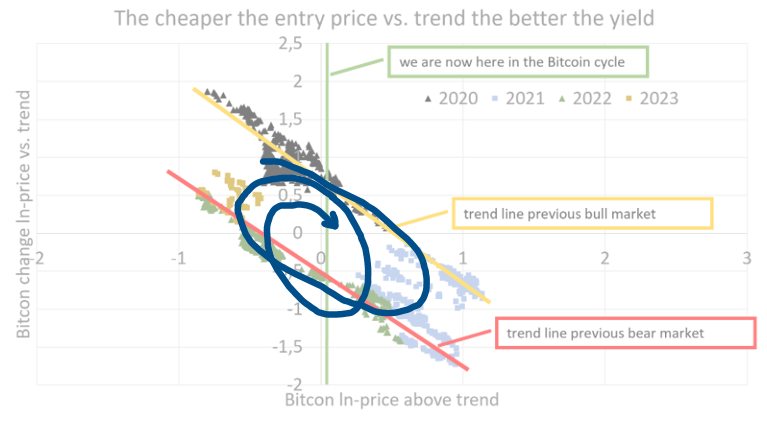 Idea: Idea: We could plot all years from 2010-2023 into 1 high resolution graphic, while having 1 colour each year. For each year the center of gravity could be calculated, to draw a spline through those coordinates. (You could calculate coordinates with excel, i could draw spline with CAD tools) I would be curious if this spline results in a picture like the Bitcoin Spiral  Maybe this could be even used somehow for cut-offs?!  PS: please lets stay with ln price model instead of days ahead model, i guess it will make things easier to compare bull and bear in the same graphic. |
|
|
|
|
|
bettercrypto
|
 |
April 09, 2024, 02:00:46 PM |
|
Now all of us who believe in Bitcoin or cryptocurrency know that it will make a great contribution to our investors who believe in Bitcoin or cryptocurrency. And even now,
there are many communities that use and believe in the DCA method; that's just, honestly speaking.
So thank you very much to Op, and he made that matter to be shared here in this forum section for the awareness of all the members here on this platform.
|
|
|
|
|
virginorange (OP)
|
TL;DR: With a time horizon of 9-12 months I expect Bitcoin's trend price growth to continue (95% probability) plus a cyclical price expansion on top (80% probability). If you want to buy Bitcoin anyway, my model would suggest you don't wait. If you want to sell Bitcoin anyway, my model would suggest you to wait at least a couple of months.* Please consider models can be wrong. *Obviously not finical advise. Only a profession certified advisor can judge your personal situation. He might find a long term bank deposit yielding treasury yield - 200 basis points more suitable to you. Especially considering the excellent long term fiscal situation in the US.Question: Why did Bitcoin perform so well in summer 2019?Idea: We could plot all years from 2010-2023 into 1 high resolution graphic, while having 1 colour each year.
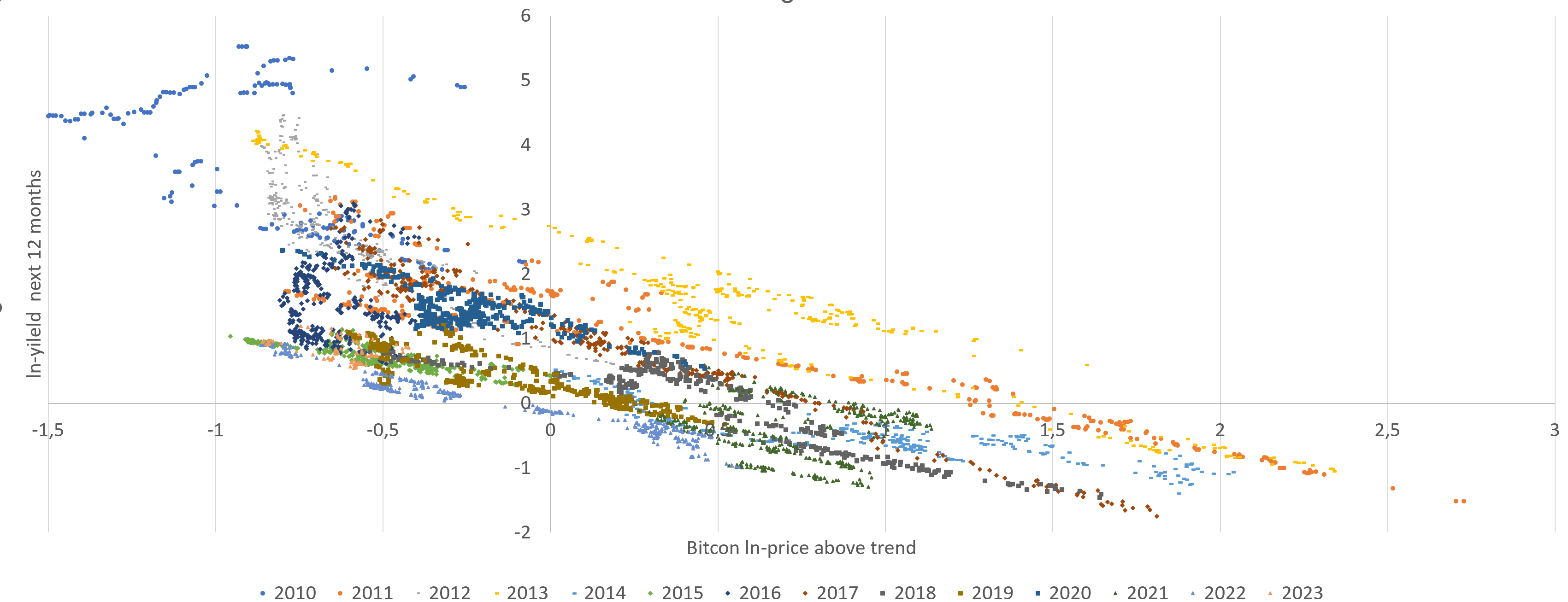 For each year the center of gravity could be calculated, to draw a spline through those coordinates. (You could calculate coordinates with excel, i could draw spline with CAD tools) I would be curious if this spline results in a picture like the Bitcoin Spiral  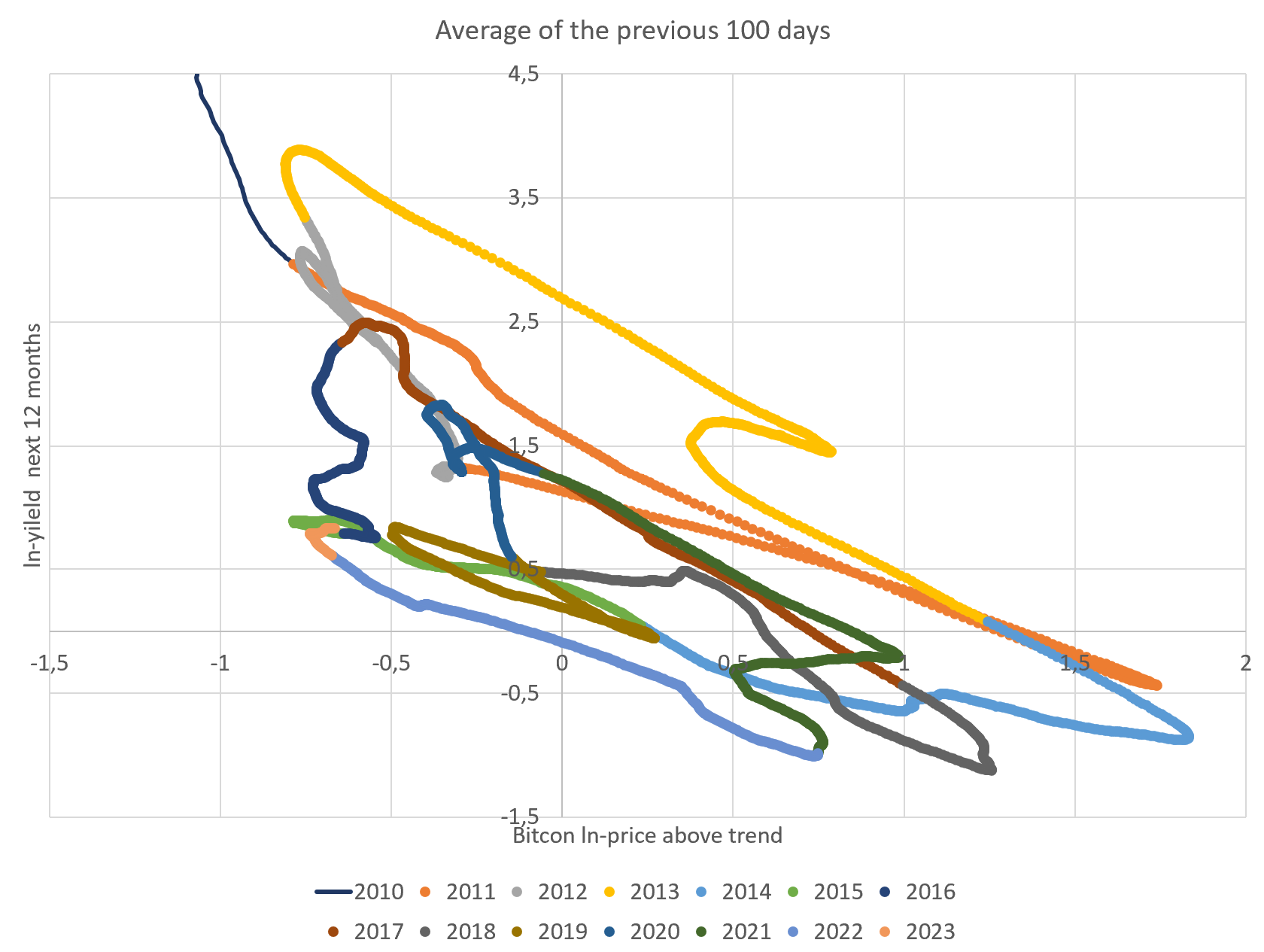 The center of gravity looks a bit unordely. Therefore I put only a couple of years into each chart:  We can see circles (= cycles of overvaluation and undervaluation) becoming smaller (= volatility declining as times goes on) and moving down (price trend growth is slowing down). To make our picture more clear, we can adjust for the "moving down" of our circles. Instead of an y-axis showing the [ln-yield of being invested into Bitcoin for 12 months] we can plot on the y-axis the [over or undervaluation vs. trend in 12 months]. Here we should circle around 0/0.  Looks unorderly. So let's go year by year: 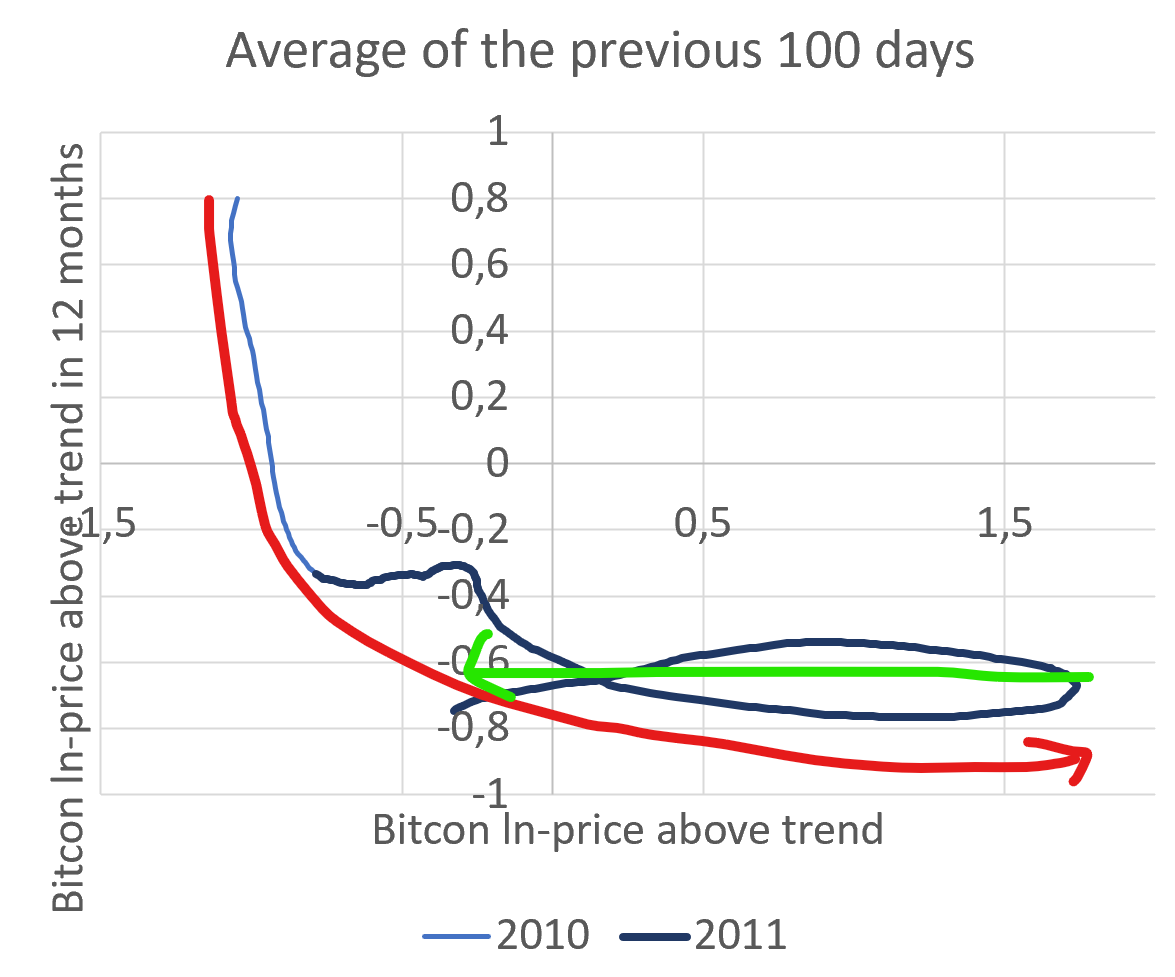 2010 and H1-2011 we were just getting started. Our cycle was spinning in the opposite direction (red arrow). In H2-2011 we started spinning in the usual direction. 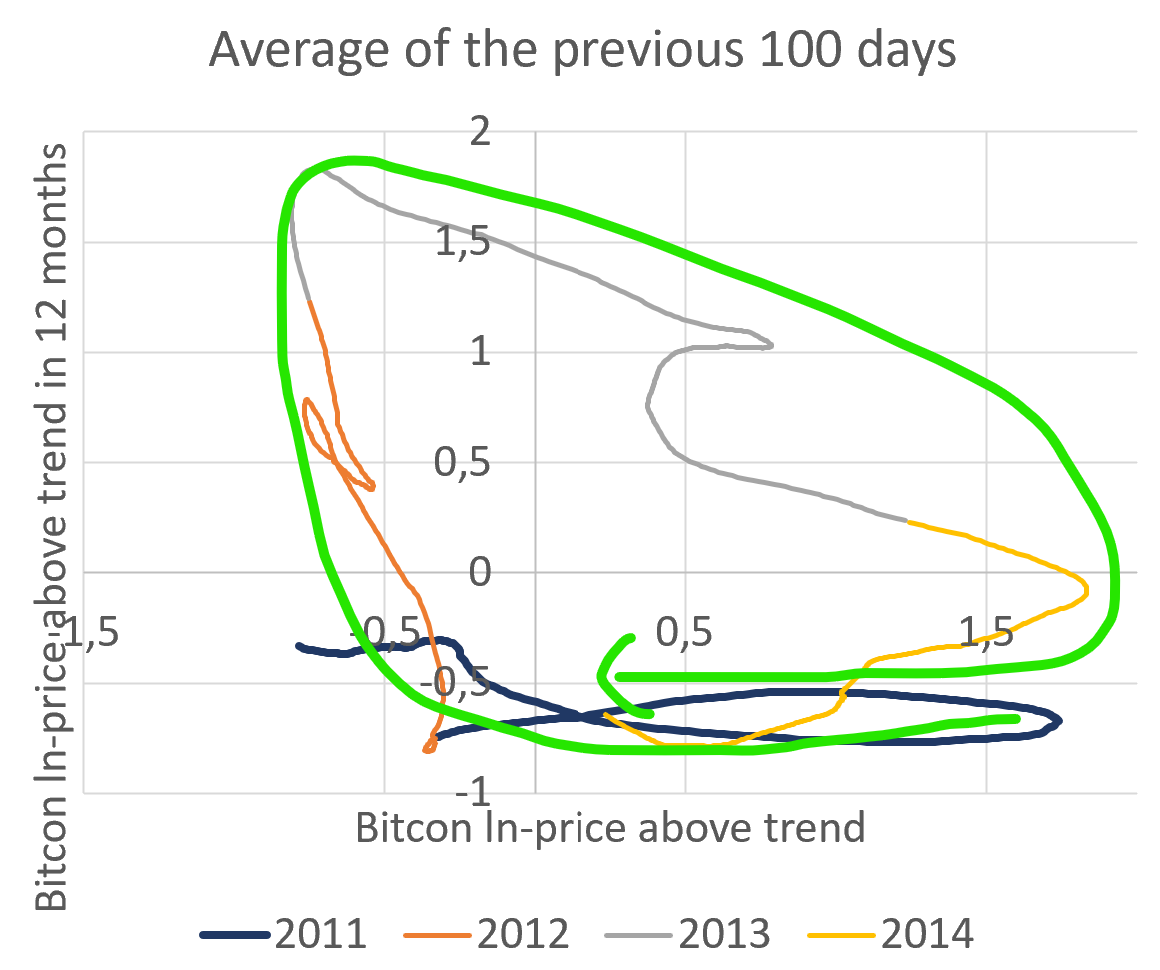 H2-2011 to 2014 we kept spinning a full circle. 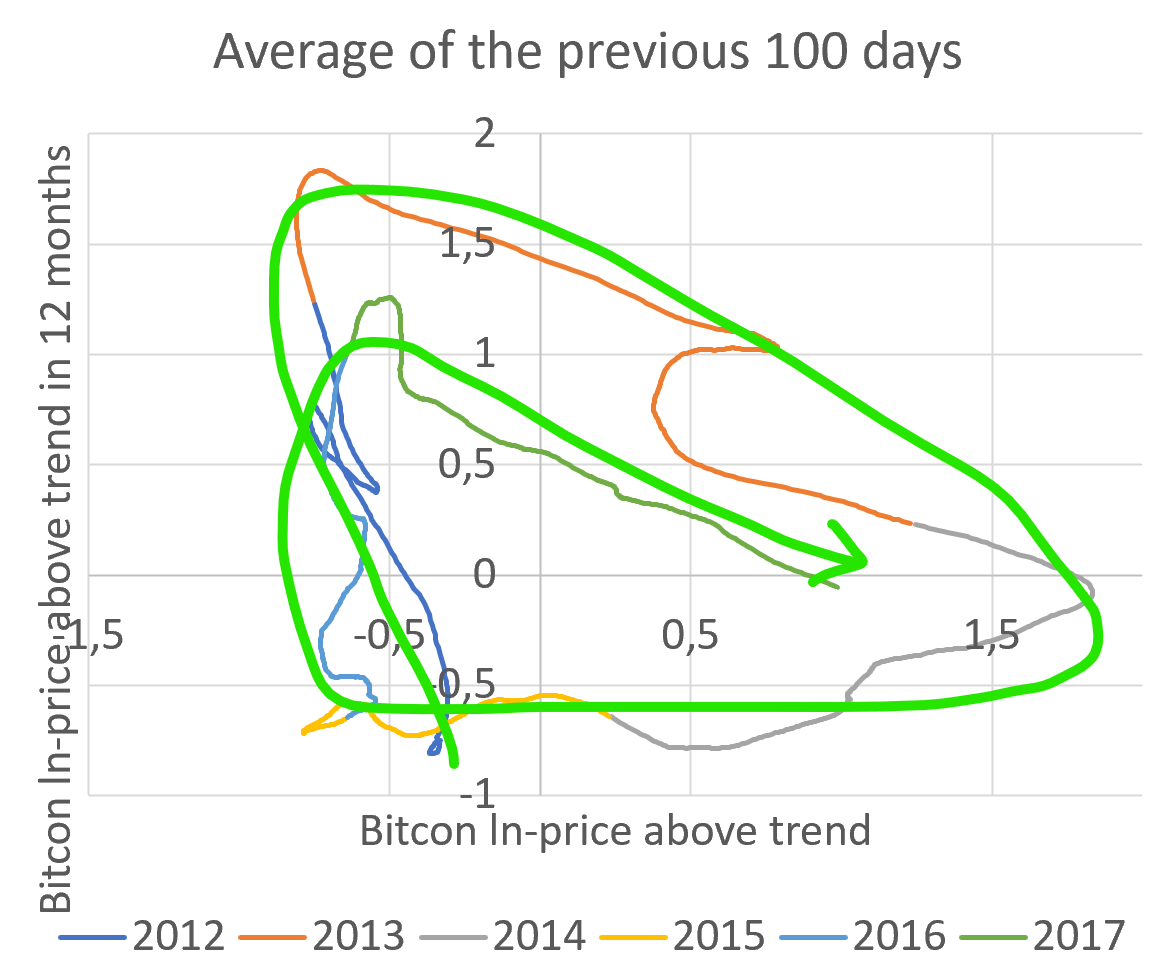 Until 2017 we keppt spinning an extra 1/2 circle. However this 2nd circle was smaller, which means lower excess valuation and lower volatility. 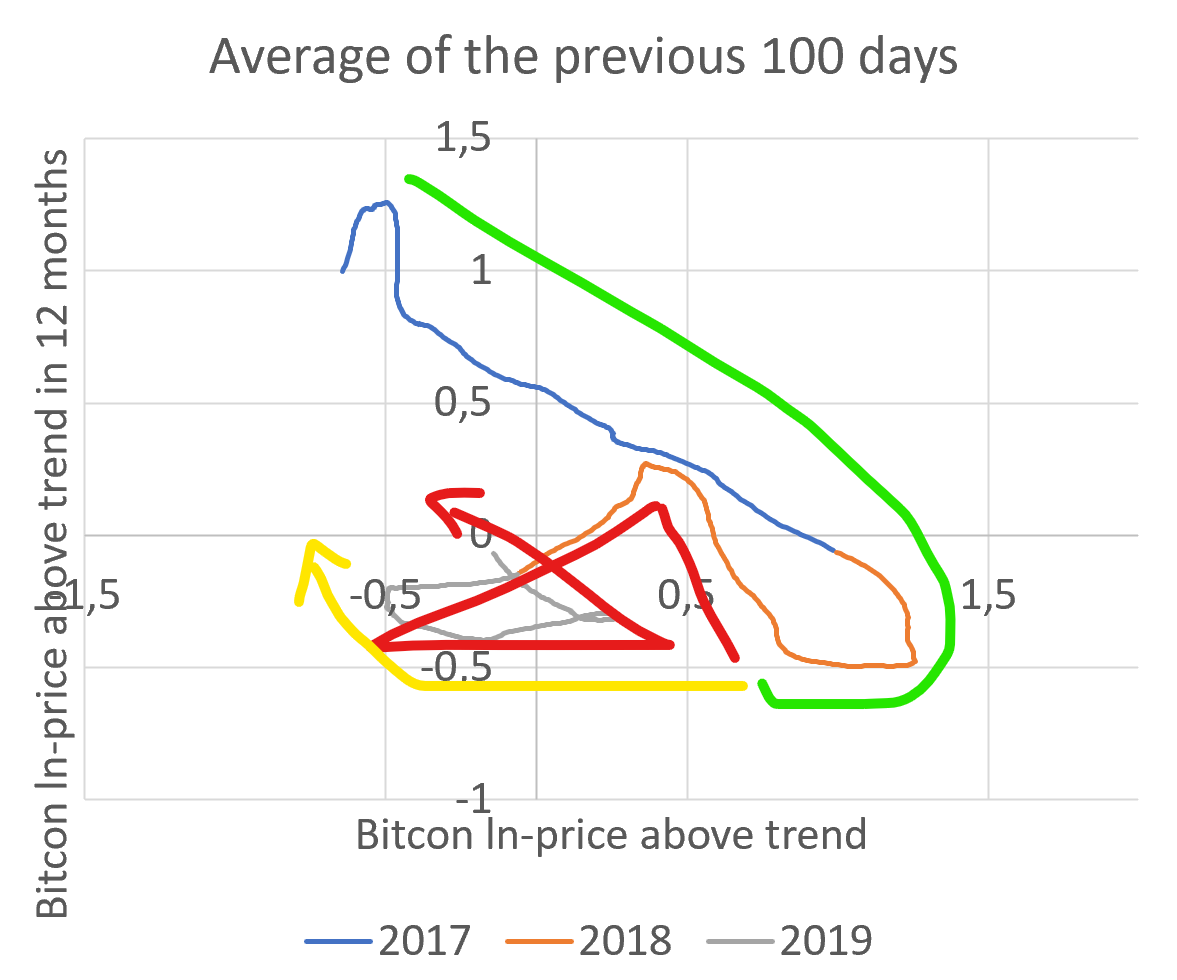 2018 and 2019 were unusual years. Generally we would expect our cycle to keep spinning (after the green arrow we should continue with the yellow arrow). However 2018 we saw an unusual high. And 2019 we made a smaller circle.  2018 we saw an unusual 12m-performance, due to an unusual 2019 hight, which was between two cycle tops (2017 and 2021). 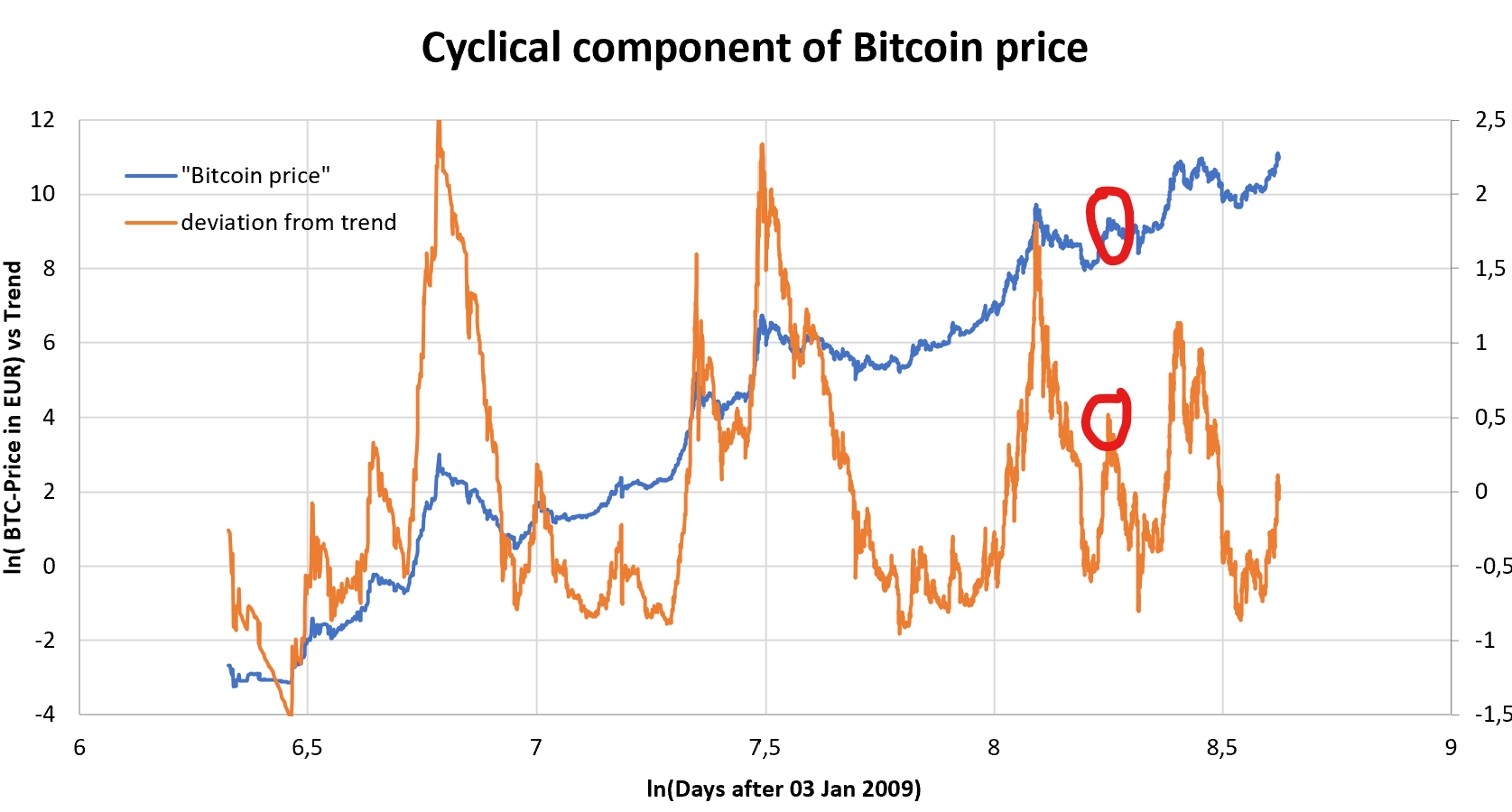 Our 2019 anomaly was the highest top, within our small (yellow) tops.  The confused behavior in 2019 is down to covid 19.  After 2020 our spinning looks more regular again:  Lessons: We spin clockwise, with the exception of 2010 to H1-2021, but we have some disturbances (2018). Therefore it is more than 50% probable (my guess 80%) we continue to spin clockwise for the near future. The 20% probability for a disturbance would be some kind of macroeconomic shock, which is unlikely before the US-election. 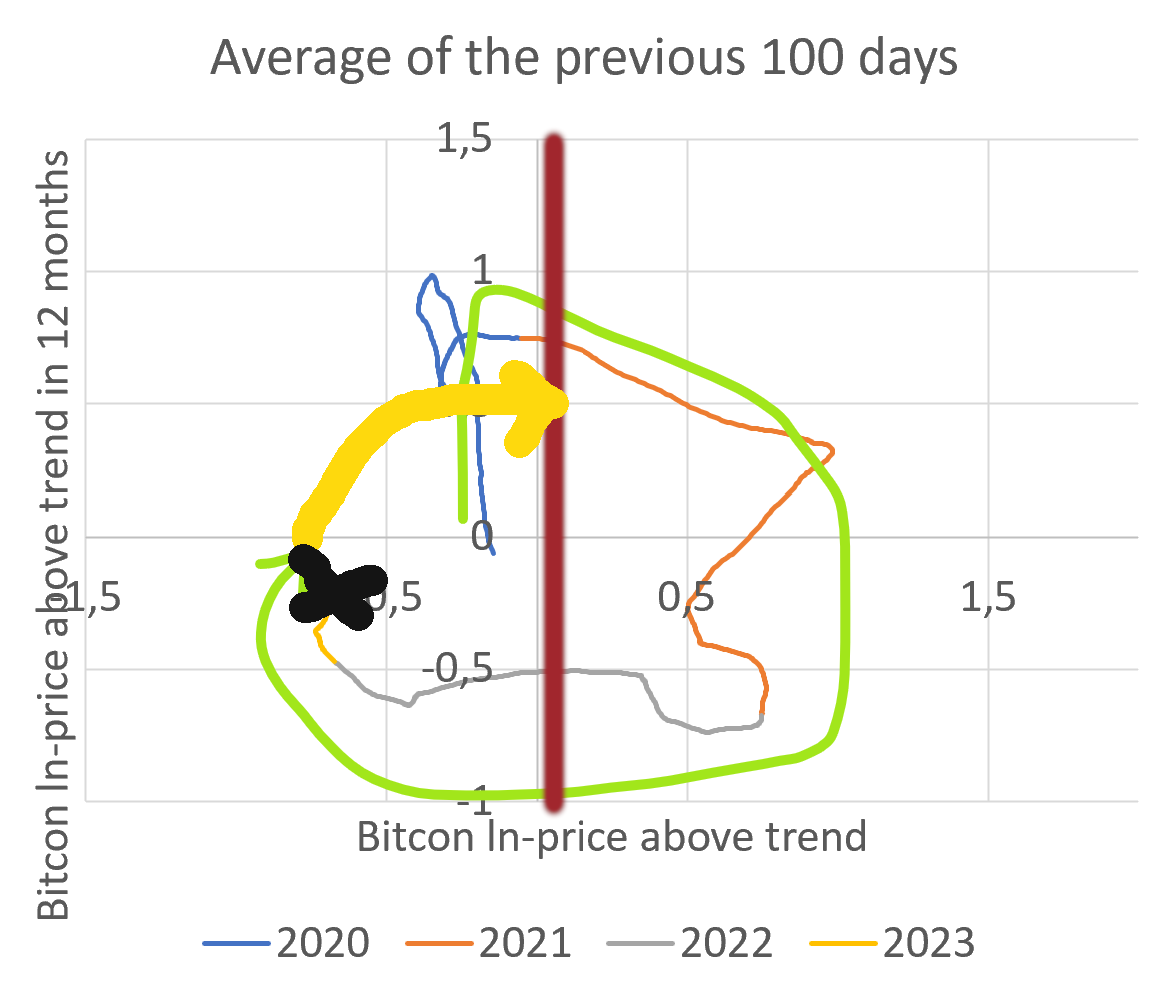 The last full data point (average of 100 days until 31st March 2023) with historical valuation data and 12m-forward return is market as black X. Today we are somewhere at the red line, since we now the current overvaluation, but we don't know the 12 month forward return 9th of April 2024 - 9th of April 2025. We also can be pretty sure we keep spinning, not only because we kept spinning in the past, but also given the Bitcoin price performance in the last 12 months the yellow arrow looks likely. We can also assume the current circle is smaller than the last circle (probably we will be below the 2021 line). My weak best guess would be, after a current overvaluation of 0,1 we will go to an overvaluation of 0,4 in 12 months. I'm a bit more confident (80%) that we will have a higher overvaluation in 12 months than now. Theas means we can earn Bitcoins trend price growth plus a cyclical price expansion. Please be aware, that we are dealing with 100 day averages here, so today + 256 to today + 356 days.
|
Sicherheit für deine Familie, dich und deine BTC, dank der fundierten Sicherheits-Tipps der KryptoArche. Wir kaufen Bitcoin zum Vermögensaufbau oder zur Krisenvorsorge. Wir kaufen Bitcoin dezentral als Schutz vor Räubern, mit guter Historie und verwahren unsere Bitcoin sicher vor Verlust, Räubern und Dieben sowie versteckt Wir nutzen sichere Passwörter, Betriebssysteme, Software und sufen sicher. Sicher dir deinen kostenlosen Platz auf der KryptoArche! Die Zeit läuft ab! Steig ein, bevor es zu spät ist! Gemeinsam bleiben wir immer über Wasser!
|
|
|
|
Turbartuluk
|
 |
April 12, 2024, 06:41:19 AM
Last edit: April 12, 2024, 08:21:36 AM by Turbartuluk |
|
Question: Why did Bitcoin perform so well in summer 2019?
Good question. That might be something @d5000 could help us to find an answer. We can see circles (= cycles of overvaluation and undervaluation) becoming smaller (= volatility declining as times goes on) and moving down (price trend growth is slowing down).
Good idea to use SMA100 for drawing lines. I guess we could even go up to SMA200 for some more smoothing of lines. Maybe shrinkage of circles would then be clearer (=more pedictable?) Regarding the "moving down" this should correspond to moving down of trendline. I asked myself if Center from past cycles would be around 0/0 if you also take a past cycle trendline (not including the latest price data for Regression of Trend line). This could mean that a Trend towards -0,5 or -1 from current trendline would be plausible... We can also assume the current circle is smaller than the last circle (probably we will be below the 2021 line). My weak best guess would be, after a current overvaluation of 0,1 we will go to an overvaluation of 0,4 in 12 months. I'm a bit more confident (80%) that we will have a higher overvaluation in 12 months than now. Theas means we can earn Bitcoins trend price growth plus a cyclical price expansion. Please be aware, that we are dealing with 100 day averages here, so today + 256 to today + 356 days.
Regarding the graphics i am a little more optimistic. I guess i would set up my sell area rougly 0,5-0,75 above Trend (maybe in combination with price +200-250% within 1y). To translate that into prices: Trend line will be at 80k€ by the end of 2024.
e^0,4 above would mean ~120k€/130k$
e^0,5-0,75 above would mean ~130-170k€/145-190k$ Regarding the avarages i guess you mean today +365-465 days?! What do you think about using Monte-Carlo price simulation in Excel to close that gap and find a more precise X-Position for today?! |
|
|
|
|
|
virginorange (OP)
|
 |
April 12, 2024, 01:33:18 PM |
|
Regarding the graphics i am a little more optimistic. I guess i would set up my sell area rougly 0,5-0,75 above Trend (maybe in combination with price +200-250% within 1y).
To translate that into prices: Trend line will be at 80k€ by the end of 2024.
e^0,4 above would mean ~120k€/130k$
e^0,5-0,75 above would mean ~130-170k€/145-190k$
I agree, the model suggest trend at 80k€ at the end of 2024. My personal definition for "good time to sell" is a Bitcoinprice 750 days ahead of trend, which would be at 160k€ by then. A valuation of 200k€ would be pretty stretched. Those € values are roughly in line with your sell area. A good time to sell depends on the date:Here is a chart with the values for the 1st of each month: lower bound = trend * e^-1 good time to buy = trend * e^-0.5 good time to sell = trend + 750 days top likely in = trend + 1000 days 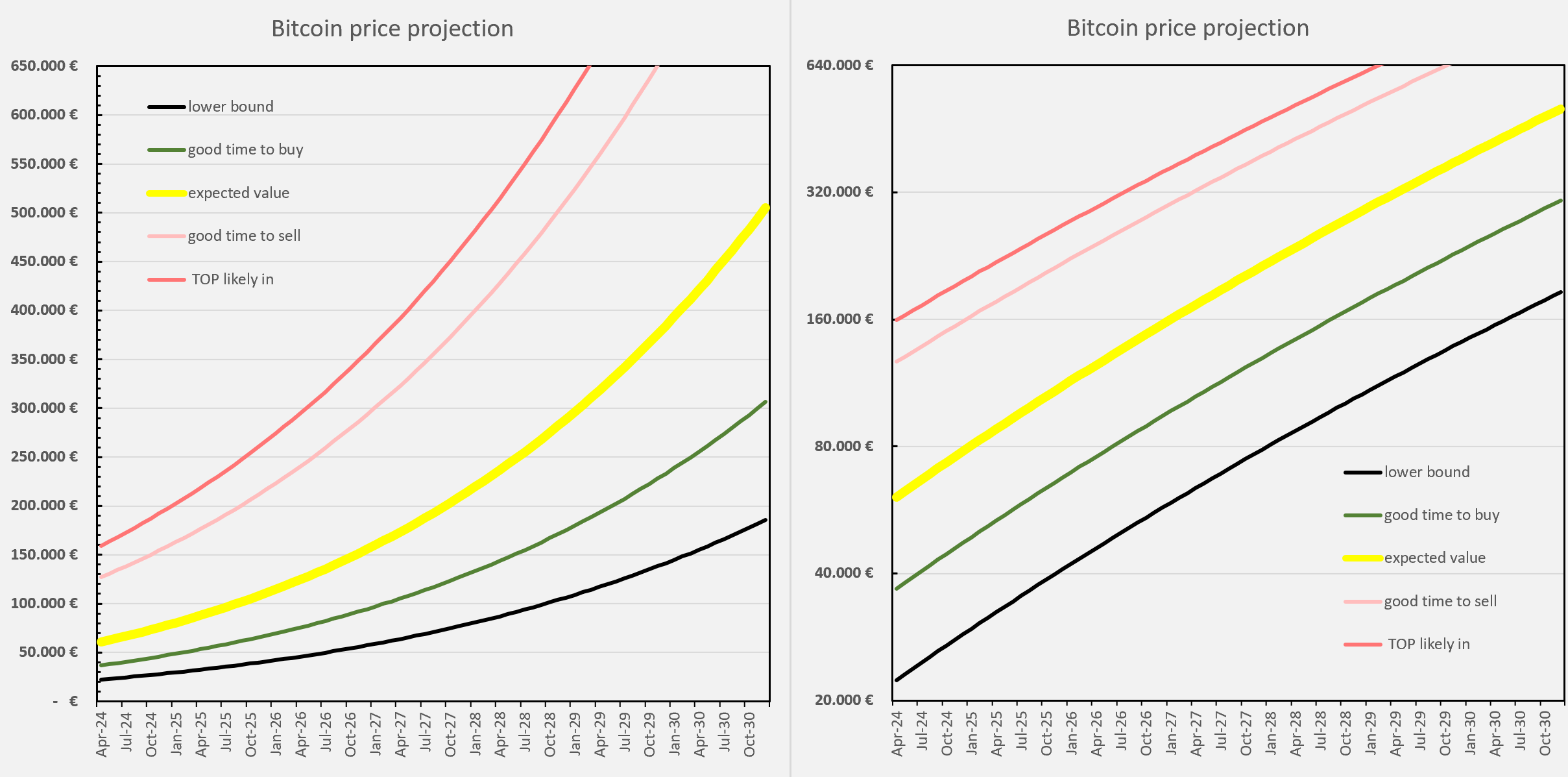 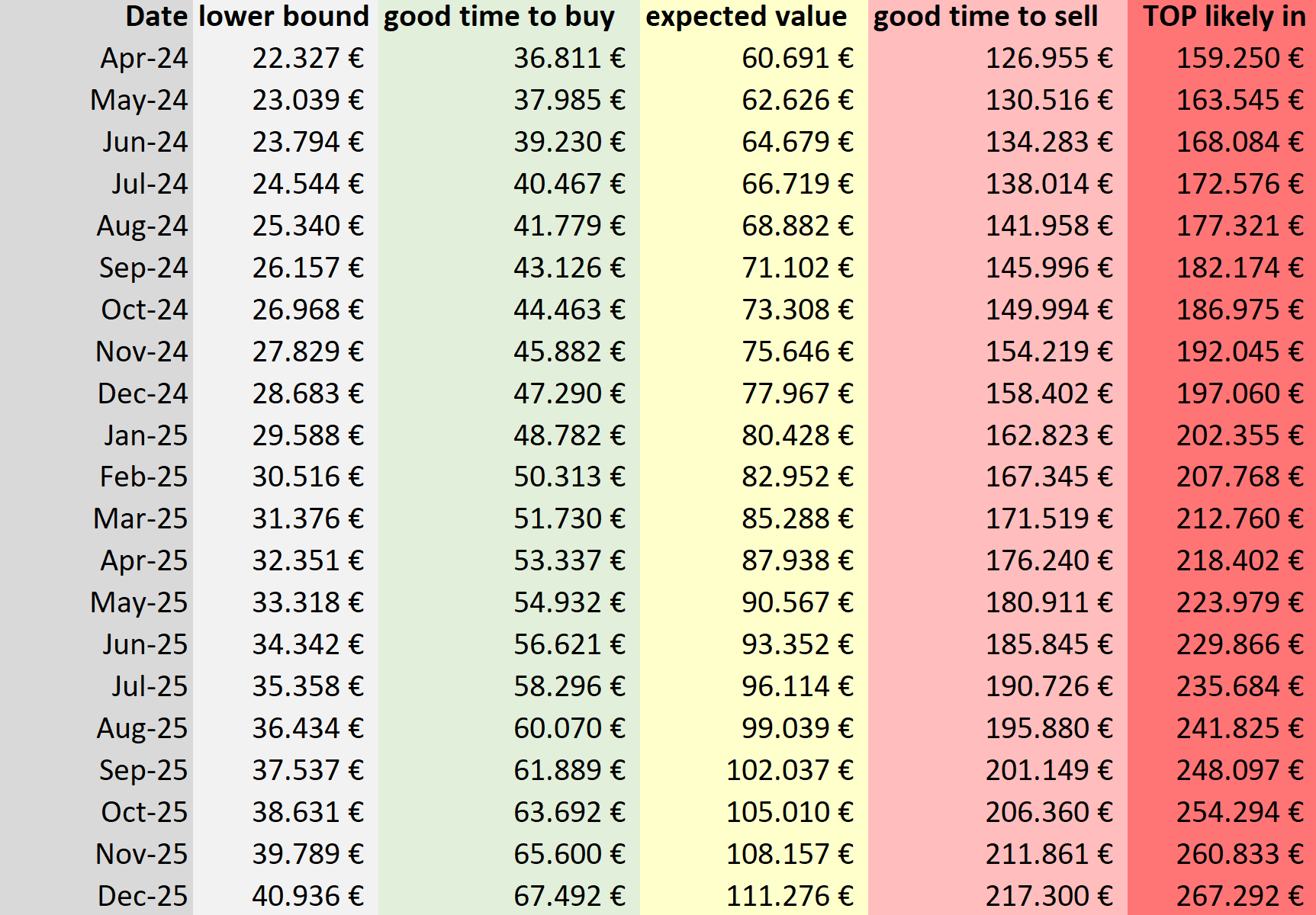  Please be aware, if you extrapolate multiple years into the future, it becomes more likely for the model to break down.
Regarding the avarages i guess you mean today +365-465 days?!
What do you think about using Monte-Carlo price simulation in Excel to close that gap and find a more precise X-Position for today?!
The yield is measured from today + 365 days, however for the purpose of smoothing we average over the last 100 days. As a results our circly charts show the average yield of [today vs. today+365 days], [today - 1 day vs. today+364 days], .... , [today - 99 days vs. today+266 days]. |
Sicherheit für deine Familie, dich und deine BTC, dank der fundierten Sicherheits-Tipps der KryptoArche. Wir kaufen Bitcoin zum Vermögensaufbau oder zur Krisenvorsorge. Wir kaufen Bitcoin dezentral als Schutz vor Räubern, mit guter Historie und verwahren unsere Bitcoin sicher vor Verlust, Räubern und Dieben sowie versteckt Wir nutzen sichere Passwörter, Betriebssysteme, Software und sufen sicher. Sicher dir deinen kostenlosen Platz auf der KryptoArche! Die Zeit läuft ab! Steig ein, bevor es zu spät ist! Gemeinsam bleiben wir immer über Wasser!
|
|
|
|
virginorange (OP)
|
 |
April 14, 2024, 02:57:29 PM |
|
TL;DR: Best to buy Bitcoin cheap and with low volatility. If Bitcoin becomes cheap in the future, but has high and rising volatility, despite low volatility in other asset classes, we might reconsider using our model.Our currently useful model ...Our model suggest we can outperform simple DCA, if ... (i) we become more cautious, if the Bitcoin becomes expensive (price exceeds Trend +750 days), (ii) we take a full position, if Bitcoin becomes cheap (price = Trend * e^-1) (iii) and otherwise simple DCA into Bitcoin. ... should not mislead us down the road.If we decide how much Bitcoin we buy or own based on this model, we should be reasonable confident, that our model continues to be correct. Every financial model will eventually break, therefore we should not follow our model blindly. There would be little pain for us, if Bitcoin price is outperforming our pretty optimistic model. Therefore we should be especially careful on the downside, if we suspect our model is breaking towards the downside. Hints, that our model is breaking towards the downside:a) Since 2011 the Bitcoin price never declined blow Trend*e^-1, falling below Trend*e^-1 or even Trend*e^-1.2 would a sign that our model is breaking. b) Another sign could be unusually high Bitcoin price volatility. So what kind of volatility would be unusual for Bitcoin?
Initially the Bitcoin price was pretty volatile (2011-2014). In general Bitcoin becomes less volatile as time goes on.  If you plot the Bitcoin price vs. Trend (x-axis) vs. the volatility (y-axis) you notice that Bitcoin is more volatile in the bull market than in a bear market.  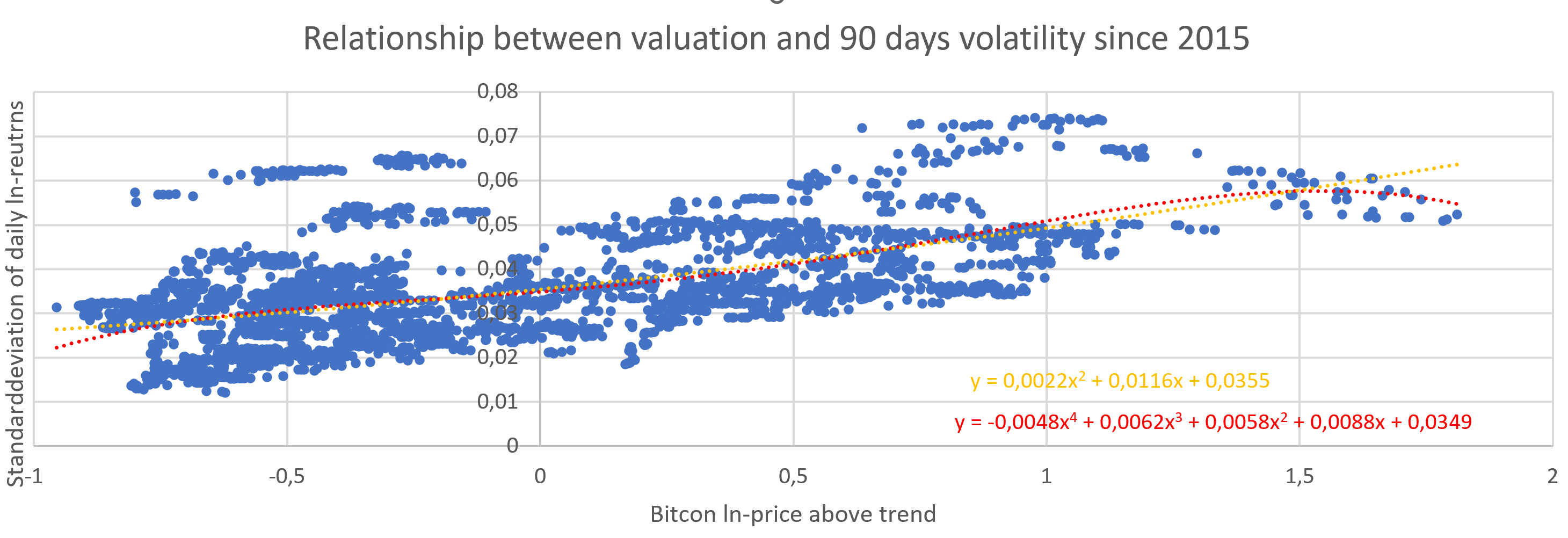  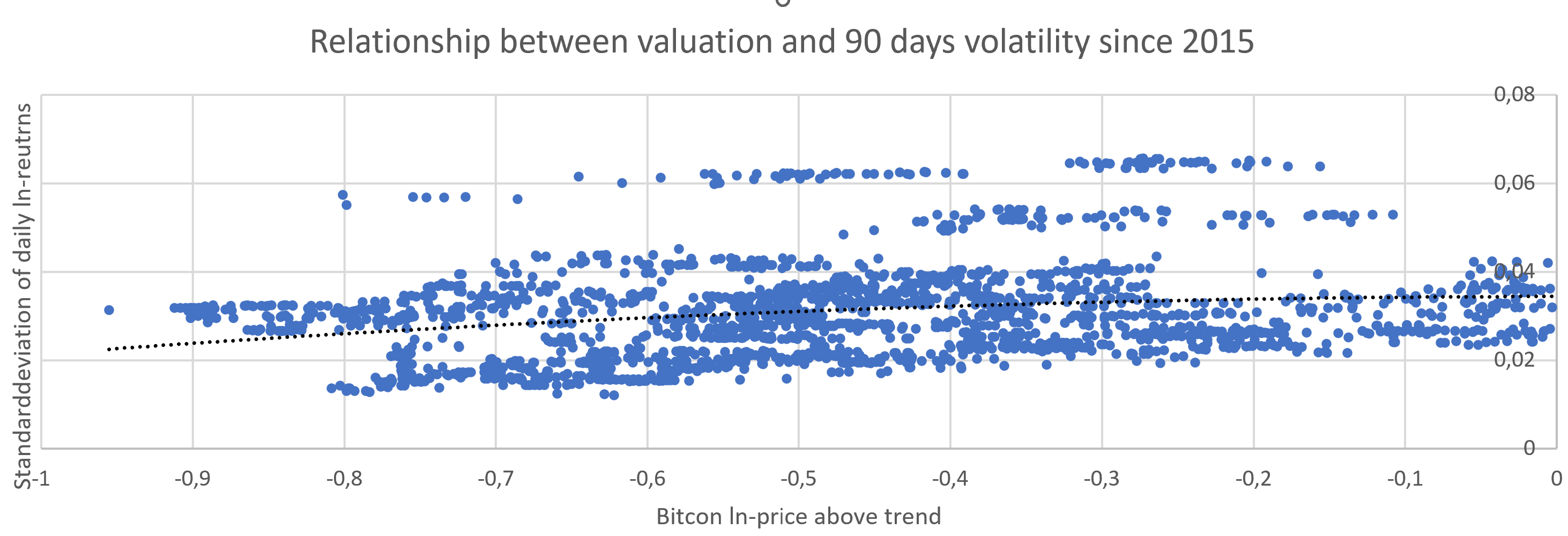 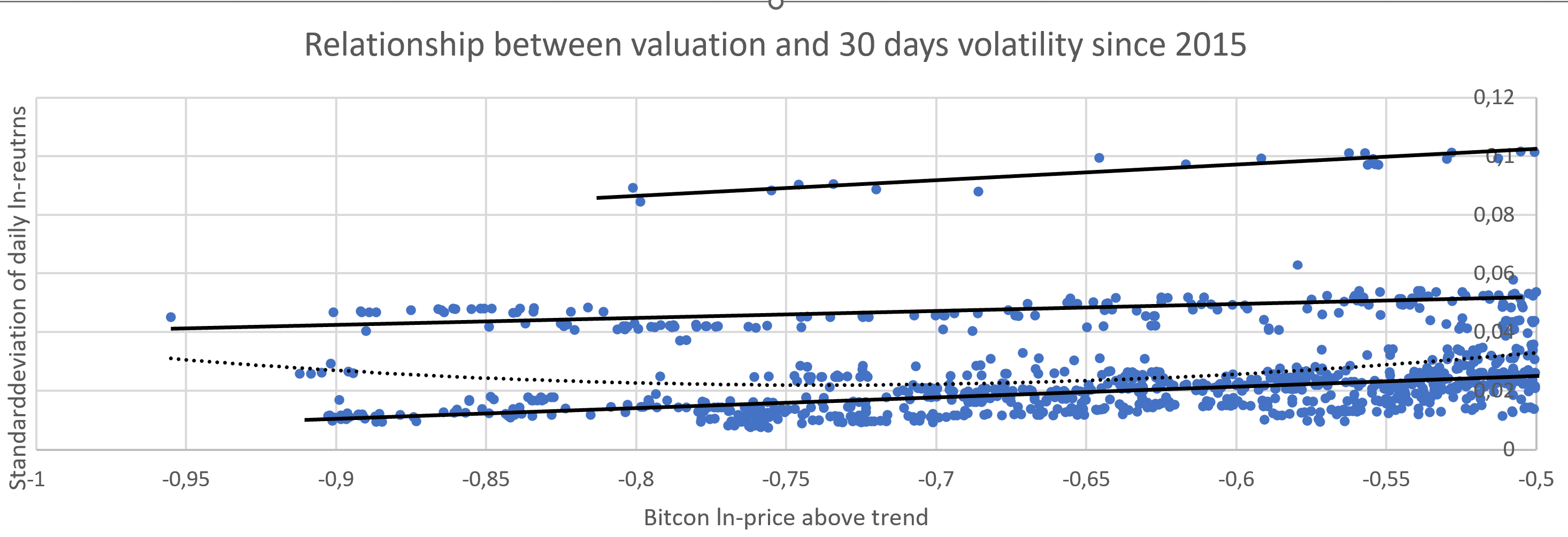 This is extremely unusual. All the other asset classes I know of, are more volatile, when they are cheaper. Let's take a look at the S&P 500 price index. 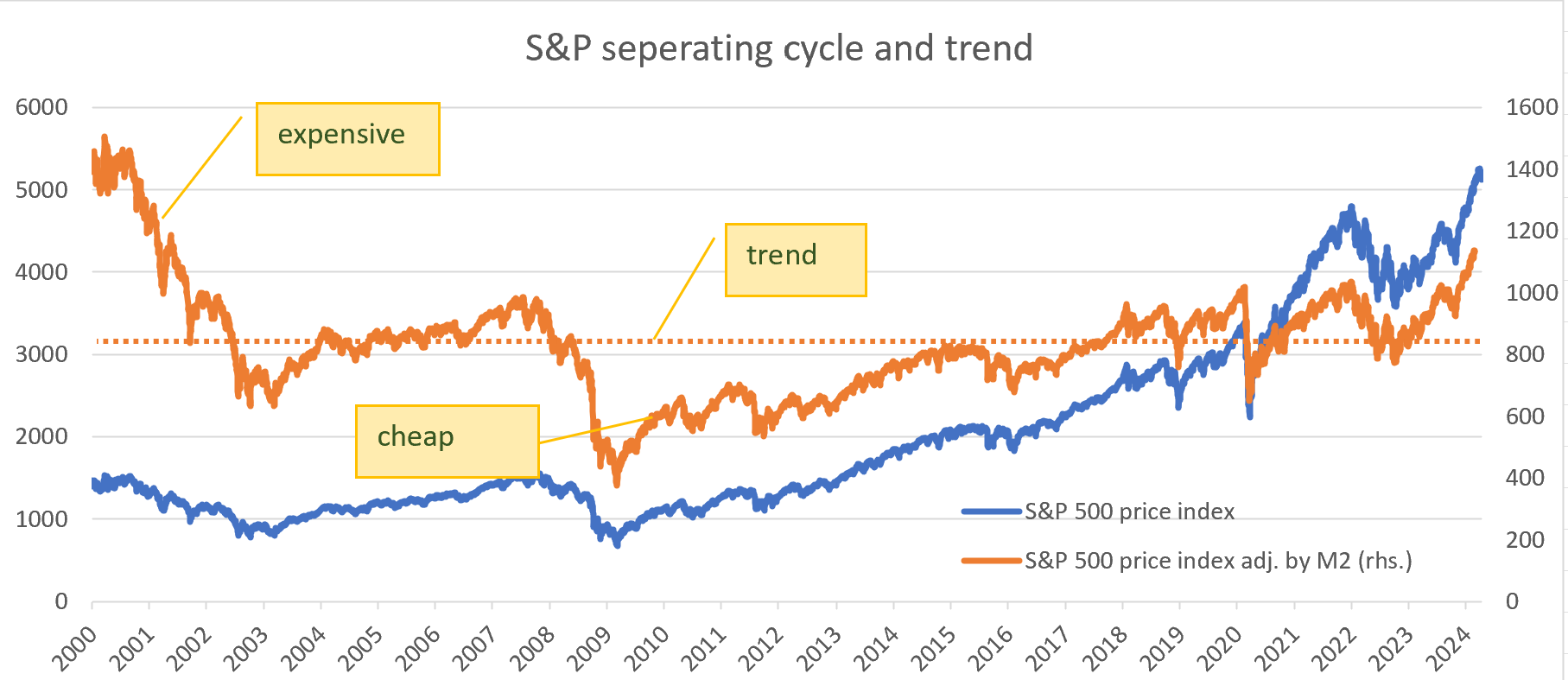 The blue line shows us the S&P 500 price index. The orange line shows us the S&P 500 price index adjusted for USD-M2 growth. The orange dotted line gives us the S&P trend growth. If the S&P (orange line) is below its trend (orange dotted line), then the stocks are cheap. If the S&P is above trend, stocks are expensive. The main long term price driver for the S&P 500 (but also for example gold) is M2-inflation. Adjusting for M2 gives us a flat trend for the S&P 500. 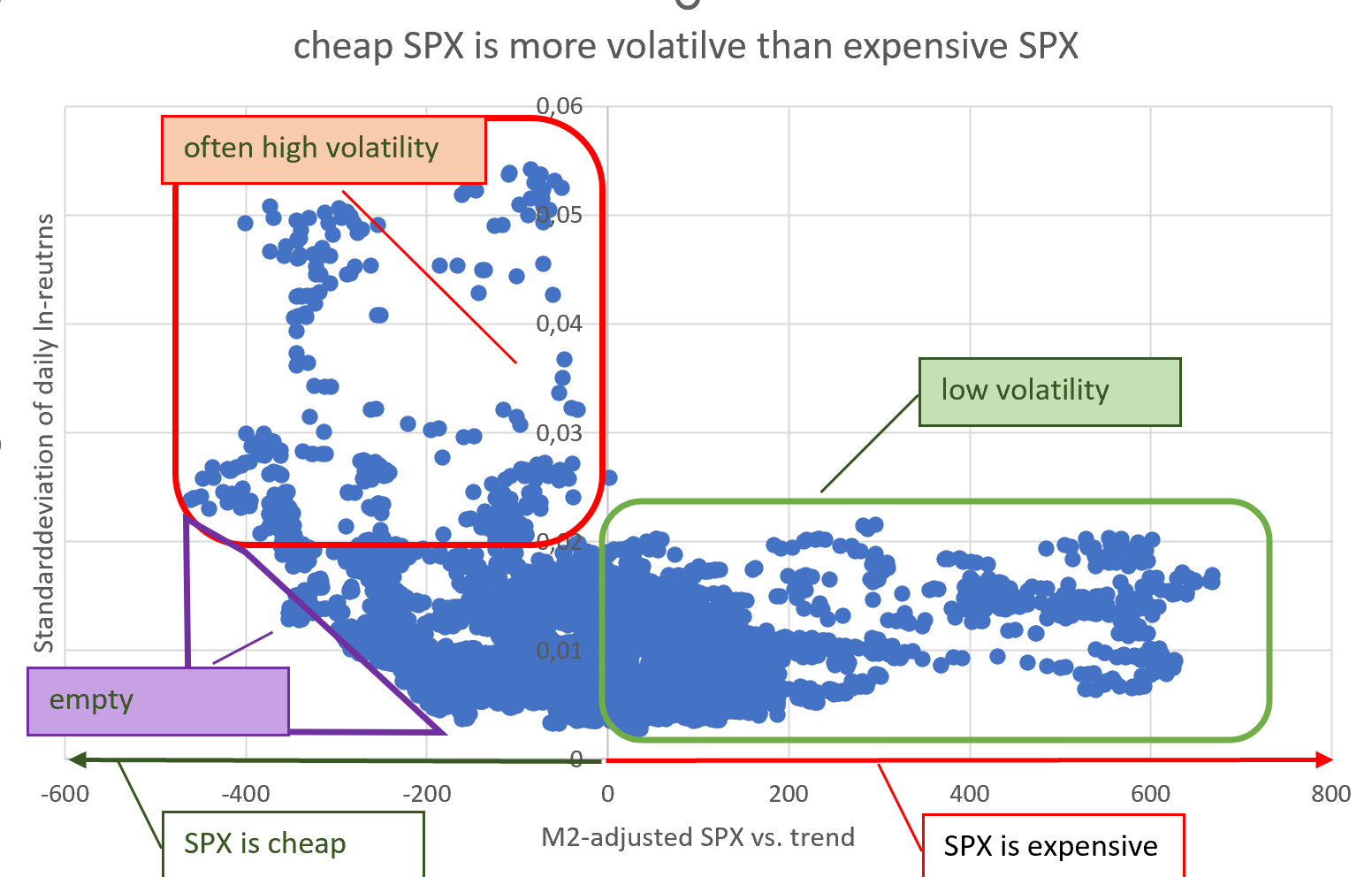 If we plot the S&P vs. trend against its volatility, we can see that expensive S&P has low volatility (green box). We only see high volatility for cheap S&P (red box). We can also see that very cheap S&P doesn't come with low volatility (purple triangle). But Bitcoin is different. For Bitcoin the combination of cheap and low volatiltiy is pretty common.  However we can see that different cycles have different volatility levels.  Lets plot our volatility after 2015. 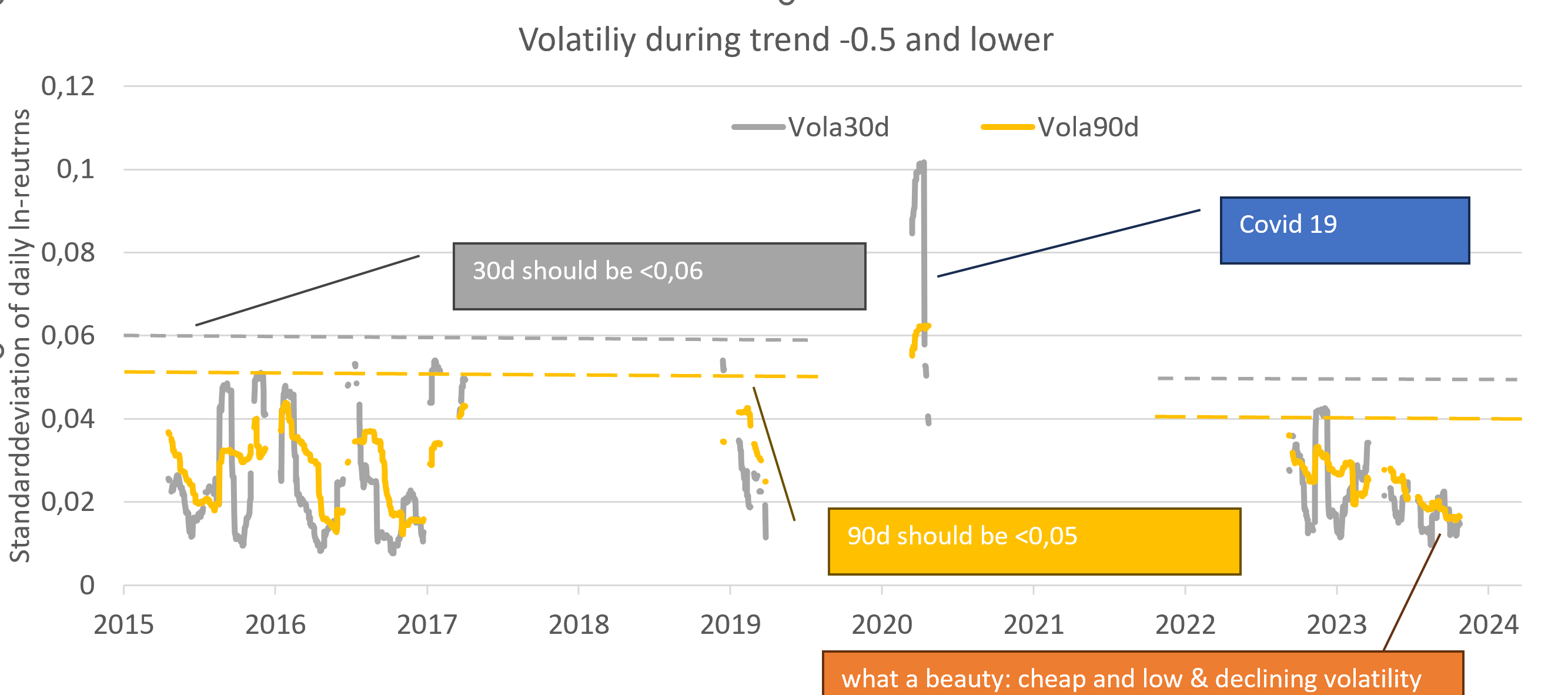 The grey lines is our volatility calculated over the daily returns over the previous 30 days. The yellow line is the 90 days volatility. To take out the noise I only displayed the volatility lines, if Bitcoin was cheap (Trend * e^-0.5 or blow). We can see that volatility is generally below 0,06 (30d) and below 0.05 (90d). The only exception is COVID 19 with high volatility in all markets. In the next bear market I would expect the Bitcoin's volatility to reamin below the dotted lines. A higher Bitcoin volatility I would only expect during times of weder market turmoil (like during COVID 19). The model would risk breaking down, if Bitcoin is cheap, but the volatility is high. Our last bear market was perfect. Bitcoin was cheap, volatility was low, volatility was declining. A very nice setup in hindsight. 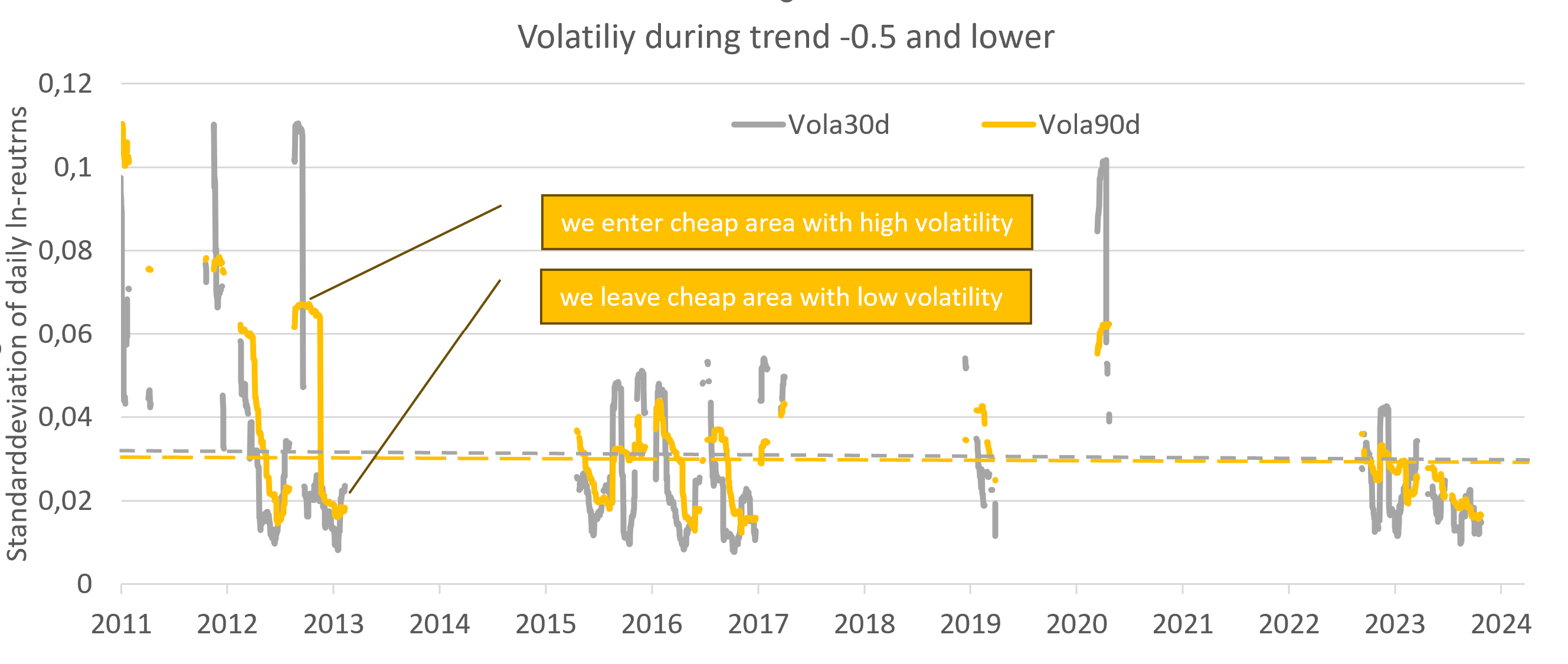 Over several cycles we can observe a declining volatility during bear markets. We enter the bear market with high volatility and leave the bear market with low volatility. If we had planed to time the market, we could have waited for volatility to come down, before taking our full Bitcoin position. This would have worked every time except COVID 19. Result: A low volatility during the bear market gives us additional confidence to invest into cheap Bitcoin.
|
Sicherheit für deine Familie, dich und deine BTC, dank der fundierten Sicherheits-Tipps der KryptoArche. Wir kaufen Bitcoin zum Vermögensaufbau oder zur Krisenvorsorge. Wir kaufen Bitcoin dezentral als Schutz vor Räubern, mit guter Historie und verwahren unsere Bitcoin sicher vor Verlust, Räubern und Dieben sowie versteckt Wir nutzen sichere Passwörter, Betriebssysteme, Software und sufen sicher. Sicher dir deinen kostenlosen Platz auf der KryptoArche! Die Zeit läuft ab! Steig ein, bevor es zu spät ist! Gemeinsam bleiben wir immer über Wasser!
|
|
|
|
virginorange (OP)
|
 |
April 16, 2024, 06:54:49 AM |
|
TL;DR I develop a warning sign, to warn me about my Bitcoin price model is breaking towards the downside during a bear marketInput: Bitcoin price ( [valuation vs. trend] and [volatility multiple vs. S&P 500]) Output: Traffic light ● red = urgently check, if the Bitcoin price model is still valid ● yellow = keep attention on the traffic light, ● green = no problem with Bitcoin price model detected Why do we use our traffic light? ●●● Risk management, time savings, control of emotions A significant Bitcoin exposure as a % of net worth requires risk management tools. The tools should quickly indicate, if my Bitcoin portfolio allocation is developing according to expectations or I have to update my assumption, my model and possibly my allocation. High volatility in Bitcoin in combination with low valuation could indicate mayor negative news. High Bitcoin volatility during times of high general market volatility (COVID 19) doesn't indicate Bitcoin specific problems. However if Bitcoin's is very volatile while other markets are calm, this could indicate problems influencing our Bitcoin price model. Therefore we calculate the multiple of Bitcoins volatility over the S&P 500 volatility (90 days). 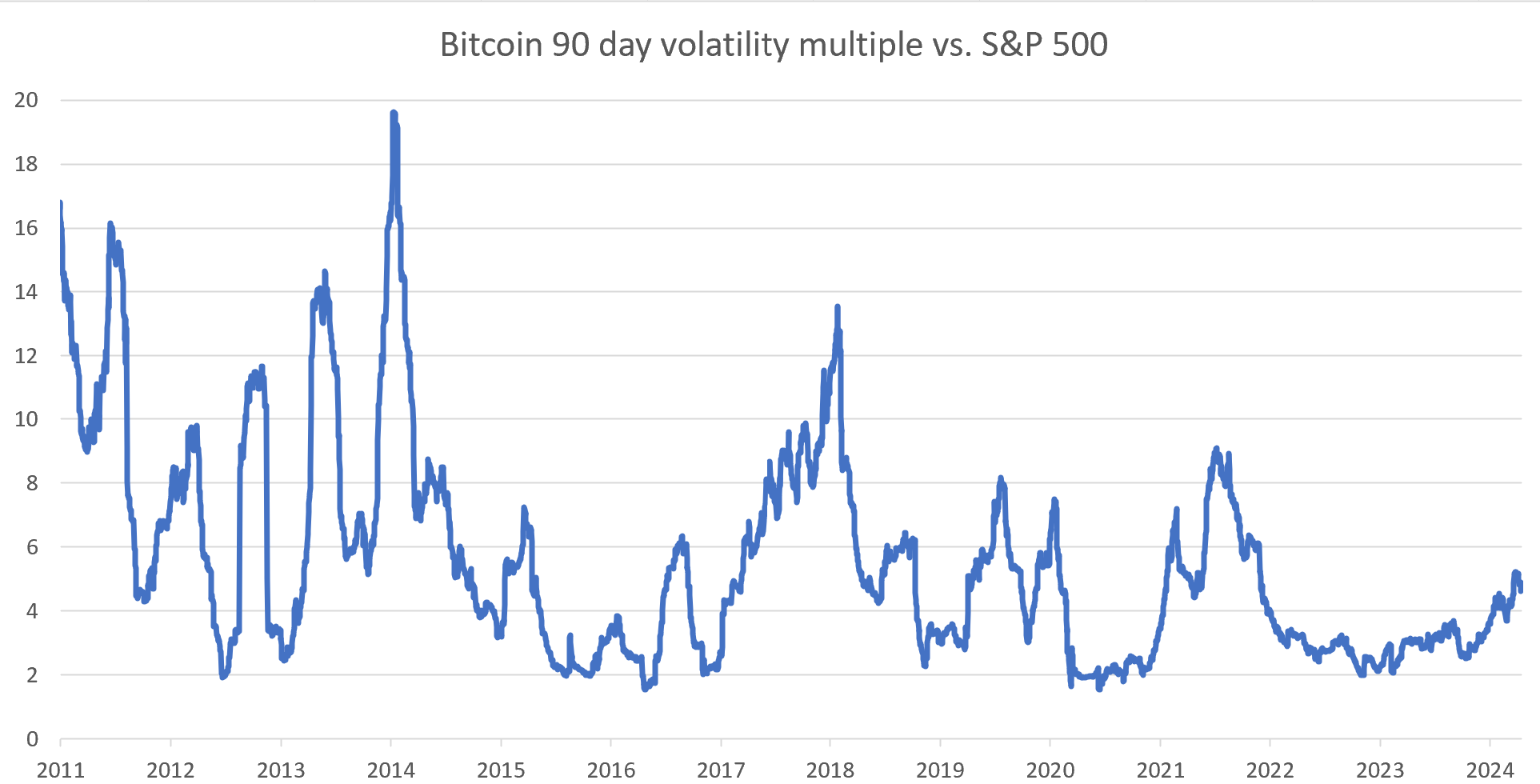 We can see Bitcoin's excess volatility is declining as time goes on. If we plot Bitcoin's [excess volatility vs. stocks] vs. [Bitcoin's valuation vs. trend] ...  ... we notice that high Bitcoin valuations are associated with higher volatility, while low Bitcoin valuations are often associated with low volatility. This trend relationship is even clearer, if we only plot data after 2014:  The higher Bitcoin's valuation the higher the volatility. The positive relationship between valuation and volatility is uncommon for other asset classes. Usually low valuations are associated with higher volatility (bond spreads or shares). If we look at the S&P 500 (blue line), and adjust the S&P 500 by M2-money inflation (orange line), we can separate the cyclical S&P performance (orange line minus orange dotted line) from the trend performance (orange dotted line). 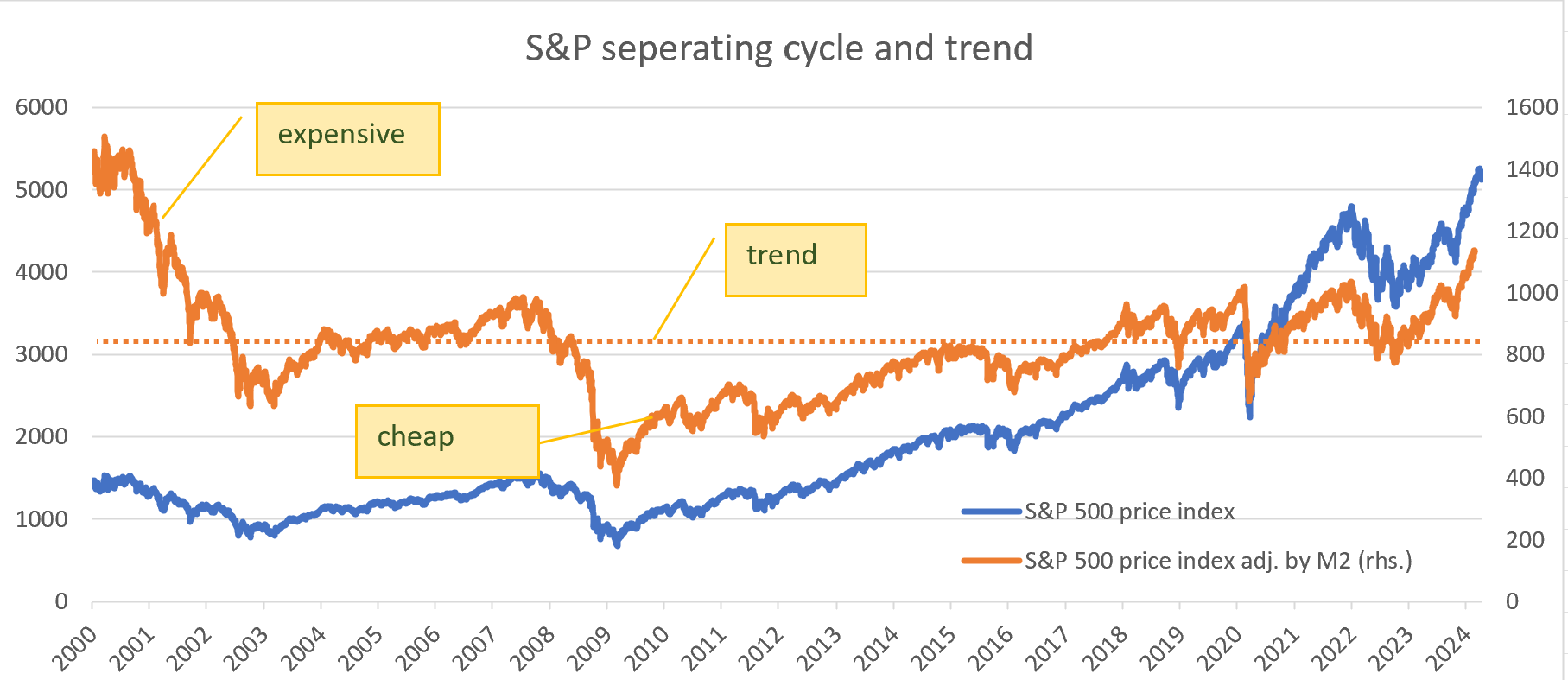 Interestingly the S&P has 0 trend growth exceeding M2-inflation. The S&P was expensive 2000-2002 and cheap 2009 - 2014. If we plot S&Ps volatility ... 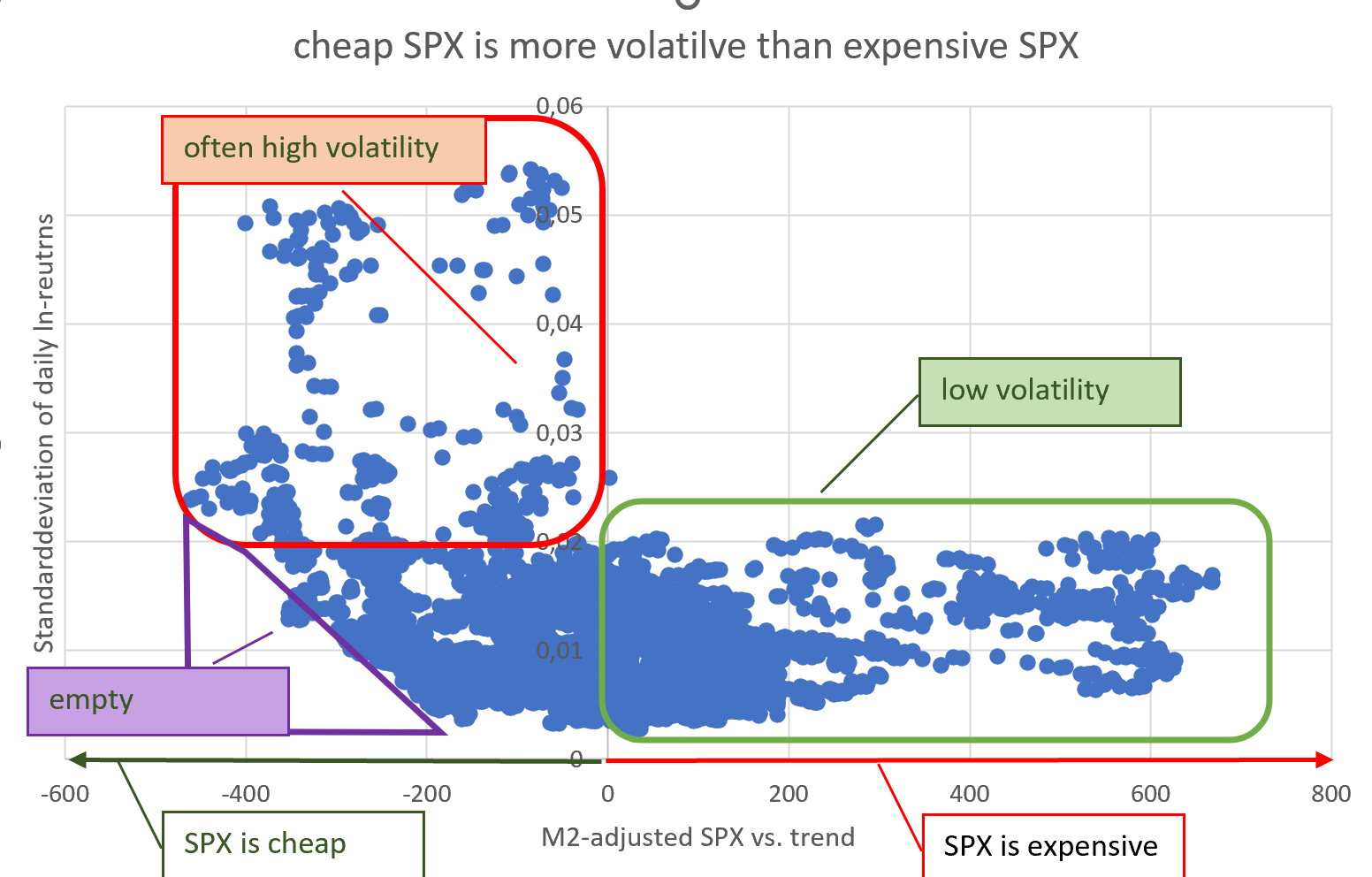 ... we notice expensive S&P is associated with low volatility (green box) and cheap S&P is often associated with high volatility (red box). Very cheap S&P almost never comes with low volatility (purple triangle). So lets get back to Bitcoin.  Since Bitcoin has declining volatility, we have to separate early bear markets from later bear markets. A bear market is Bitcoin price falling e^-0.5 below trend. We separate those bear market in 4 separate bear markets (bear 1, bear 2, bear 3 and bear 4) for each 4 year Bitcoin cycle. We can now take a look at the relationship between Bitcoin valuation and volatility for our 4 bear markets. 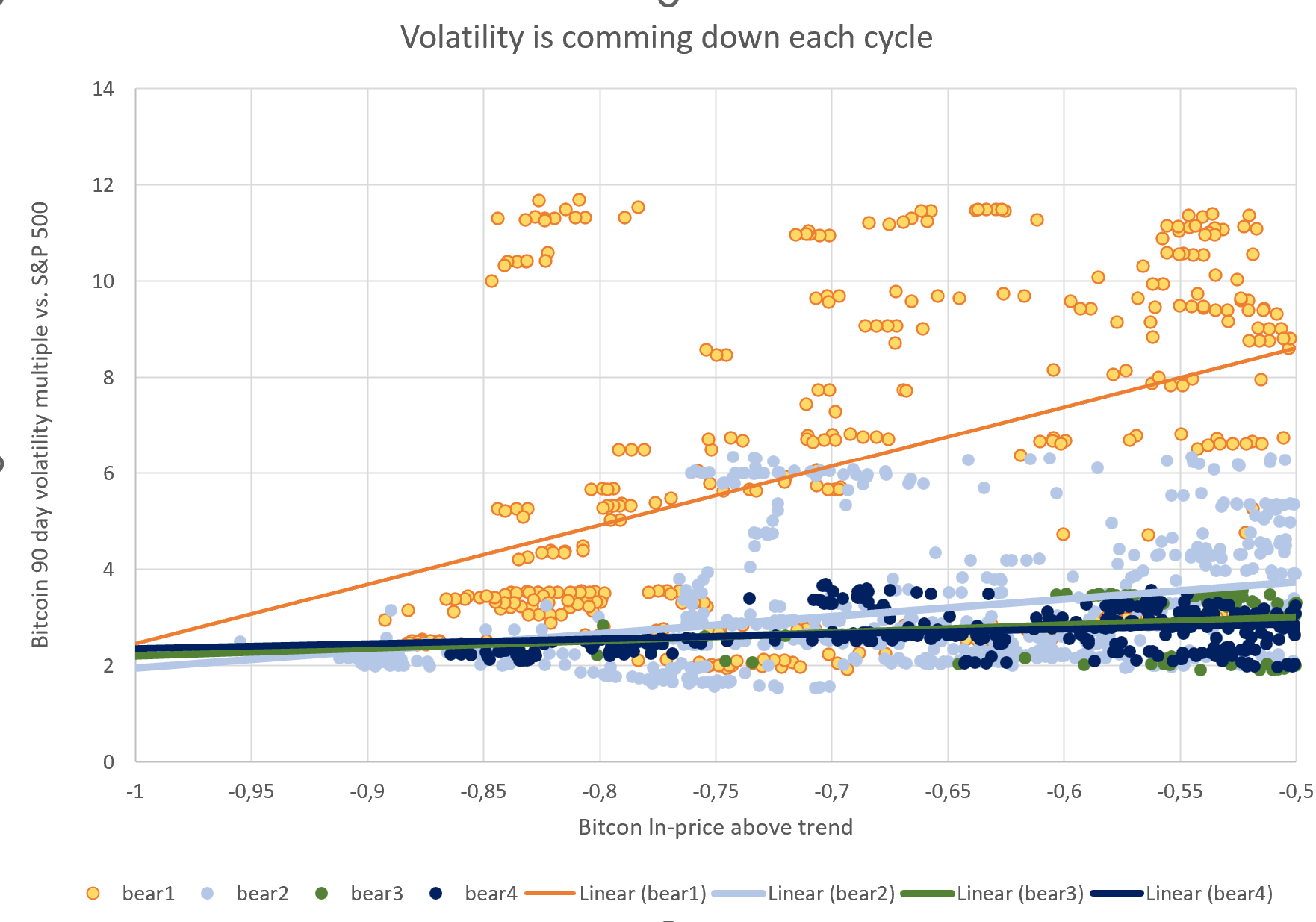 We can observe that the first bear market was the most volatile with subsequent bear markets becoming less volatile. We can also see from the linear trend lines that lower valuation is weakly associated with lower volatility. To get a better picture I make a chart with only the most recent 3 bear markets: 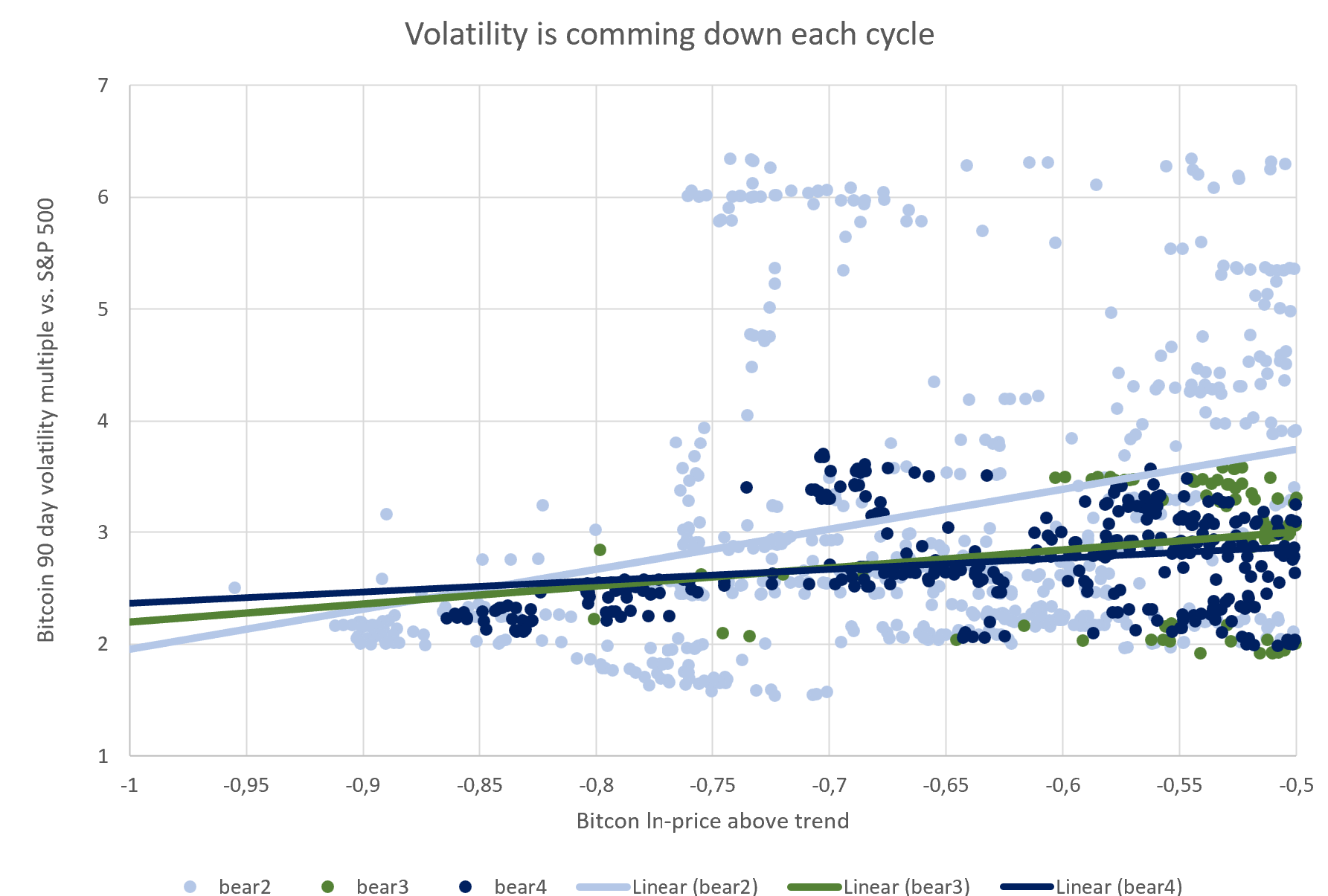 And I made a chart with only the most recent 2 bear markets as well: 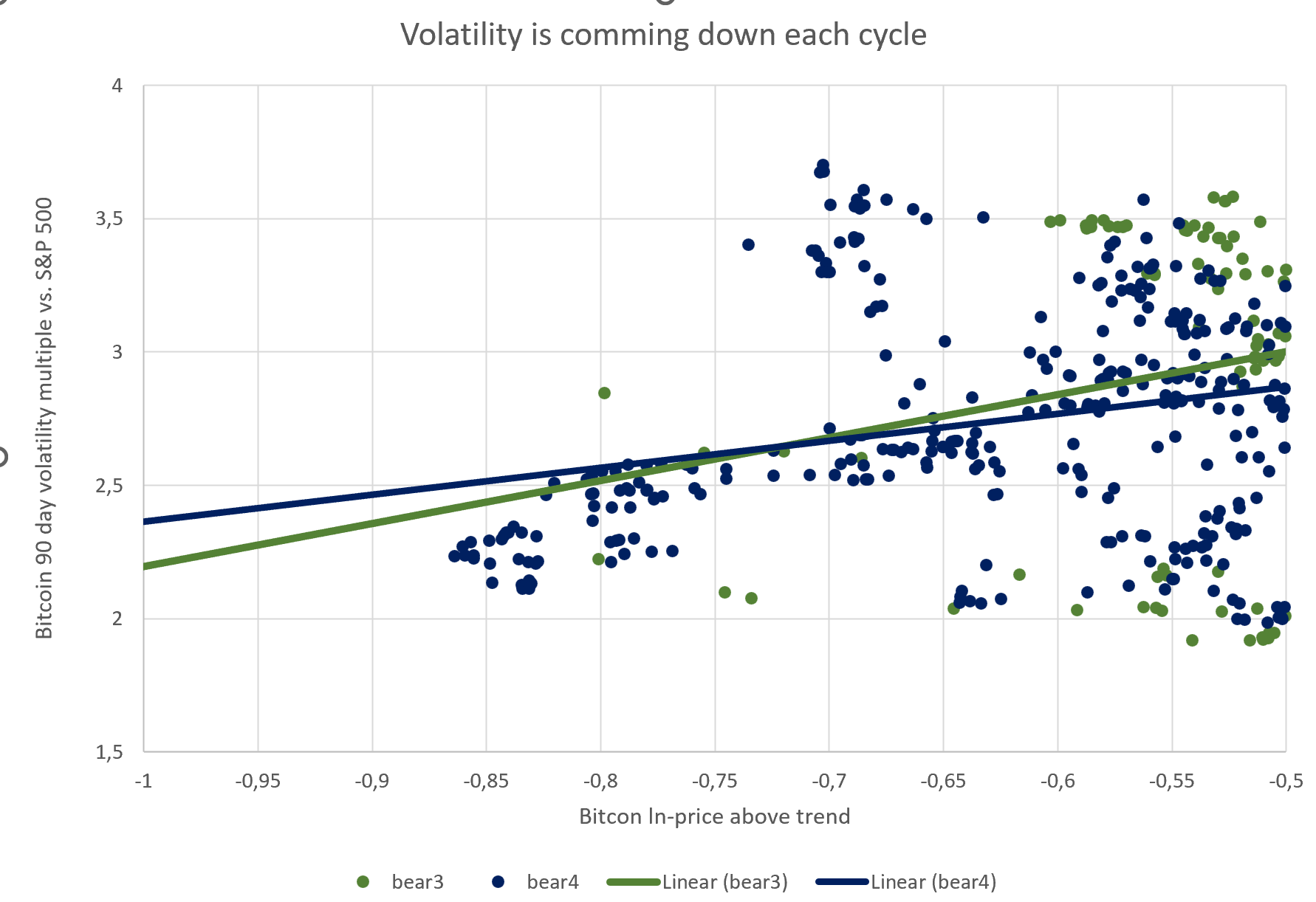 We can observe below average volatility in a severe bear markets (-0,75 and lower). The combination of low valuation AND high volatiltiy was especially unlikely in the past, and I would not expect dots in the "unexpected are" in the future either. 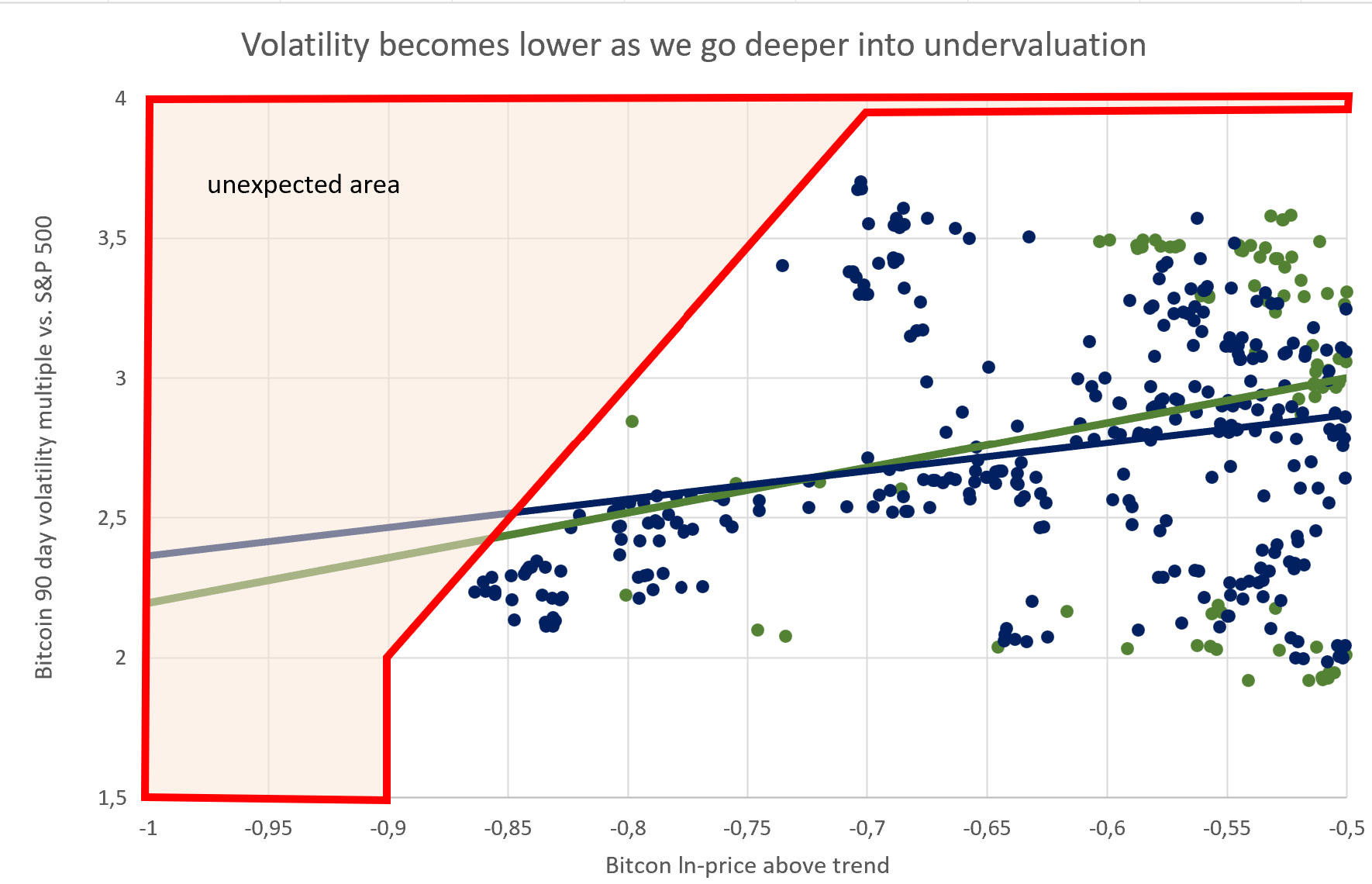 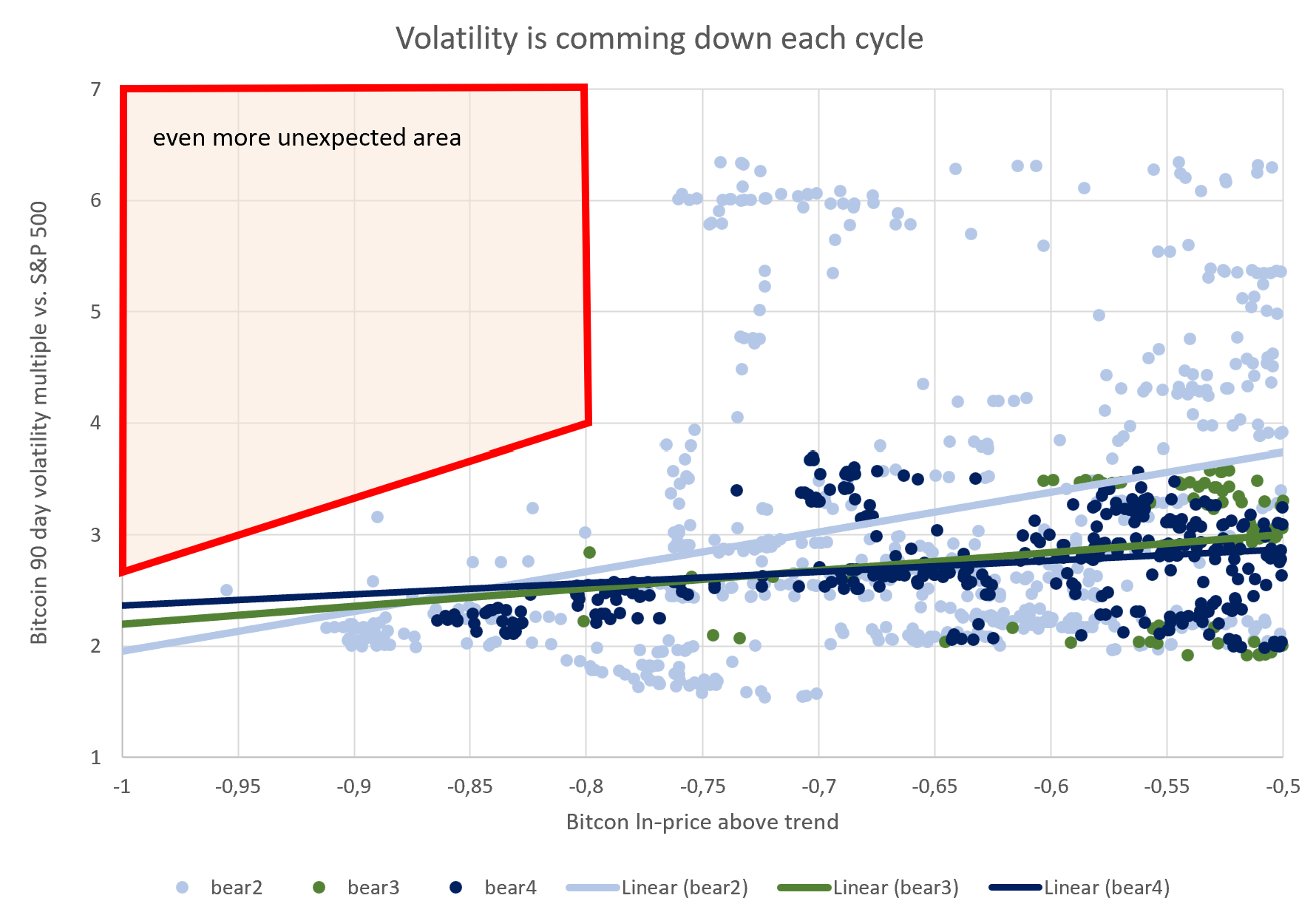 The two red boxes "unexpected area" and "even more unexpected area" are drawn via hand. An alternative visualization would be to mark all points, which were not exceeded during previous 4 bear markets. The yellow line marks the frontier data points in the first bear market. All the points above the yellow line, we have no observation of higher volatility given a certain level of undervaluation. So all observed data points, even the worst data points are below the curve. The 3 other lines (bear 2, bear 3, bear 4) show the worst observed combinations of drawdown and volatility during the respective bear market. 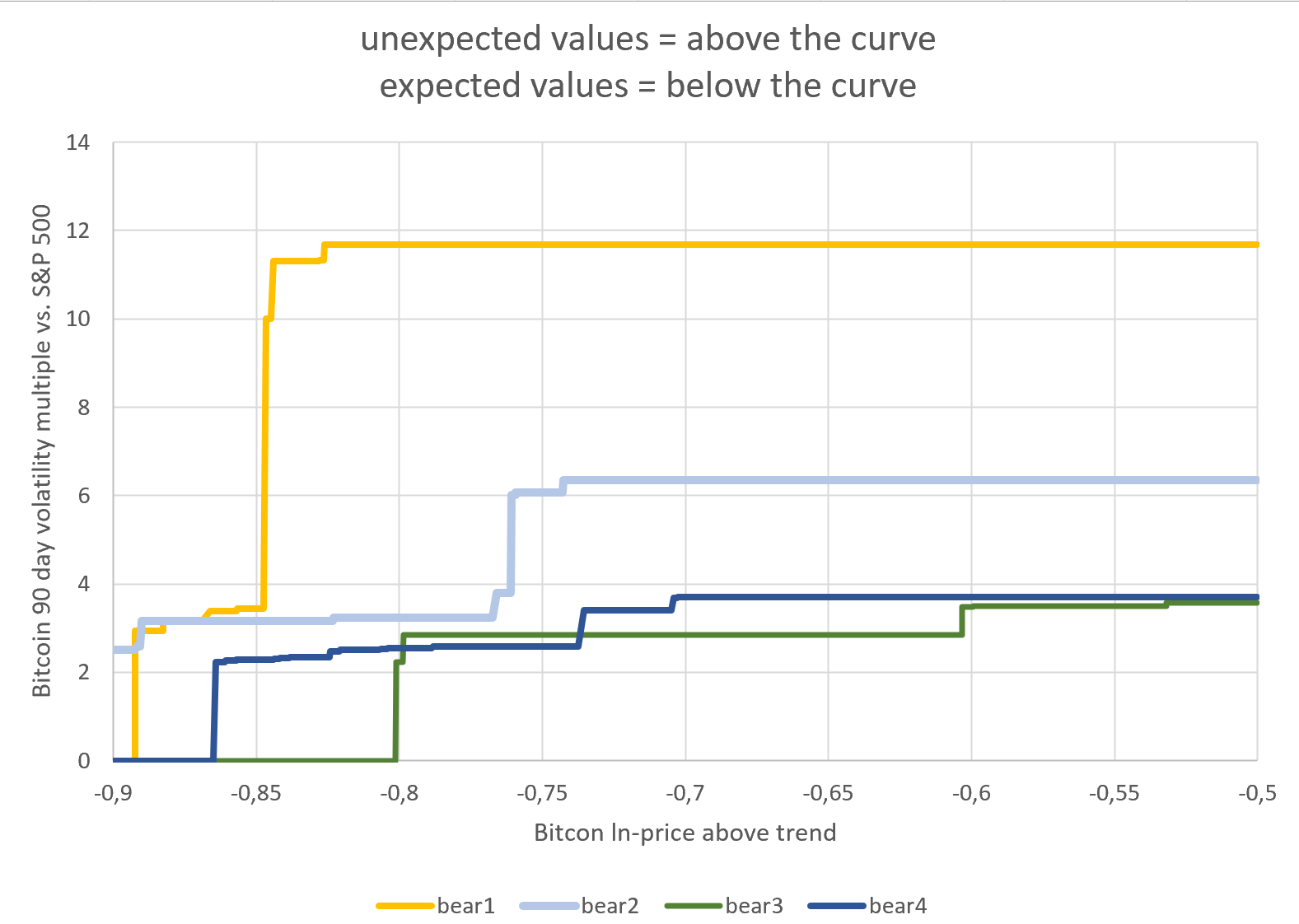 From bear1 to bear2 to bear3 we can see a clear reduction in volatility. The worst data points for bear3 and bear4 however look pretty similar, so I will lump them together in future charts. These frontiers only give us a binary indicator. If our newly observed data point is outside of the frontier (above the curve), our observation is worse than historical data points. If our newly observed data point is inside of the frontier, our observation is within historical observations. To quantify "Know how bad is it?" we have to rank our data points somehow. 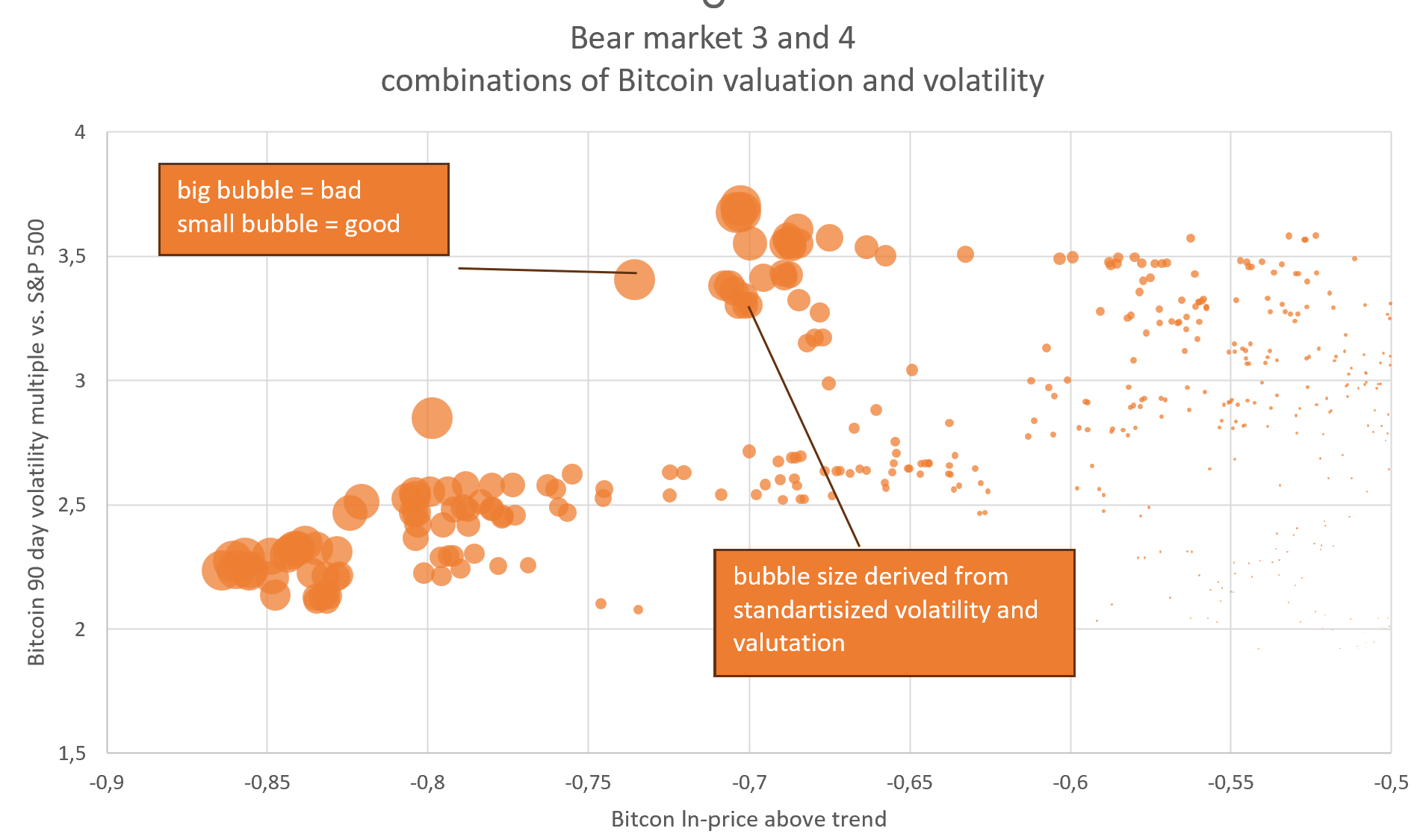 We want to create a metric, which shows (i) high volatility is bad, (ii) low valuation is bad, (iii) a valuation decline from -0,5 to -0,7 much ist less bad than a valuation decline from -0,85 to 1,05 and (iv) a combination of high volatility AND low valuation is worse than any one of both. The valuations during bear market (Bitcoin price below trend) shows many observations of average bear market and fewer observations as the bear market become more extreme. Describing the valuation data in a bear market with a normal distribution seems fitting to me.  Whereas the the volatility does not suggest a normal distribution. The higher the volatility the lower the probability, with a volatility floor slightly below 2.  With this information I create a formula for calculating risk scores, which seems fitting to me. The risk score measures the risk of a sudden break in my model to the downside. Each blue dot represents a day in the bear market bear3 or bear4. The size of the dot represents how risky a break down of the model to the downside was for each day. 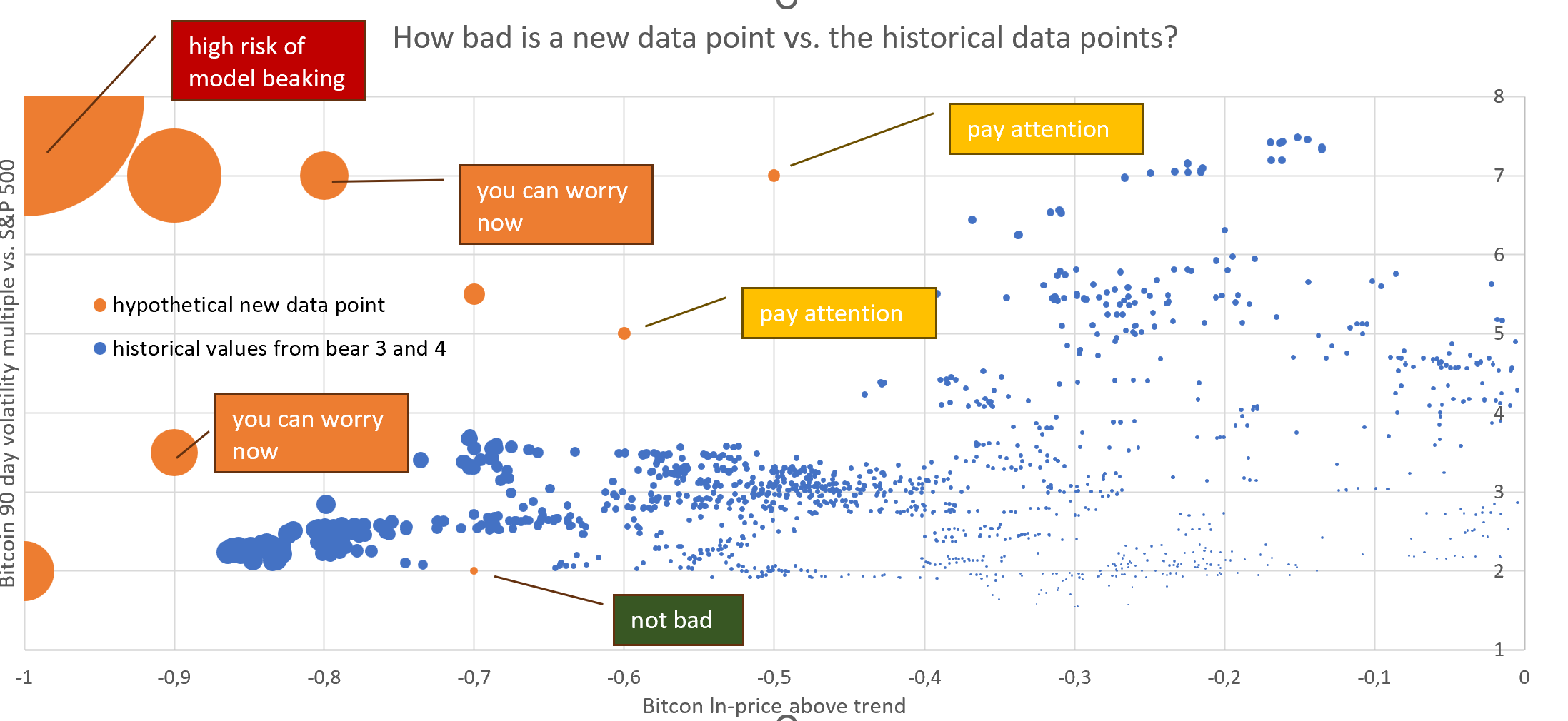 The orange points are hypothetical new data points in the future to show how much risk each data point would have: - A Bitcoin price at trend*e^-0.7 with a volatility of 2, would be low risk, since we have historical data points with am even lower Bitcoin price with higher volatility. This data point would be a green traffic light. - A day of (-0.6, 5) or (-0.5, 7) would be slightly elevated risk. The combination of Bitcoin price and volatility seems a bit high compared to the last 2 bear markets. However Bitcoin was cheaper or more volatile in the past, so we have to pay attention. This data point would be a yellow traffic light. - A hypothetical day of (-1, 2) or (-0.9, 3.5) or (-0.8, 7) would indicate elevated risk of a model break down, since drawdown and volatility exceeds historical data from the last two bear markets. This data point would be a orange traffic light. - A hypothetical day of (-1, 8 ) would indicate a high risk of our model breaking, since the historically Bitcoin price didn't sink so far below trend and the high level of volatility is also very unusual.  The 10 days with the highest risk value were end of 2022 / beginning of 2023, with high drawdown, but only moderate volatility. I added a graph for the risk values since 2011 (blue line).  We couldn't have calculated the blue line in real time. However I still plottet the line to get a feeling how the risk value moved during Bitcoin's history.  The highes recent risk value was 531 at Dec. 31th of 2022. This was the highest risk value since 551 on Sep. 11th 2016, which was 6.3 years earlier. The absolute risk value has not important meaning for our interpretation. However our risk value in comparison to previous risk values is important for our interpretation. Genrally Bitcoin's risk is declining. If on one day we exceed the risk of multiple prior years, we can for sure say is a sign of elevated risk. 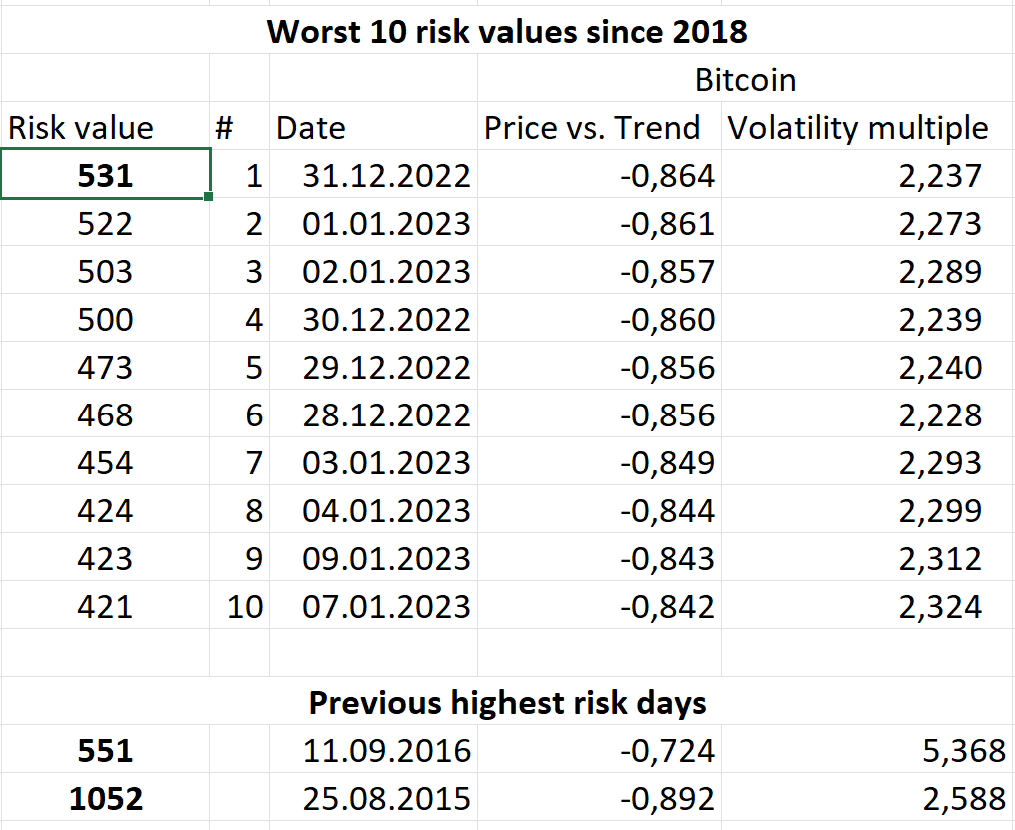 Our historical data enables us to set cutoff points for acceptable risk. I think a risk value 550 does not indicate a break down of our model, since we reached this neighborhood 2016, 2022, 2023 and 2020. A risk level of more then 1000 would indicate possible model breakdown, since we would reach the risk neighborhood of 2015 or even 2013. This would be surprising, since we would exceed the risk values of the previous decade and breaking the trend of decreasing risk in Bitcoin. Since now we have our risk levels (<550 for ● green light, >1000 for ● red light and ● yellow light for 550-1000) we can draw them into our plotter chart. 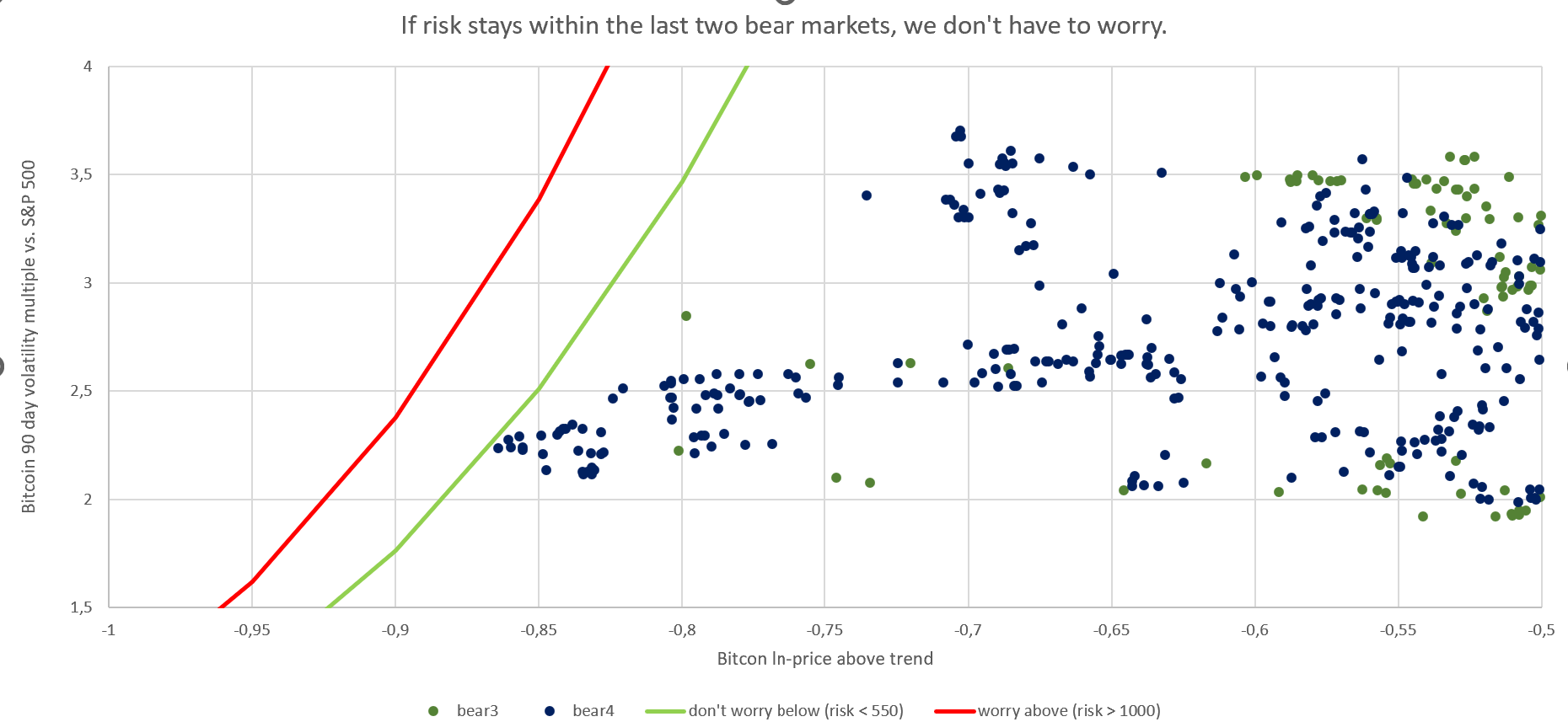 All datapoints for bear3 and bear4 are below the green line, which means we can sleep well and trust in our model (Bitcoin trend price growth and moving around cycle). While everybody is scared, we sleep like a baby. We have no data points above the red line, therefore on no days we had to question our model. Since we calibrated our at bear3 and bear4 this result is not surprising. 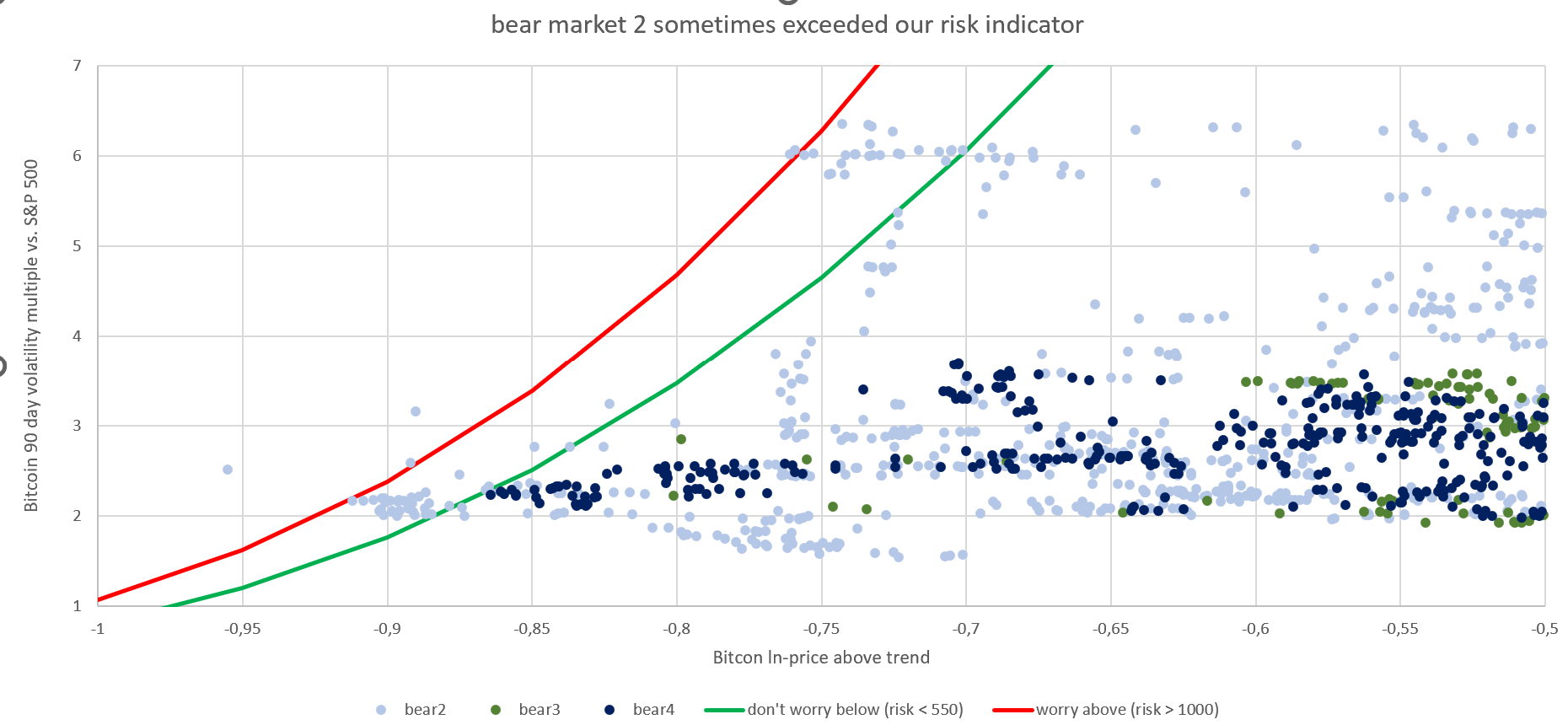 If we add bear2, we can see some dots get a yellow traffic light from us (those dots are between the green and the red line). A few dots are are even north of the red line meaning on those days we should check our model for possible break down. I think this calibration is reasonable, because getting risk values during bear market 5, which were last seen in bear3, should make us cautious. 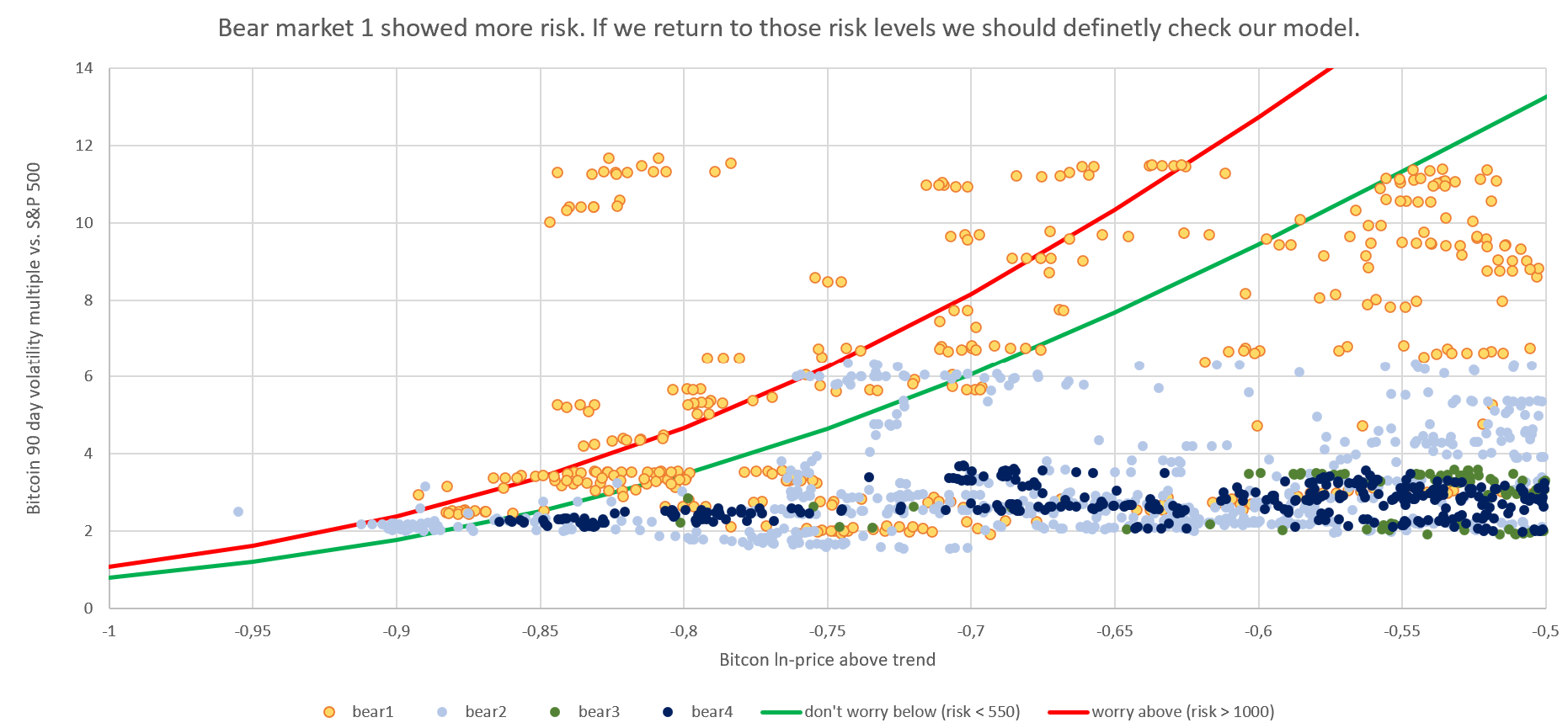 We add bear1, now we see multiple values exceeding our red line. Traffic light is ... - ● red, if Risk_value > 1000 - ● green, if Risk_value < 550 - ● yellow otherwise risk_value = risk_value_below_trend * risk_value_volatility
risk_value_below_trend = 1 / NORMSDIST(z)
z = (Bitcoin_vs_trend - Bitcoin_vs_trend_average) / Standarddeviation(all Bitcoin_vs_trend from bear3 and bear4)
Bitcoin_vs_trend = ln(Bitcoin_price) - ln(Bitcoin_price_trend)
risk_value_volatility = (Standarddeviation(daily Bitcoin price returns from previous 90 days) / Standarddeviation(daily S%P 500 price returns from previous 90 days)^2
|
Sicherheit für deine Familie, dich und deine BTC, dank der fundierten Sicherheits-Tipps der KryptoArche. Wir kaufen Bitcoin zum Vermögensaufbau oder zur Krisenvorsorge. Wir kaufen Bitcoin dezentral als Schutz vor Räubern, mit guter Historie und verwahren unsere Bitcoin sicher vor Verlust, Räubern und Dieben sowie versteckt Wir nutzen sichere Passwörter, Betriebssysteme, Software und sufen sicher. Sicher dir deinen kostenlosen Platz auf der KryptoArche! Die Zeit läuft ab! Steig ein, bevor es zu spät ist! Gemeinsam bleiben wir immer über Wasser!
|
|
|
slaman29
Legendary

 Offline Offline
Activity: 2632
Merit: 1212
Livecasino, 20% cashback, no fuss payouts.

|
Brilliant! I think a lot of valid points here and for sure, an investor would gain advantage over pure DCA but I still think it's not as simple as it seems to switch from pure DCA to 'better' DCA.
I always support pure DCA, which is buying whenever you set, be it a fixed time, which is what I do, more or less beginning of the month when salary comes, or a fixed amount, which is what I consider my small earnings on forum, sig campaign, which is fixed at $$.
Sure, you can view trends and predict and time, but that asks for additional management. First is to monitor market, and this seems easy, but anyone who traded knows the temptation is to get smart and then start to measure, and try to perform better. This alone is time consuming and possibly gets into emotion. It's very easy to get dragged in and get absorbed believe me. Even not to mention distraction of altcoins!!
Second, less of issue but still management, is to set aside cash to buy, and to use it up in low price. That's also very hard to do with discipline.
I like pure DCA because it removes me from market monitoring, therefore removing emotional aspect. I don't even look at price anymore when I buy, or when I receive. And if ATH comes, I just try to sell whatever I can for a nice treat, save it for when big crash comes.
You may not make it the most effective, but all that time saved, all that thinking taken out, you focus on other meaningful things, like study and work and leisure.
People really don't know how to estimate the emotional and time investment of monitoring markets, that's the main issue.
|
|
|
|
|
Patrol69
|
 |
April 16, 2024, 11:03:01 AM |
|
Dollar Cost Averaging DCA investment method, this method is definitely the best and very effective method for investing. Basically in this method an investor can invest quite easily and he gets the opportunity to invest as and when he wants. Currently most of the investors are investing in this method. The DCA investment method is generally more effective when an investor invests in a long-term plan. This investment strategy comes in handy when the investor invests in long term investment plans. I follow the DCA investment methodology in terms of holding my investments and maintaining investment consistency.
|
|
|
|
|
jaberwock
Legendary

 Offline Offline
Activity: 2534
Merit: 1073

|
 |
April 20, 2024, 05:23:23 AM |
|
Dollar Cost Averaging DCA investment method, this method is definitely the best and very effective method for investing. Basically in this method an investor can invest quite easily and he gets the opportunity to invest as and when he wants. Currently most of the investors are investing in this method. The DCA investment method is generally more effective when an investor invests in a long-term plan. This investment strategy comes in handy when the investor invests in long term investment plans. I follow the DCA investment methodology in terms of holding my investments and maintaining investment consistency.
There are other methods to invest and some investors can prefer them over the Dollar Cost Averaging. In DCA we are buying no matter what the price is. Investing in Bitcoin is an opportunity already but another opportunity is if you can wait for the price to dip more and buy more coins. We cannot please anyone anyway and they are still patient when they HODL the coins that they DCA long enough and it's a must because sometimes they can buy even when the price is a bit high. Consistency is important too in each good thing that we are doing. It helps us to maintain the momentum and we are sure that we can always reap greater benefits. |
|
|
|
|
Turbartuluk
|
 |
April 20, 2024, 08:34:56 PM
Last edit: April 20, 2024, 09:52:31 PM by Turbartuluk Merited by virginorange (2) |
|
I always support pure DCA, which is buying whenever you set, be it a fixed time, which is what I do, more or less beginning of the month when salary comes, or a fixed amount, which is what I consider my small earnings on forum, sig campaign, which is fixed at $$.
Sure, you can view trends and predict and time, but that asks for additional management. First is to monitor market, and this seems easy, but anyone who traded knows the temptation is to get smart and then start to measure, and try to perform better. This alone is time consuming and possibly gets into emotion. It's very easy to get dragged in and get absorbed believe me. Even not to mention distraction of altcoins!!
Second, less of issue but still management, is to set aside cash to buy, and to use it up in low price. That's also very hard to do with discipline.
I noticed that there are different understandings for DCA. Often it is used as synonym for simple savings plan (DCA on timeline) but this is not really DCA for me. The show off strength is when you set up DCA on the price axis, e.g. limit orders in a grid each -5%. If you set up some package of backloaded limit orders you can be sure that you will buy BTC at a very good average price as long as BTC price don't fall off the bottom of your grid. Of course you can combine both possibilities of DCA, like this: - monthly 1000$ saving plan from bank account to crypto exchange
- weekly 250$ saving plan USD into BTC, consisting of:
- 100$ instant buy BTC
- 3x50$ limit Buy orders @ current BTC price -5%/-10%/-15%
If you choose such an approach then the model of @virginorange could be great to adjust instant buy vs. limit orders on the one hand and max drawdown respectively positions of limit orders on the other hand. Let me give you an idea for such a DCA savings plan for accumulation between trend line (0.0) and bottom line (-1.0) with a stack of 5 limit orders (simplified regarding of the previous bear market): Example 1: Date 01.04.2022 BTC Trend line price (TL): ~26.500€ BTC Bottom line price (TL-1.0): ~10.000€ Current BTC Price (cP): ~42.000€ or +0.45 above Trend line Conclusion: 0% Instant Buy, 5x 20% each in limit orders from 26.5k€ (0.0), to 20.5k€ (-0.25), 16k€ (-0.5), 12.5k€ (-0.75) down to 10k€ (-1.0) Example 2: Date 01.07.2022 BTC Trend line price (TL): ~30.000€ BTC Bottom line price (TL-1.0): ~10.800€ Current BTC Price (cP): ~30.000€ or +0.0 above Trend line Conclusion: 0% Instant Buy, 5x 20% each in limit orders from 30k€ (0.0), to 22.8k€ (-0.25), 18k€ (-0.5), 13.8k€ (-0.75) down to 10.8k€ (-1.0) Example 3: Date 01.10.2022 BTC Trend line price (TL): ~32.500€ BTC Bottom line price (TL-1.0): ~12.000€ Current BTC Price (cP): ~20.000€ or -0.5 below Trend line Conclusion: 50% Instant Buy, 5x 10% each in limit orders from 18k€ (-0.6), to 16k€ (-0.7), 14.5k€ (-0.8 ), 13.0k€ (-0.9) down to 12k€ (-1.0) Example 4: Date 01.01.2023 BTC Trend line price (TL): ~36.500€ BTC Bottom line price (TL-1.0): ~13.500€ Current BTC Price (cP): ~15.500€ or -0.85 below Trend line Conclusion: 85% Instant Buy, 5x 3% each in limit orders from 15.5k€ (-0.85) down to 13.5k€ (-1.0) Do not take the calculation too serious, as it shall only demonstrate the principle. Roughly estimated the average BTC buy price with this strategy would have been ~20k€ with 70-80% of FIAT swapped. To come up to 100% FIAT swapped you could also adjust your limit orders to increasing trend or bottom line or cancel limit orders and swap cash to BTC via market order if you believe you already passed the bottom (regarding to cycle position). If you are really brave you could set up the lowest 1-2 orders as 5x margin orders, to be sure to swap 100% of FIAT without adjustment and take a leverage slightly above 1.0x. Either way you would have hit the ground quite well. Obviously you could do the same as a withdrawal plan to sell your BTC in the area of [+0.0 .. +1.0] during the bull market. In addition you can use the cycle position to switch beetween both plans (e.g. ~2y each) or just switch them on/off (e.g. ~1y each, separated by ~1y break). No emotions in here, easy to calculate, easy to automate and due to exponential nature of calculation the DCA would already be backloaded by nature.
 The highes recent risk value was 531 at Dec. 31th of 2022. This was the highest risk value since 551 on Sep. 11th 2016, which was 6.3 years earlier. The absolute risk value has not important meaning for our interpretation. However our risk value in comparison to previous risk values is important for our interpretation. @virginorange: I noticed that hightest recent risk values seems to be some of the best entry points. A future black swan event leading to very high risk values could also be a perfekt "buy the dip" opportunity. I am not sure if it might be a good idea to cover a possible model failure outside the BTC allocation (e.g. one-way rebalancing to lower risk assets), so that you gain 100% model trust insight the BTC allocation. This might be necessary to prevent uncertainty and emotional stress in such a situation. |
|
|
|
|
slaman29
Legendary

 Offline Offline
Activity: 2632
Merit: 1212
Livecasino, 20% cashback, no fuss payouts.

|
 |
April 21, 2024, 10:58:03 AM |
|
I noticed that there are different understandings for DCA. Often it is used as synonym for simple savings plan (DCA on timeline) but this is not really DCA for me. The show off strength is when you set up DCA on the price axis, e.g. limit orders in a grid each -5%. If you set up some package of backloaded limit orders you can be sure that you will buy BTC at a very good average price as long as BTC price don't fall off the bottom of your grid.
<>
If you choose such an approach then the model of @virginorange could be great to adjust instant buy vs. limit orders on the one hand and max drawdown respectively positions of limit orders on the other hand.
I understand what you're saying, believe me. And I really really like what @virginorange proposed, and what you proposed. But I still think that the majority of people actually don't have the time or expertise to properly take advantage of setting up advanced DCA. And as I mentioned, even if they did, they will expose themselves to the emotional and discipline factors that can easily suck people in. I speak from experience here  Back in forex and gold trading days this was also the case. Especially with currencies like in Asia where you actually get more value saving in forex USD or EUR especially. The stats of average users show they still gain guaranteed value in gold and forex with simple DCA. Savings plan, without committing more time to gaining and implementing expertise. The disappointment of missing out, or making wrong calls, it leads to other psychological/emotional elements that ruin the whole idea of DCA in the first place  Which is to simplify for the average user and ensure they don't miss out on great gains just because they don't understand TA. |
|
|
|
|
virginorange (OP)
|
 |
April 23, 2024, 11:12:58 AM
Last edit: April 26, 2024, 03:42:57 PM by virginorange Merited by d5000 (8), Turbartuluk (3) |
|
TL;DR: I present a second strategy to outperform buy and hold. Bitcoin has excellent performance when stocks have low volatility. Bitcoin has poor performance when stocks have high volatility. Only holding Bitcoin during low-volatility-times gives you higher returns with lower drawdowns than buy and hold. However this strategy is still inferior to timing the Bitcoin cycle (buy trend-40%, sell trend+750 days). Combining cycle and volatility information does not improve results vs. only timing the cycle, but can give you additional clarity about our position in the cycle.How would you use our indicator (Bitcoin outperforming during periods of low volatility) to modify buy and hold or DCA?
Above average volatility in the S&P 500 stock index is associated with poor Bitcoin returns in a stable way.evidence #1  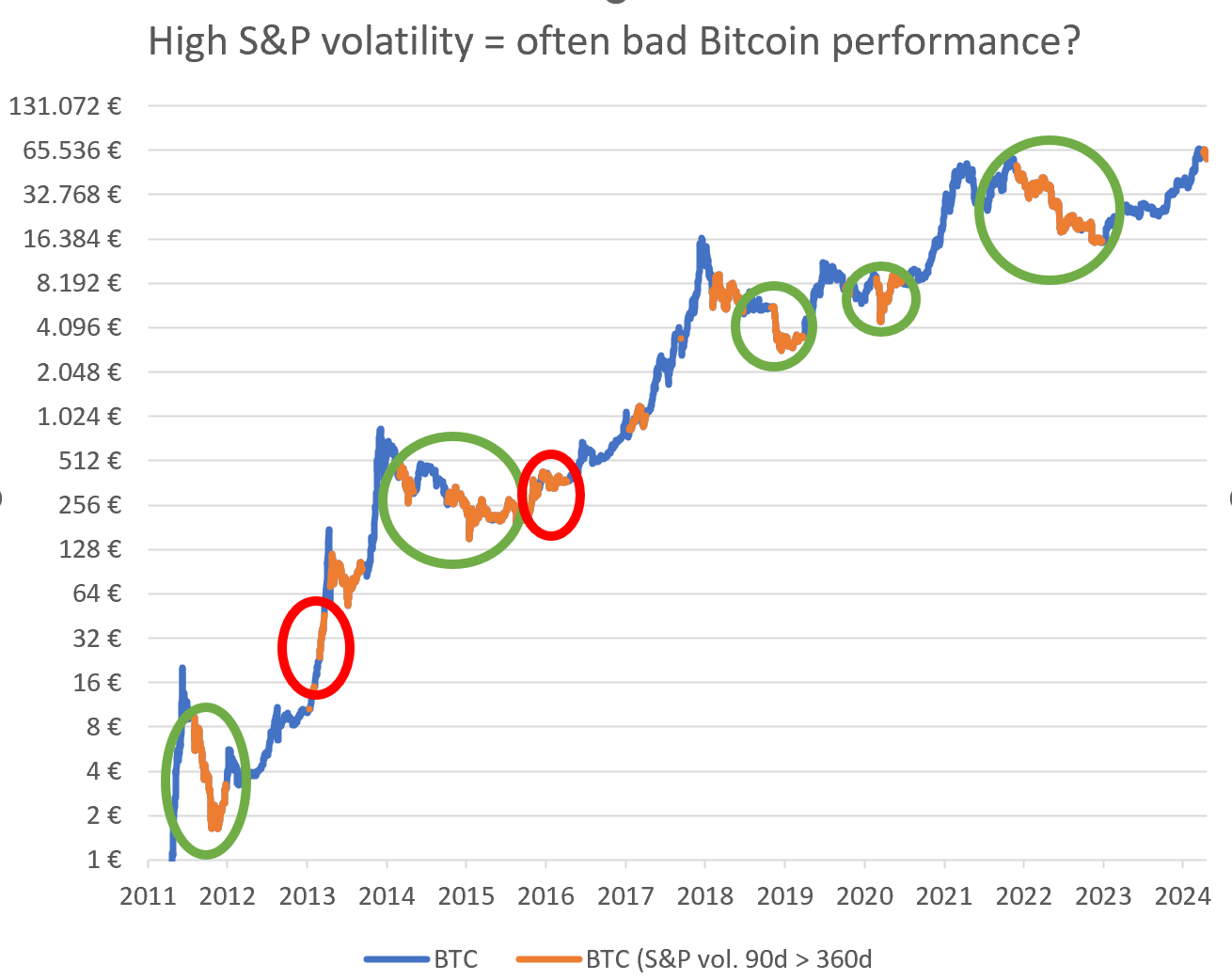 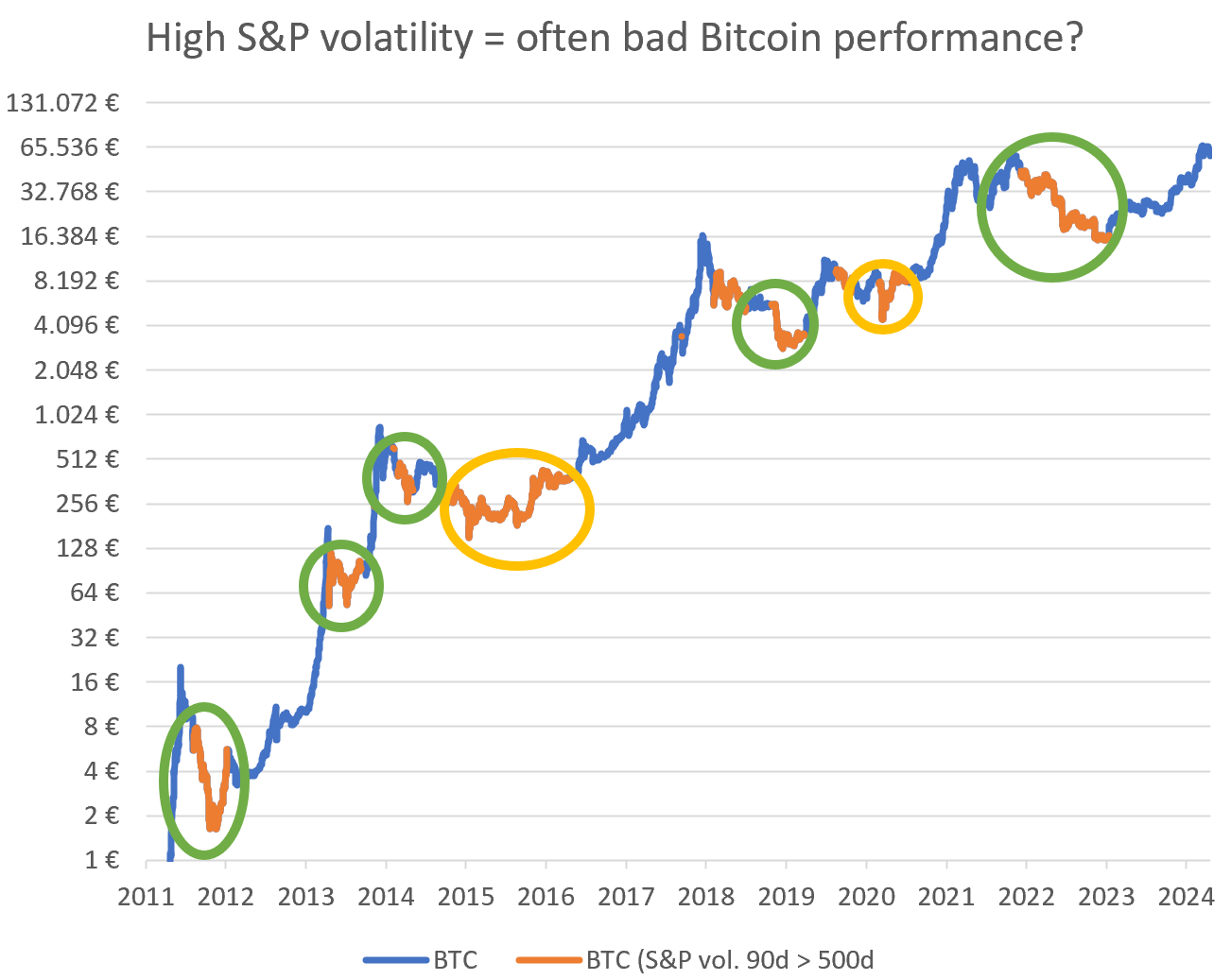 Chart description: Chart description:- blue line = Bitcoin price at low S&P volatility - orange line = Bitcoin price during high S&P volatility - green circle = expected result: high S&P volatility leads to poor bitcoin performance - red circle = unexpected result: good bitcoin performance despite high S&P volatility - yellow circle = no significant bitcoin price movement during high S&P volatility Interpretation: As you can see, most of our cycles are green, so high S&P volatility almost always gives us poor Bitcion returns. There are a few periods where our bitcoin volatility indicator "does not work" and bitcoin performs well despite above average S&P volatility. I like the stability of the results. No matter how we measure short-term (30 days or 90 days) and long-term (360 days or 500 days) volatility, our volatility indicator works reliably. evidence #2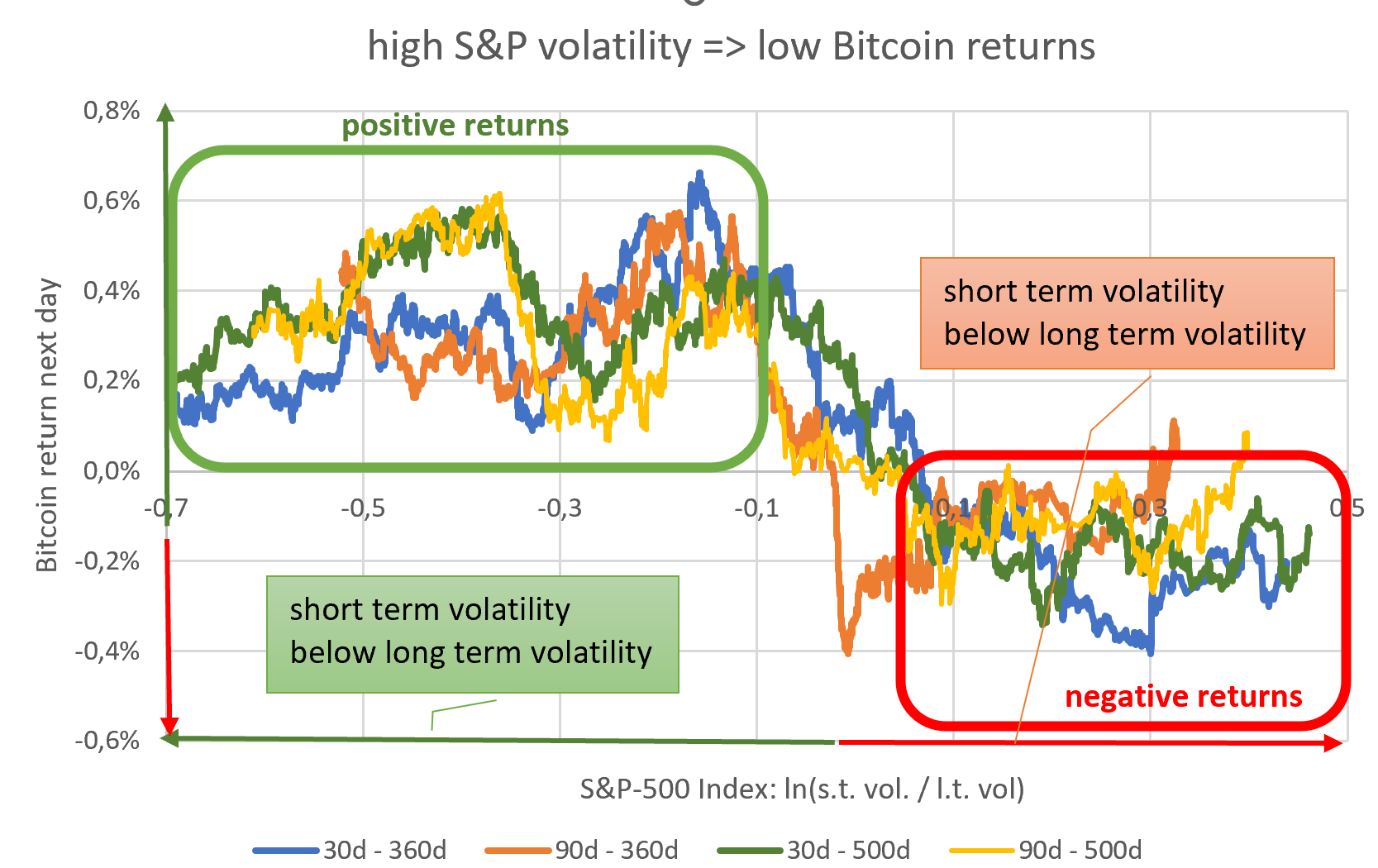 Chart description: Chart description: We can plot the relative short-term to long-term volatility of the S&P on the x-axis. We can then plot the expected daily price return on Bitcoin on the y-axis. To average out the noise, I have calculated 500 day averages of 250 data points with worse higher volatility and 250 data points with lower volatility. Interpretation: High S&P volatility gives you negative bitcoin returns the following day. Low volatility gives you positive bitcoin returns the next day. The positive Bitcoin returns are quite stable between -0.7 (very low volatility) and -0.1 (moderately low volatility). It is also stable no matter how we measure our volatility (30d/90d/360d/500d). Why do we like stable results? Stable results in the past are more likely to be stable in the future and are more likely to provide outperformance than a model based on unstable results. An example of unstable results is plotting bitcoin's next-day price returns against bitcoin's own volatility. 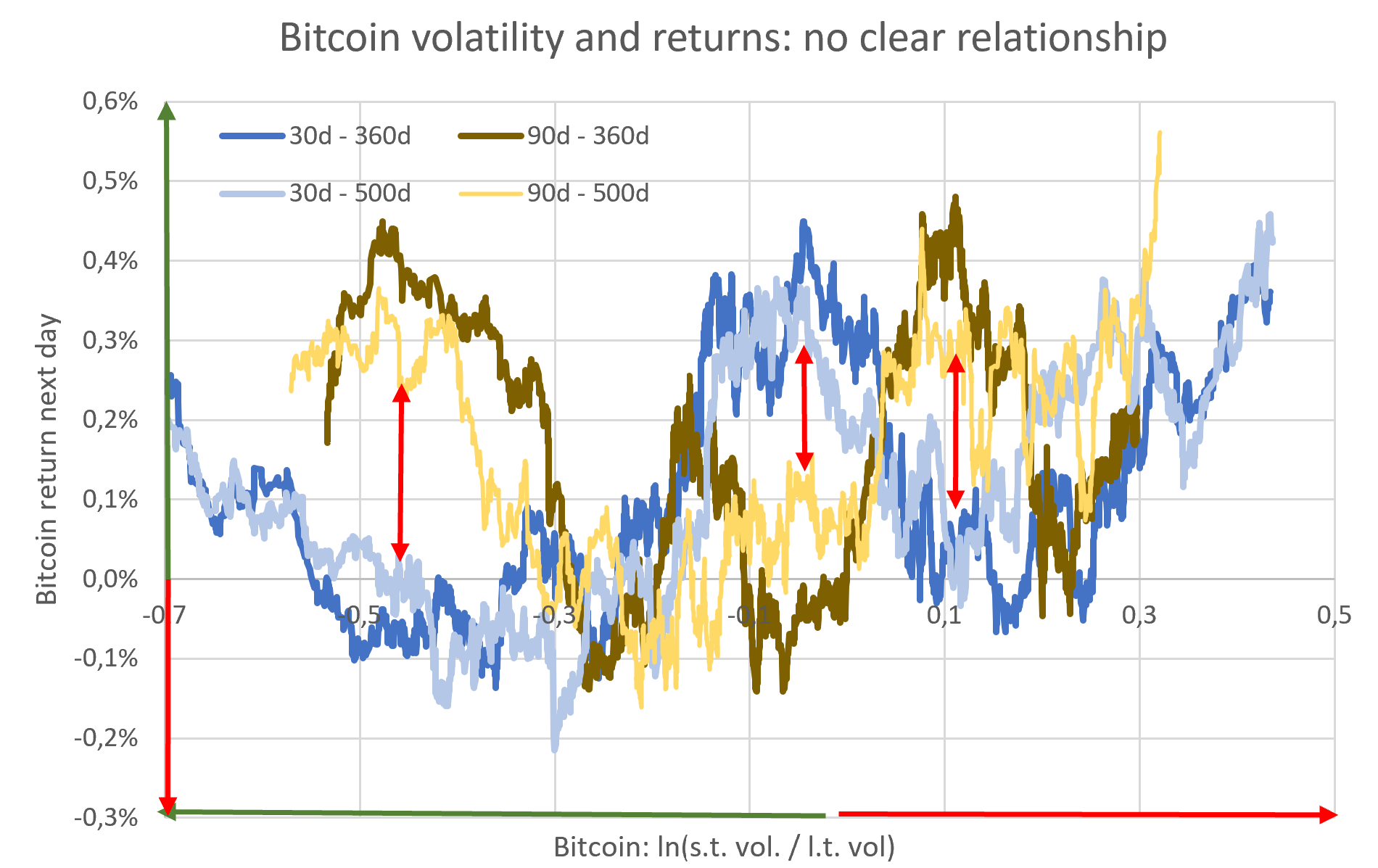 Chart description: Chart description: Same like last chart, except the x-axis representing Bitcoin's own volatility instead of the S&P's volatility. Interpretation: The 30-day results are the opposite of the 90-day results. We also cross the x-axis (which separates positive and negative returns) several times. Both show us low stability when estimating bitcoin retrurns from bitcoin volatility. Estimating bitcoin returns from S&P volatility is much more fruitful than estimating bitcoin returns from bitcoin volatility. Choosing the volatility measure an the cut-off: We have seen that there is little difference in the choice (30 days or 90 days and 360 days and 500 days) to measure our relative S&P volatility. I don't like to trade, so for similar out-performance I prefer the model with the least number of trading signals, which would be 90 days volatility versus 500 days volatility. Because of evidence #2, I use a cut-off point of -0.1. This means that our signal becomes bullish when the S&P 90-day volatility is slightly below the 500-day volatility: 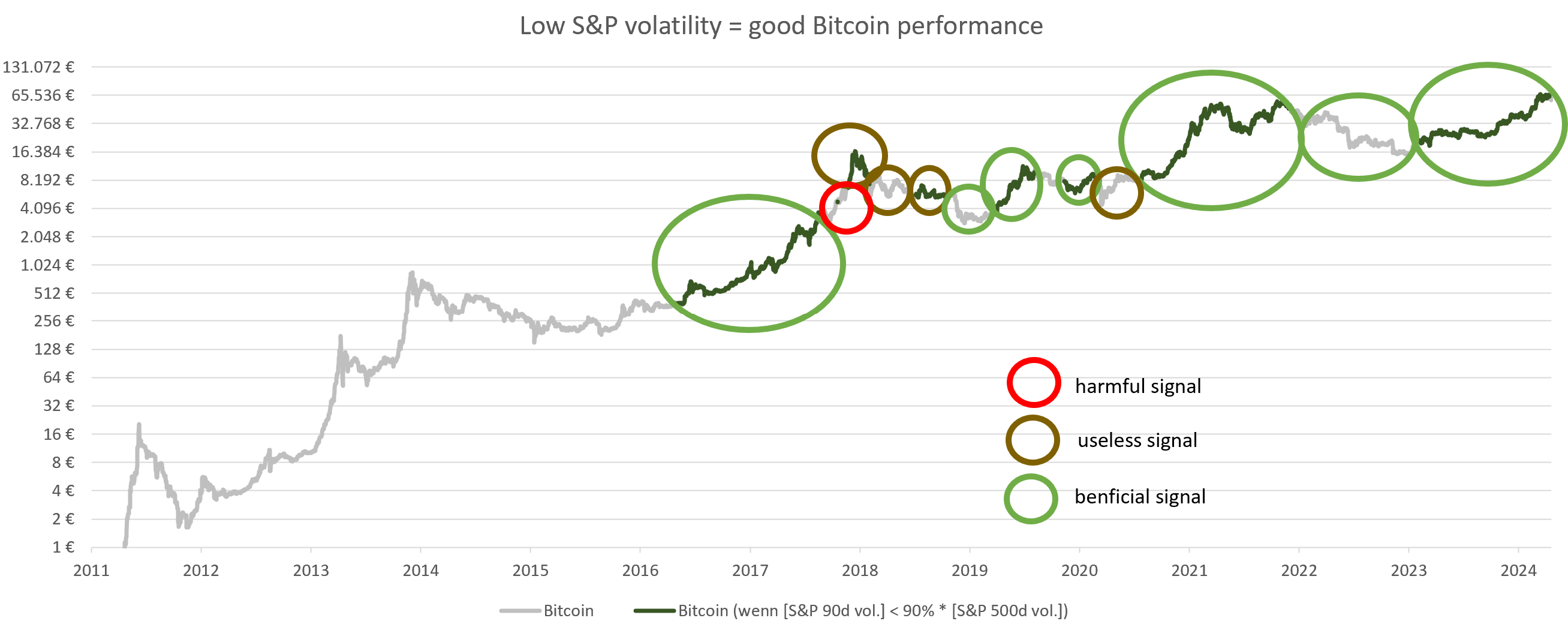 Chart description: Chart description: see evidence #1 Interpretation: We can see that most signals look decent, but we have one very harmful signal (red cycle) in recent years. At the end of 2018, we had a period of very positive bitcoin performance despite high S&P volatility. evidence #3How good is our volatility signal?  Chart description: Chart description: I draw a line starting on the first day after the low volatility period begins. Each line is described with its first day. The line stops at the end of the low volatility period. The x-axis represents the number of days in low volatility market conditions. The y-axis show how much Bitcoin price increased sind day 0. Green lines represent very good Bitcoin performances. Yellow lines represent ok performances. The black line represents the average of all other lines. Interpretation: For most of the low volatility periods we can see very decent returns for the bitcoin price. The worst period gives us a return of around 0, while the best period gives us a return of around 2 (=638%). Periods of high volatility generally show poor returns, with some exceptions showing positive returns. I can conclude that trading bitcoin according to the S&P volatility looks very promising. However, some risk remains. We are quite safe buying bitcoin when stocks enter a period of low volatility. 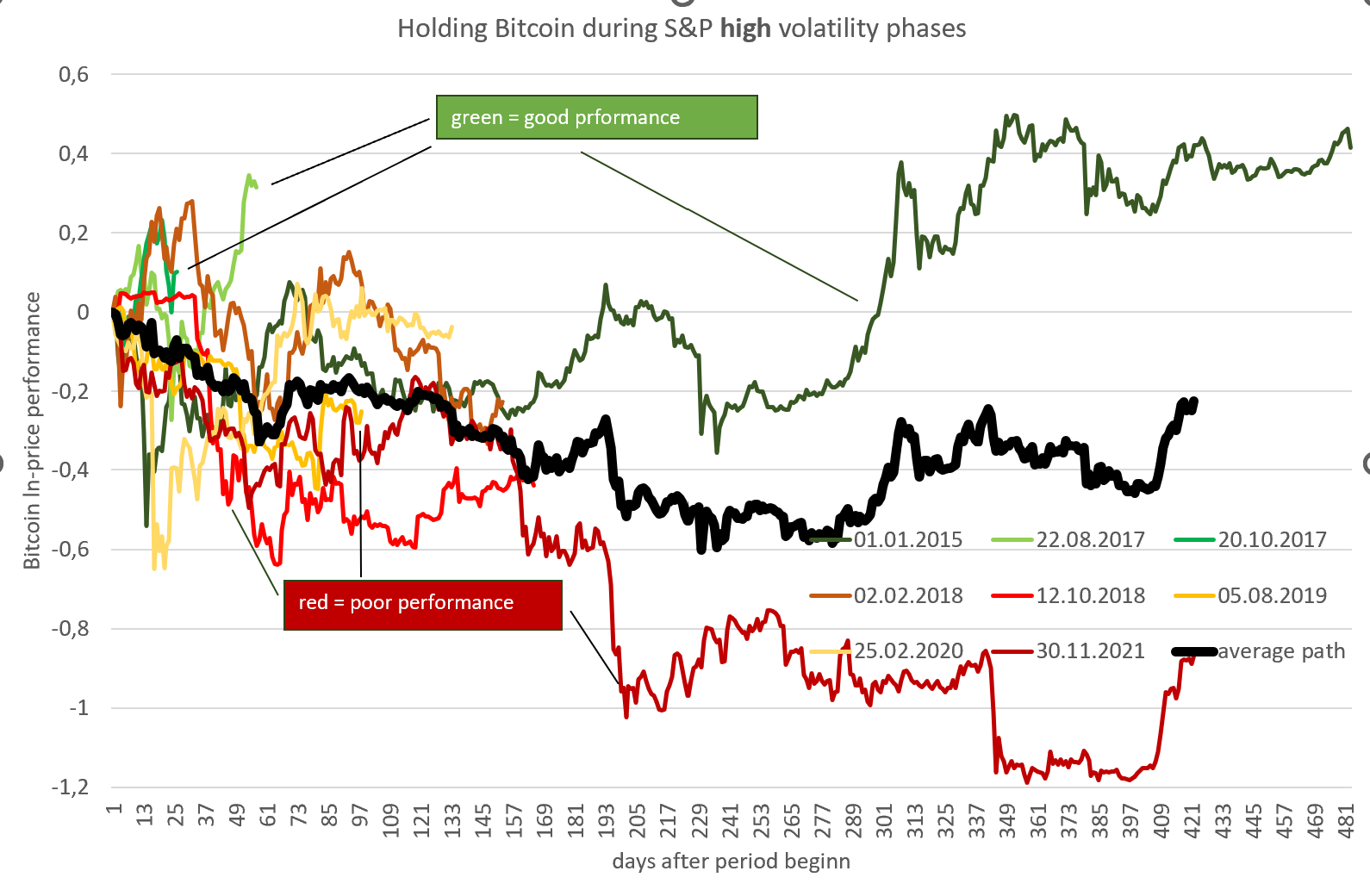 Chart description: Chart description: Same like above, but we are looking at the performance for the high volatility periods. Interpretation: Selling bitcoin when we enter a high volatility period for stocks is a bit riskier than buying at the beginning of low volatility periods. Sometimes the price of bitcoin still performs well and we have to buy back more expensive. Now we have established 3 pieces of evidence to show that Bitcoin performs much better during periods of low S&P volatility than during periods of high S&P volatility. However our volatility signal is not perfect.
How damaging are our few bad signals? Let's do a backtest.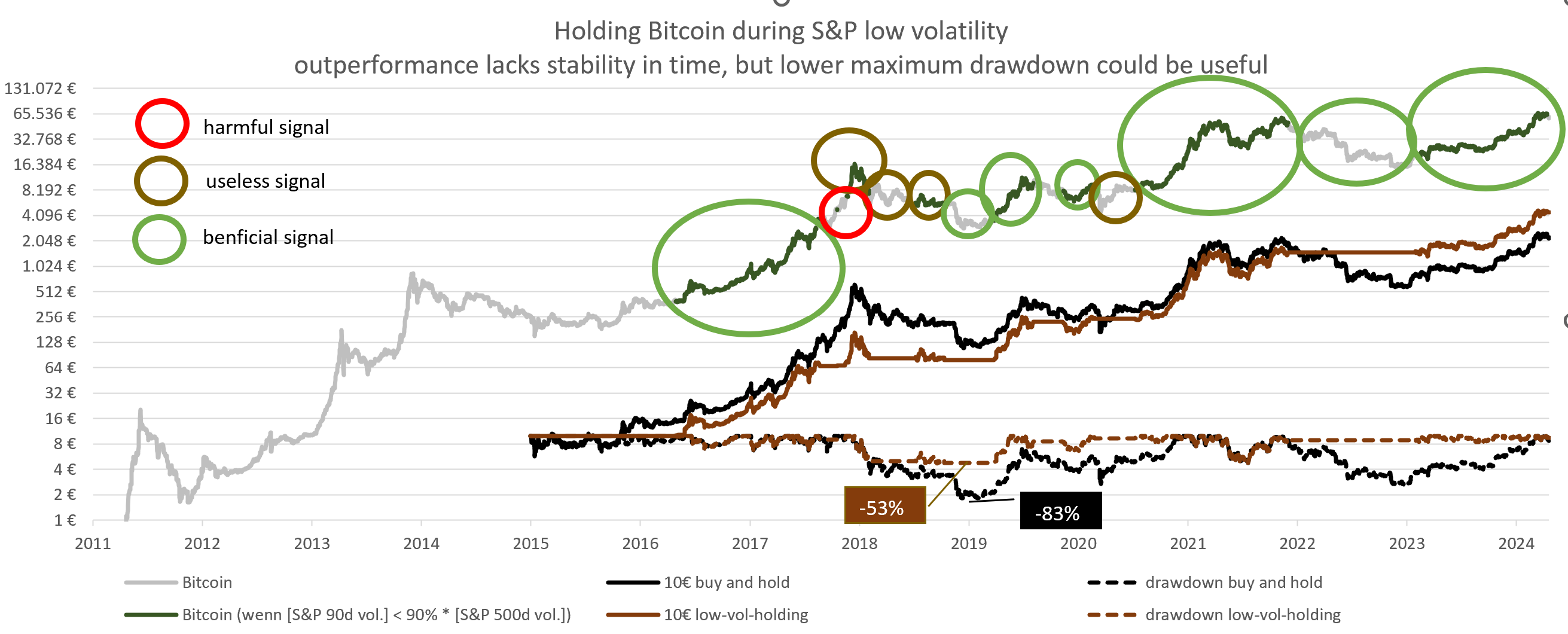 Chart description: Chart description: We compare two strategies: 1. (black line): We buy 10€ of Bitcoin on 01/01/2005 and hold it until today. 2. (brown line): We start with 10€. We hold bitcoin during periods of low volatility and cash during periods of high volatility. Interpretation: We can see that we start with some underperformance (brown line is blowing black line) which turns into outperformance later on. Perhaps Bitcoin is now trading with a higher correlation to traditional financial markets than in the past. I would say that the observed outperformance of our strategy alone is a bit weak, as we can also observe historical periods of underperformance. Together with the significantly lower drawdown of our strategy (-53% vs. -83% for buy and hold), the strategy is still okay. If you dislike drawdowns, the significant reduction in maximum drawdown could make this strategy still interesting despite the mixed outperformance track record. Comparison with cycle timing Chart description: Chart description: We add one more strategy (yellow line): Buy Bitcoin at trend*e⁻0.5 and sell Bitcoin at trend+750 days. Interpretation: When we back-test our valuation trigger for trading Bitcoin in the OP, we get even better results (yellow line). We can see significant outperformance, hardly any underperformance and only a slightly worse drawdown. 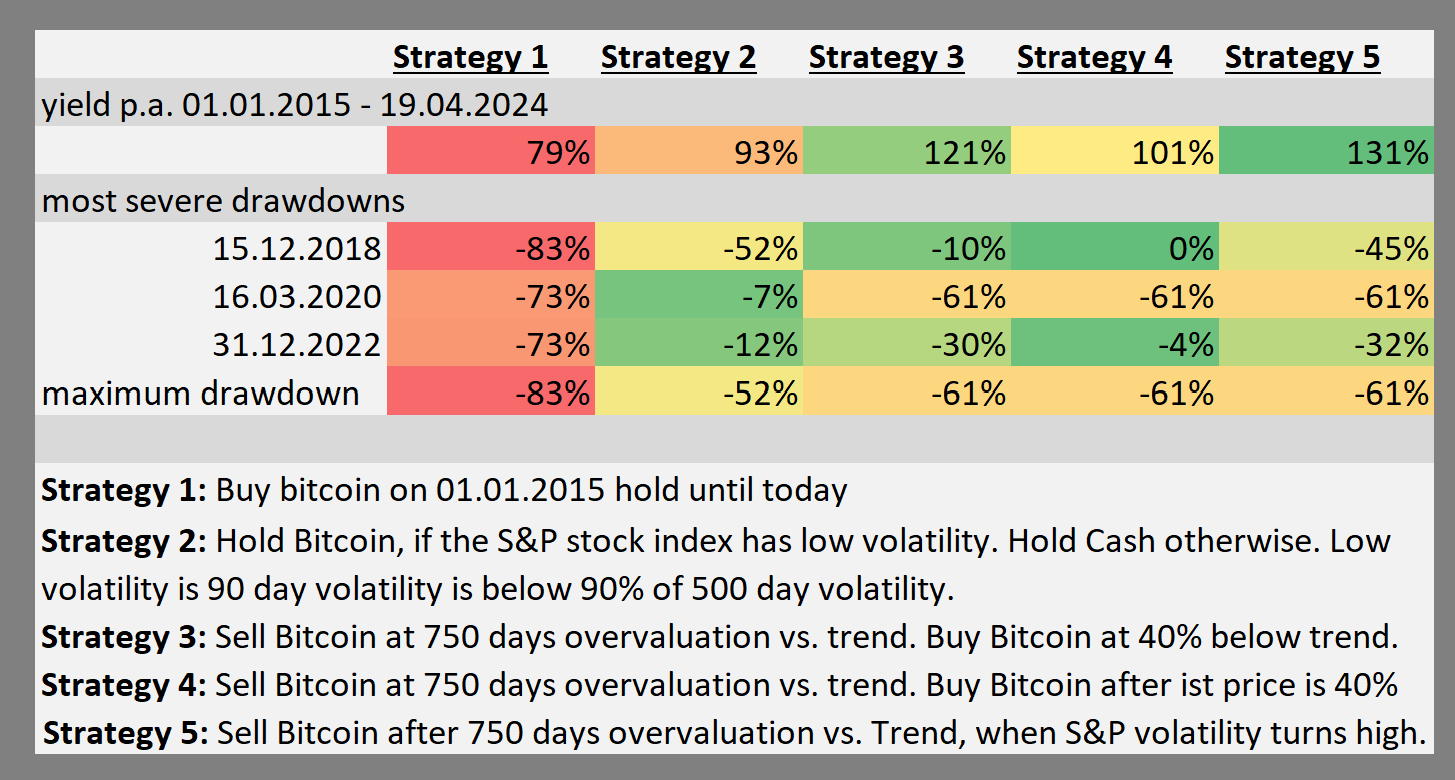 Results: Results: Both strategies, trading by volatility (strategy 2) and trading by valuation (strategy 3), outperform buy and hold (strategy 1) before tax with higher average returns and lower drawdowns. However, strategy 3, as explained in the OP, performs much better. Can combine two good strategies (2 and 3) to get an even better trading strategy?We know that buying Bitcoin cheap gives us outperformance (strategy 3). We also know that Buying bitcoin during a period of low volatility gives us outperformance (strategy 2).  Buying bitcoin cheap (green box) and entering a period of low volatility (green line) could be an excellent investment, as all green lines end up much higher than they started (marked in green), while the less useful green lines (marked in red) are not included. This idea sounds good, but waiting for (a) valuation and (b) volatility to turn favorable (strategy 4) gives us a lower return (101% p.a.) than only waiting for (a) valuation to turn favorable (121%). We are missing out on returns by sitting in cash while waiting for volatility to come down. While waiting for volatility to come down may not be a good quantitative strategy, it could still be useful from a psychological perspective. If you didn't buy enough Bitcoin during the bear market, because you were scared, but the volatility didn't turn favorable, it could give you the confirmation to buy. At this point, we are still very early in the bear market. The second combination possibility would be strategy 5:  Strategy 3: We are selling at an overvaluation (Bitcoin price = Bitcoin price trend + 750 days). However, the historical top was around +1000 days or even +1250 days. I still use the 750 days cut-off point in my strategy 3 because we only know the exact top in hindsight. I want to allow for some margin of error to not miss the top in case the next top is lower. Strategy 5 modifies strategy 3: We could wait for bitcoin to reach trend + 750 days overvaluation and only sell when the volatility trigger turns red (= entering a period of high volatility).  This strategy 5 gives us an even better return (131% p.a.) than pure cycle timing (121%) with similar drawdowns. However, despite the higher average return, I still prefer pure cycle timing (strategy 3) because we sell a bit before the peak rather than a bit after the peak. Since in real life we will need some time to sell, I would rather start too early than too late. Valuation leads to action, volatility is confirmationWe buy when Bitcoin is 40% below trend. Entering the next period of low volatility in equities is likely to mark the end of the bottom. We sell when Bitcoin price is 750 days ahead of trend. The subsequent entry of a period of high volatility marks the end of the top.
Let me give you an idea for such a DCA savings plan for accumulation between trend line (0.0) and bottom line (-1.0) with a stack of 5 limit orders (simplified regarding of the previous bear market):
I also thought about how to use our position in the cycle to modify my DCA strategy. Background: I changed my model for calculation the optimal allocation into Bitcoin from adjusted risk parity (=old model) to maximum allocation after taking into account liquidity constraints (= new model). As a result I have to sell a lot of stocks (e.g. 15.000 €) to buy more Bitcoin. However I'm already exposed to Bitcoin since end of 2021. I create 3 baskets:- very cheap basket (trend * e^-0.5): 5.000€ - cheap basket (below trend): 5.000€ - ok basket (trend to trend + 150 days): 5.000€ Investment decision triggers:❶ If Bitcoin price is below trend*e^-0.5, I will invest all my remaining funds into Bitcoin. This would be 15.000€ as of today. ❷ If Bitcoin price is above trend*e^-0.5, but below trend, I will invest 1000€ from cheap basket and 1000€ from ok basket every month. ❸ If Bitcoin price is above trend, but below trend +150 days, I will invest 1000€ from ok basket every month. ❹ If Bitcoin price is above trend + 150 days, but below trend + 750 days, I will DCA surplusses into Bitcoin, but not sell any extra shares. ❺ If Bitcoin price reaches trend +750 days, I will sell Bitcoin. I will sell 3x my monthly net salary each month until we fall below trend + 750 days. All the selling will go 50% to the very cheap basket and 50% to the cheap basket. ❻ On the way down from trend + 750 days to trend I will put my DCA into my 3 baskets and only buy Bitcoin, when Basket rules allow for it. Model maintenance triggers:My DCA management can be easily implemented in excel and does not cause much of a headache or costs a lot of time. However I'm very dependent on my model to continue to describe the Bitcoin price behavior. Therefore I have to check, if my model is still correct. We assume Bitcoin price is moving around a upwards trend.  Sometimes Bitcoin price is supported by the macroeconomic environment  ❶ Maintenance trigger "new top found": in theory the trigger looks like this: 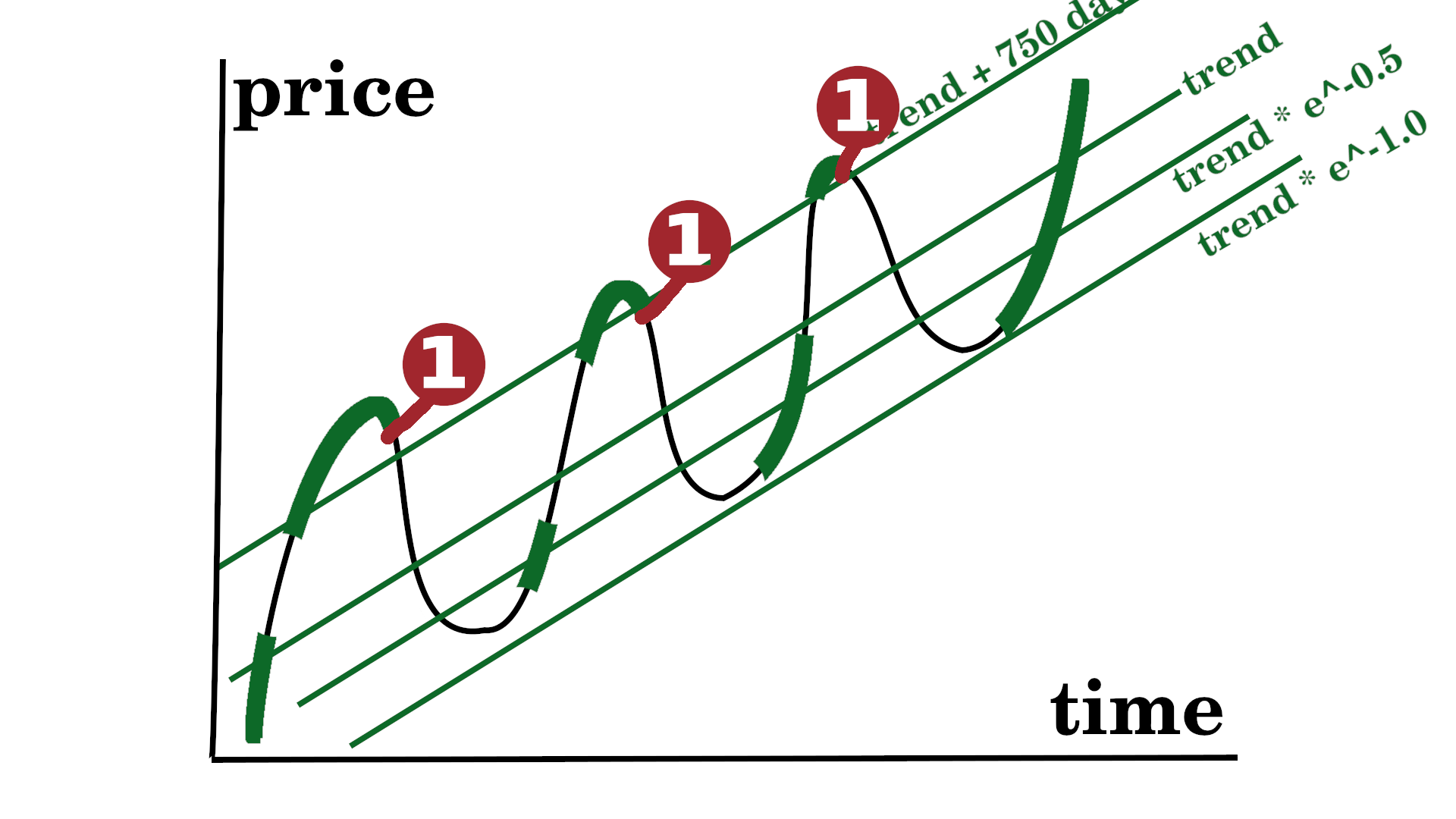 1st trigger: Bitcoin price = trend +750 days 2nd trigger: [Bitcoin price 10% below all time high] and [S&P 90d volatility > S&P 500d volatility] or [Bitcoin price 50% below all time high] I will then check, if the slope is still slightly below 6.   A significantly lower slope would require a new hedonistic optimization to get a new bitcoin allocation (e.g. 50% instead of 66%). I will also check how far above trend the Bitcoin price went, to set a new trading trigger for the next cycle (e.g. 500 days overvaluation instead of 750 days or switiching form days overvaluation to ln overvaluation). ❷ Maintenance trigger "new top missed":  trigger: no euphoria since 1621 or 1677 days  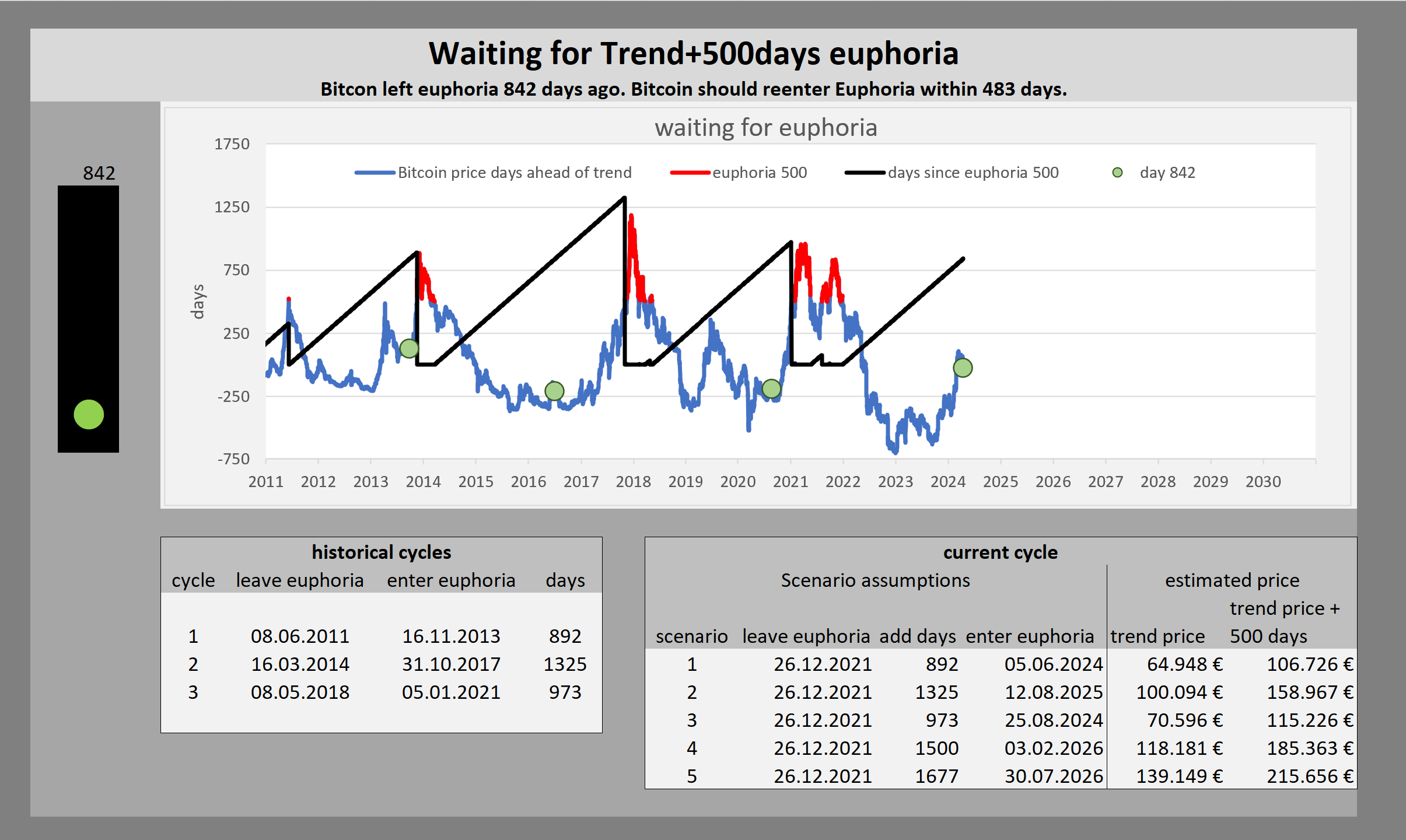 ❸ Maintenance trigger "new bottom found":  1st trigger: Bitcoin price = 40% below trend 2nd trigger: [Bitcoin price 10% above 12 months low] and [S&P 90d volatility < 90% S&P 500d volatility] or [Bitcoin price 50% above 12 months low] I will then check, if the slope is still slightly below 6. Also I will check the picture of undervaluation and volatility to re-calibrate our trading triggers and our maintenance triggers. ❹ Maintenance trigger "bottom broken":   trigger: crushing with high volatility through the floor or gradually lower and lower bottoms 
|
Sicherheit für deine Familie, dich und deine BTC, dank der fundierten Sicherheits-Tipps der KryptoArche. Wir kaufen Bitcoin zum Vermögensaufbau oder zur Krisenvorsorge. Wir kaufen Bitcoin dezentral als Schutz vor Räubern, mit guter Historie und verwahren unsere Bitcoin sicher vor Verlust, Räubern und Dieben sowie versteckt Wir nutzen sichere Passwörter, Betriebssysteme, Software und sufen sicher. Sicher dir deinen kostenlosen Platz auf der KryptoArche! Die Zeit läuft ab! Steig ein, bevor es zu spät ist! Gemeinsam bleiben wir immer über Wasser!
|
|
|
bitcoin_mining
Jr. Member

 Offline Offline
Activity: 42
Merit: 2

|
 |
April 24, 2024, 03:09:04 AM |
|
The approach you have outlined in investing is very similar to auto investing. That's why I mentioned auto investment because in case of auto investment you have to keep enough money in the wallet and go to auto investment option to confirm how often the bot will invest money from your main account. In this case, if asked to invest a certain amount of money in a row, then the bot will do so. But investing in this method is probably more about relying on yourself than on bots.
|
|
|
|
|
|
virginorange (OP)
|
TL;DR: If you have a lump sum to invest into Bitcoin, buying now gives you more Bitcoin than DCA over the next couple of months. However most people should DCA, because it is mentally easier, or it fits better to your liquidity profile (monthly salary) or you enter the bitcoin space during overvaluation.Background: I came to the conclusion that my Bitcoin allocation is too low. As a result I have to sell shares to buy Bitcoin. So my question is, do I go all in now? Or do I cost average into Bitcoin over several months?
The first and last time I invested significant money (relative to my net worth) into Bitcoin was Nov. 2021 very close to the peak. Now after several years I broke even (not inflation adjusted). This time I want to make a better decision.I compared a lump sum investment vs. a DCA investment spread out over 2 to 12 months for every day since 16.07.2010. 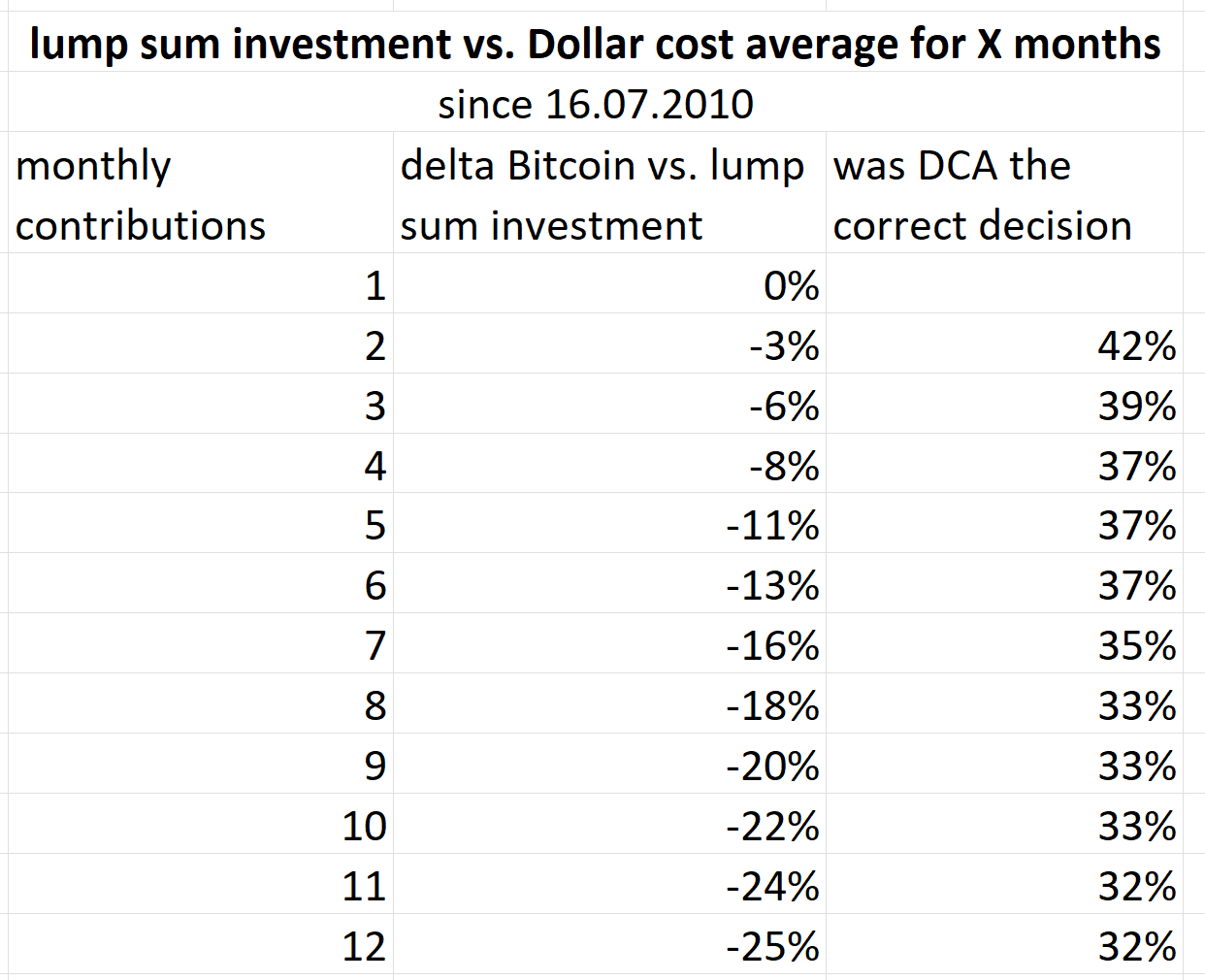 The longer you spread out your Bitcoin investment the less Bitcoin you get. If you split your initinal investment into 2 equal monthly investments, you get 3% less Bitcoin on average. Spreading your investments out over 12 months makes gives you 25% less Bitcoin on average. The decision to DCA into Bitcoin is around 1/3 of the time better than a lump sum investment (32% for 12 months DCA). 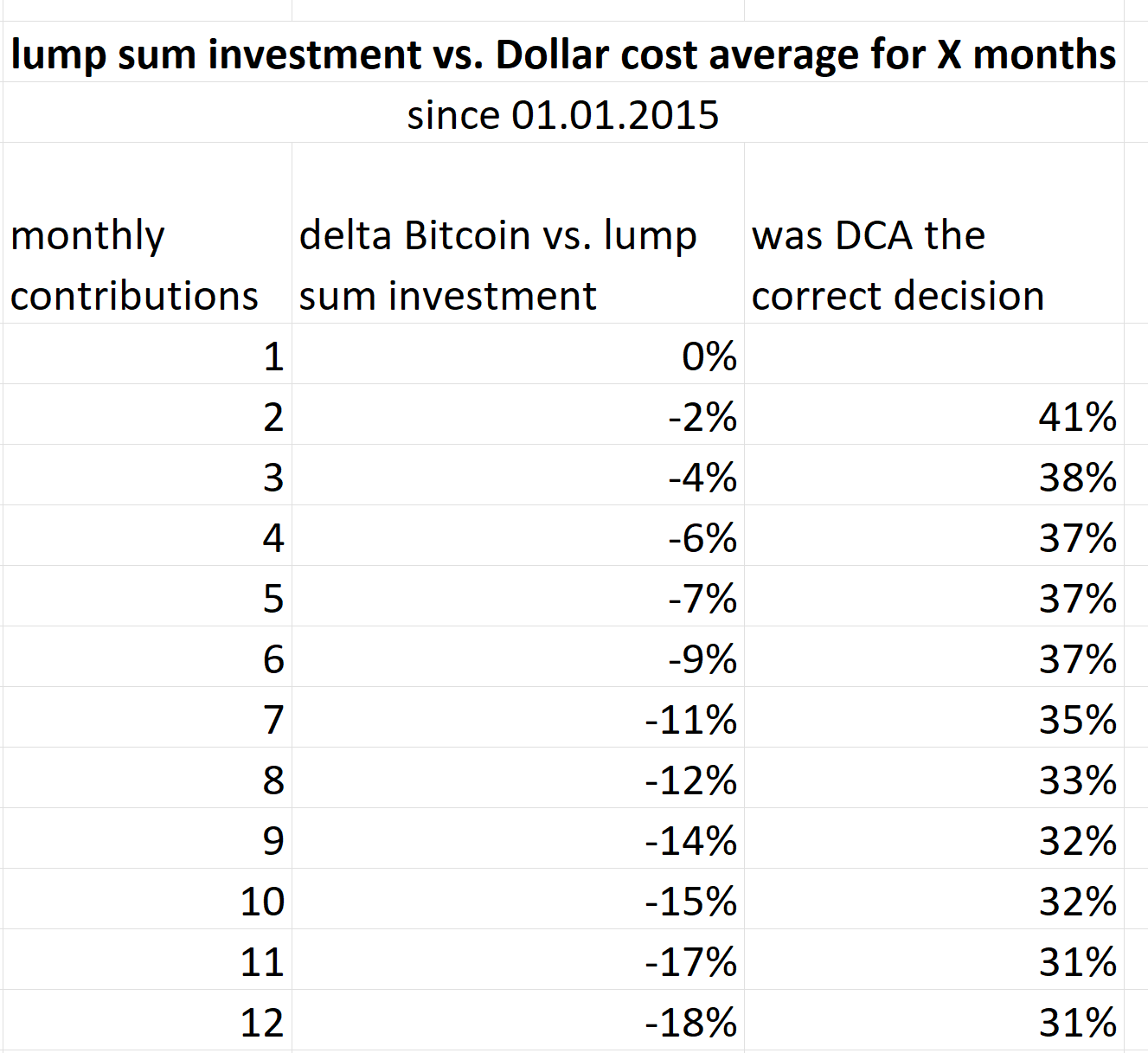 If we only take data from 2015, DCA makes you miss out on less Bitcoin (18% instead of 25% for 12 months), while DCA remains a better decision than lump sum investment 31% of days. This makes sence, since Bitcoin has a positive price trend vs. cash on average. The longer we wait to buy Bitcoin the higher Bitcoin's price trend increased. Waiting to buy Bitcoin is always a very dangerous game. So when does DCA outperform?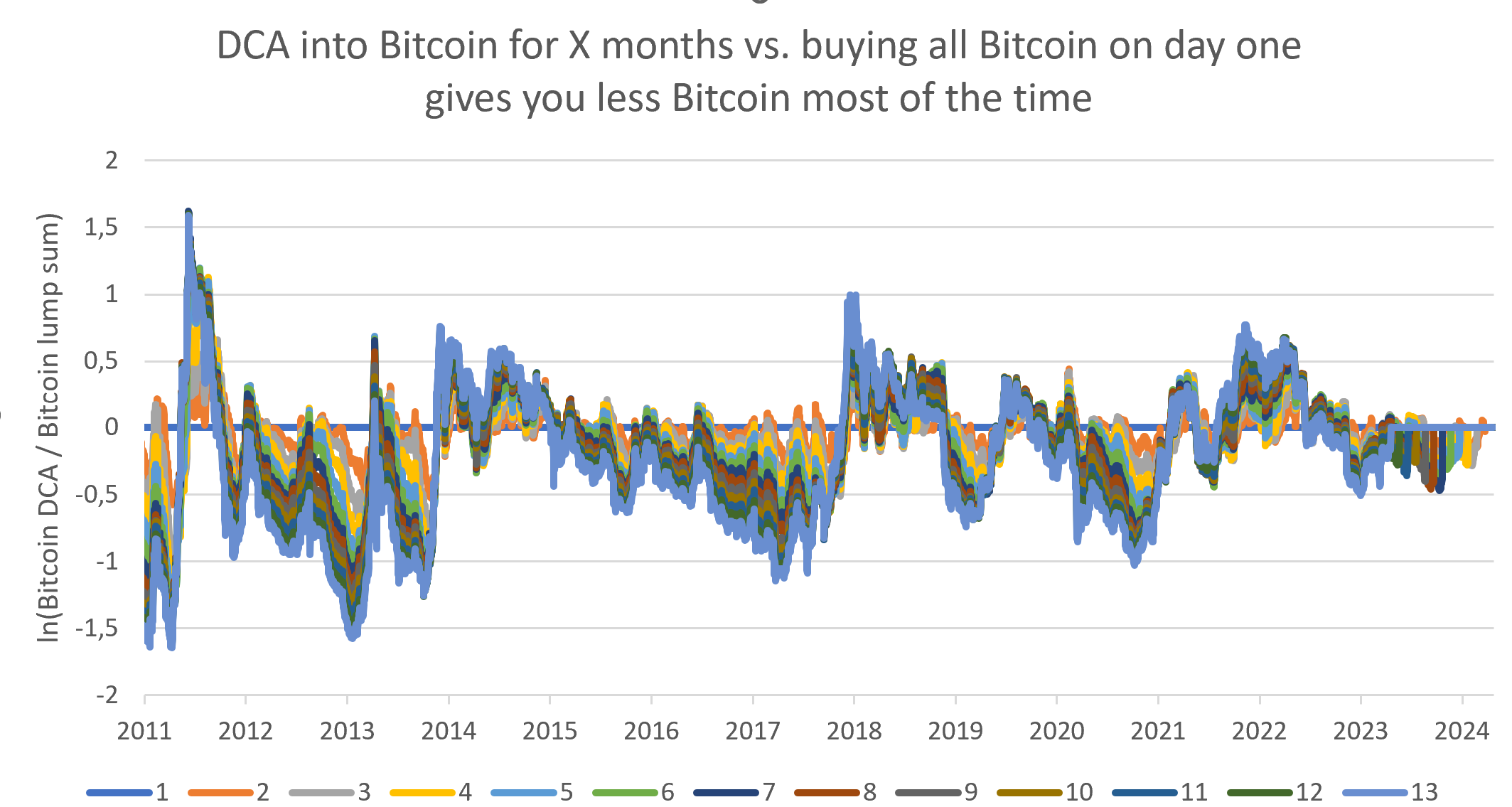 We can see most of the time the curves are blow zero meaning most days DCA underperforms, but we have some time frames DCA looks like a better idea. 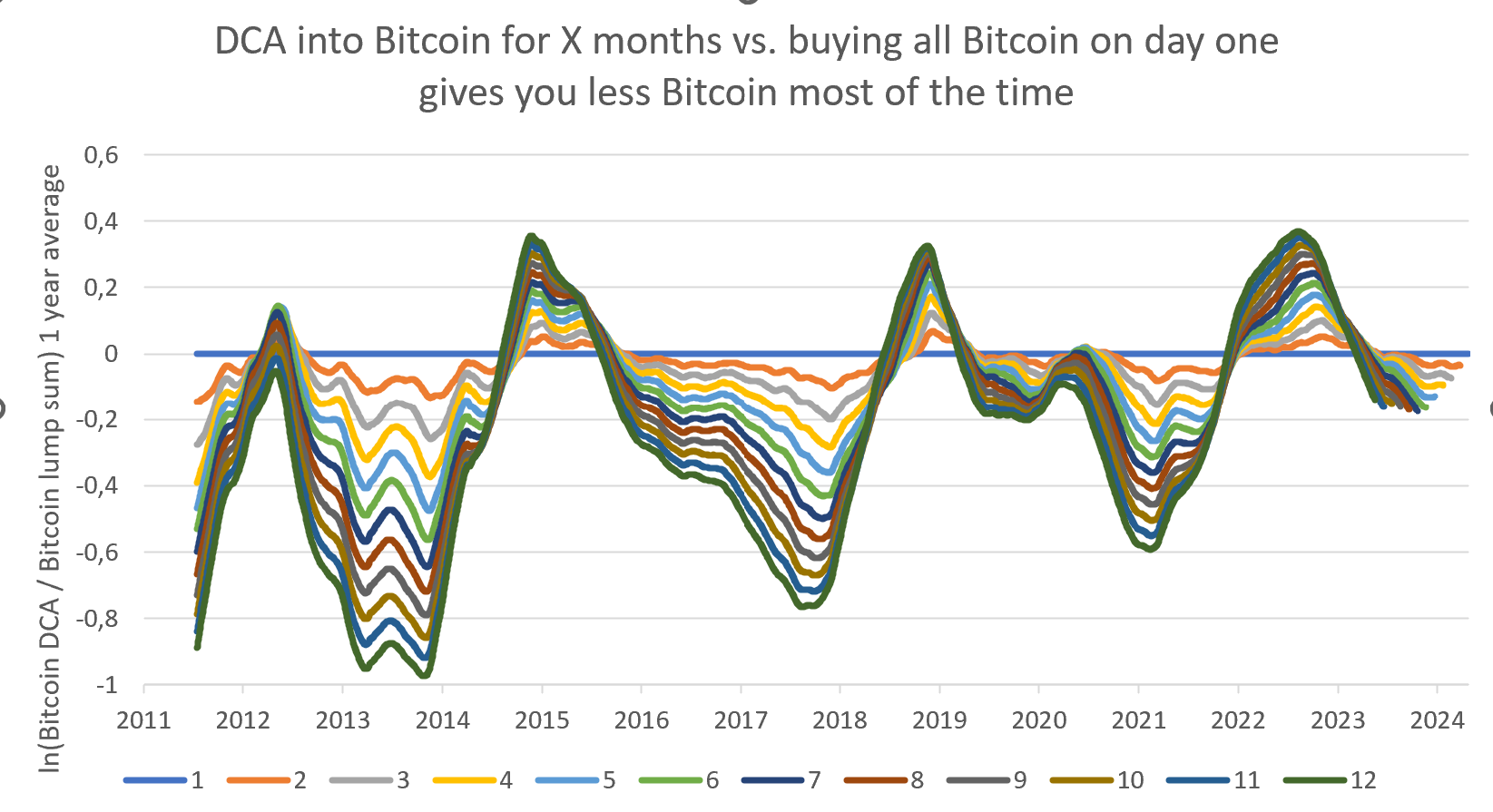 The more wie spread out our investment into Bitcoin, the more extreme our results become (bigger wins and bigger losses). DCA outperforms lump sum investment, when we start close to a peak, but underperforms otherwise. 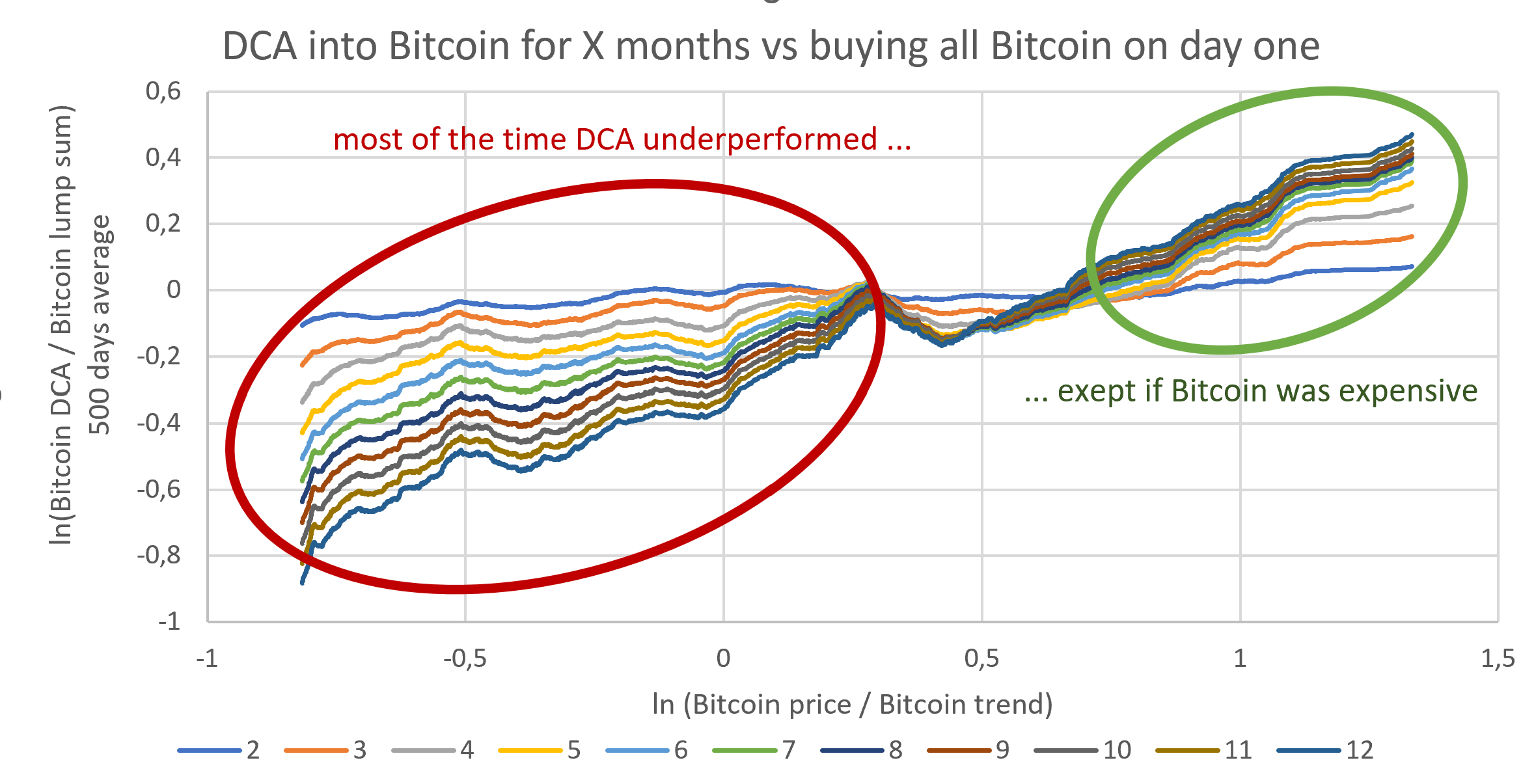 We can plot our DCA outperformance vs. our position in the Bitcoin cycle. For undervaluation and moderate overvaluation it lump sum investment was better than DCA. For significant overvaluation the longer we spread out our Bitcoin buys in time the more successful we were in avoiding buying at the peak. 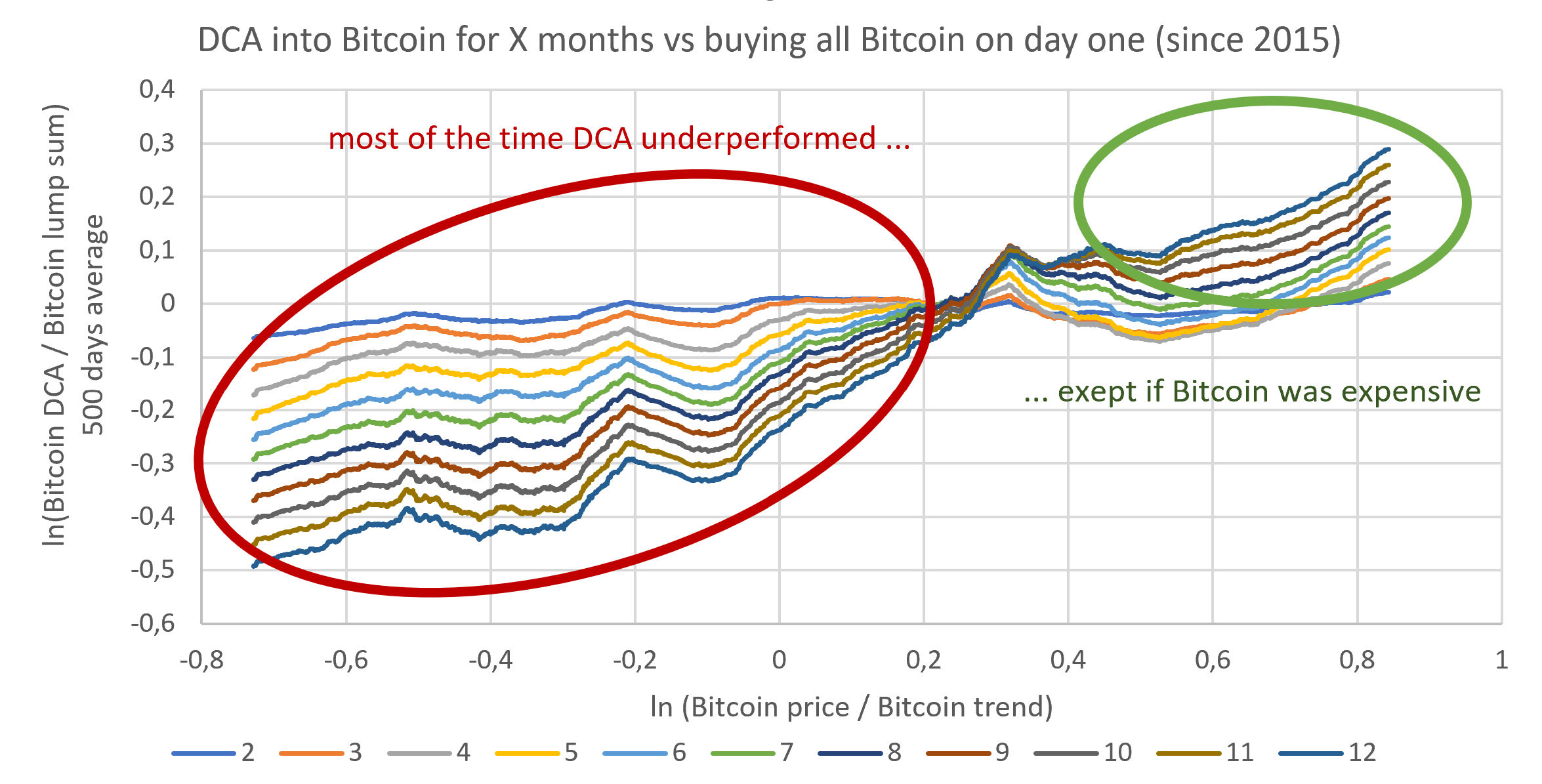 If we only look at data since 2015 the effect is smaller, but the decision is the same. For undervaluation and moderate overvaluation better buy Bitcoin as soon as possible (= lump sum, no DCA). Currently we are at 0 overvaluation.  Since 2015 we can observe 12 month DCA buying 21% less bitcoin than lump sum investments. However on the time frame between 2 and 3 months DCA performed roughly as well as a lump sum investment. Since DCA makes us buy Bitcoin later than buying at the first possibility, I would expect I'm missing out on the Bitcoin price trend with the proportion of cash not invested yet. This expectation is quantified in the column "expected DCA underperformance". We can see, the observed and the expected underperformance roughly match. Since Bitcoin price currently is roughly equal to trend, I would expect to miss out on the Bitcoin price trend growth, if I would DCA instead of investing everything now. However the trend 2024-2025 is lower than the trend 2015-2024. Therefore the expected underperformance would between 2% (2 months) and 16% (12 months) Conclusion: DCA can be useful, if the monthly Bitcoin buys matches your monthly liquidity surplus (salary minus food and rent). However if you already have some liquidity, which has to be invested into Bitcoin to reach optimal Bitcoin allocation, it is most cases optimal to buy Bitcoin as soon as liquidity is available. Spreading your buys out over several months is only optimal, if Bitcoin is significantly above trend. This this case, we should just wait until Bitcoin gets closer to trend again.
|
Sicherheit für deine Familie, dich und deine BTC, dank der fundierten Sicherheits-Tipps der KryptoArche. Wir kaufen Bitcoin zum Vermögensaufbau oder zur Krisenvorsorge. Wir kaufen Bitcoin dezentral als Schutz vor Räubern, mit guter Historie und verwahren unsere Bitcoin sicher vor Verlust, Räubern und Dieben sowie versteckt Wir nutzen sichere Passwörter, Betriebssysteme, Software und sufen sicher. Sicher dir deinen kostenlosen Platz auf der KryptoArche! Die Zeit läuft ab! Steig ein, bevor es zu spät ist! Gemeinsam bleiben wir immer über Wasser!
|
|
|
|
Turbartuluk
|
 |
April 25, 2024, 11:30:54 AM |
|
~
Regarding your S&P Volatility analysis i like the idea to use it as a psychological support in times of uncertainty, but i guess i would never use S&P related indicators for BTC trading. The reason is simple, S&P cycles are much longer than BTC cycles and i would not mix them. Regarding BTC we had some full cycles since 2010 and a lot of data Points relating to all cycle phases. Regarding S&P we only have one big bull market since 2010 only interupted by some "minor" corrections. In simple words: continuously printing money as hell (low vola) is good for S&P and BTC. Major global crises resulting in corrections (high vola) is bad for S&P and BTC. Thats my stronly shortened interpretation of causality behind those correlations presented. That could be completly different in an S&P bear market. Despite that i guess low S&P vola can be interpreted as low risk of fundamental changes in world order. I guess therefore it is still a good "soft" indicator to confirm the gut feeling. I also guess there are some opportunities to use this as an indicator across the board, e.g. for rebalancing different assets.
~
Regarding your DCA Analysis i would partly agree. Within a strong bullish trend overlaid by cyclical fluctuations it seems logical to me that a simple savings plan is mostly weeker compared to lump sum investment. BUT: I don't think that is the question!The question for me is: Can we improve the cycle based entry points by using DCA as a money management tool (not as an indicator)? Using time based DCA: Is it better to buy @ Trend price -40% / ln(-0.5) all at once or starting the saving plan for X month from than. Using price based DCA: Is it better to buy @ Trend price -40% / ln(-0.5) all at once or split basket to buy @ -0.5, -0.6, -0.7, -0.8, -0.9 and -1.0 (and eventually miss the dip with some orders an have some FIAT left)? |
|
|
|
|
|
virginorange (OP)
|
 |
April 26, 2024, 06:09:59 PM
Last edit: April 26, 2024, 06:25:42 PM by virginorange |
|
S&P volatility is a useful indicator for Bitcoin, but not for tradingRegarding your S&P Volatility analysis i like the idea to use it as a psychological support in times of uncertainty, but i guess i would never use S&P related indicators for BTC trading. The reason is simple, S&P cycles are much longer than BTC cycles and i would not mix them.
I agree, S&P volatility is not very helpful for trading as shown in my backtest. It outperforms buy and hold, but underperforms cycle valuation trading. However I will add the volatility indicator to give me a rule based confirmation that the top or the bottom is in: 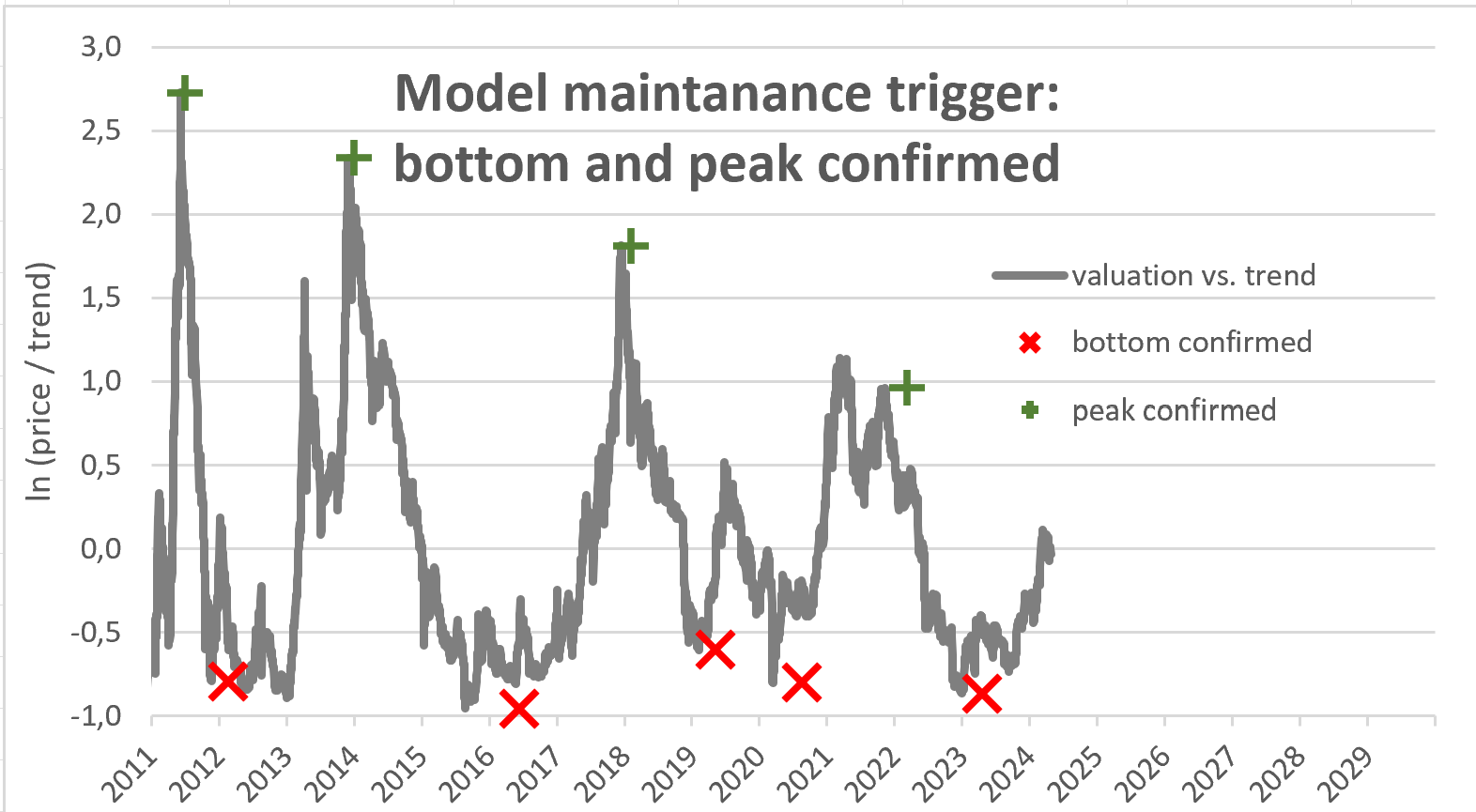 What I like about my bottom / top confirmation indicator: - rule based - no wrong signals up to now - top confirmation is quite close to the real top - bottom confirmation is still reasonable close to the bottom as a model maintenance trigger - very interesting is that during the double tops 2013 and 2022 our indicator only shows us the 2nd top What I dislike about my bottom / top confirmation indicator: - The trigger is not useful for trading since the Bitcoin price has moved quite a bit when my indicator calls the top or bottom.  for trading I will stick to valuation for trading I will stick to valuationRegarding BTC we had some full cycles since 2010 and a lot of data Points relating to all cycle phases.
Regarding S&P we only have one big bull market since 2010 only interupted by some "minor" corrections.
The problem is not the lack of S&P-volatility signals for Bitcoin, we had more than 10 signals since 2015, ...  ... the problem might be a possible change in the relationship between S&P volatility and Bitcoin during a long term S&P bear market. One example for a change in relationship would be the gold price. During the bond bull market gold moved inverse to real interest rates, but in the bond bear market during last few years gold decoupled from real interest rates. So relationships can change. I would guess a liquidity or a risk event pushing the S&P volatility above average would definitely be bad for Bitcoin price in the short run. Especially since Bitcoin and legacy financial markets are connected via. ETFs and Futures. The question for me is: Can we improve the cycle based entry points by using DCA as a money management tool (not as an indicator)?
Using time based DCA: Is it better to buy @ Trend price -40% / ln(-0.5) all at once or starting the saving plan for X month from than.
 Is it better to buy @ Trend price -40% (= trend*e^-0.5) all at once. Starting the saving plan for X month from than yields you an underperformance for all X. For X = 12 you get an underperformance of e⁻0.4 = 33% DCA costs performance, but may be necessary to keep your bank happyUsing price based DCA: Is it better to buy @ Trend price -40% / ln(-0.5) all at once or split basket to buy @ -0.5, -0.6, -0.7, -0.8, -0.9 and -1.0 (and eventually miss the dip with some orders and have some FIAT left)?
Missing the dip and being partly invested in cash will yield you a significant underperformance over a whole cycle. We could reduce the underperformance by canceling the -1.0 after a certain time and placing a market order at -0.2 instead. On average you will loose with the -1.0 bet. Not only are you more likely to go from -0.5 to 0.0 than to -1.0, but additionally you have a positive trend. Nevertheless I'm interested in this question as well to place the orders around a peak and a bottom. Not so much in order to get further outperformance, but form an operational stand point to not overburden my bank accounts with inflows triggering AML procedures in the bank. I can prove all my buys and all taxes are paid. However it is still a hassle I would like to avoid. Also some banks might dislike Bitcoin, despite buying Bitcoin is legal. As Bitcoin prices increase, it is possible I can only sell 3% of my Bitcoin peer to peer. A centralized exchange CEX would make additional 10% sales possible. If I sell at the best possible moment, I could only sell 3% (incl. CEX 13%) of my holdings. Spreading it out over 4 months would make it possible trade 12% (incl. CEX 22%).
|
Sicherheit für deine Familie, dich und deine BTC, dank der fundierten Sicherheits-Tipps der KryptoArche. Wir kaufen Bitcoin zum Vermögensaufbau oder zur Krisenvorsorge. Wir kaufen Bitcoin dezentral als Schutz vor Räubern, mit guter Historie und verwahren unsere Bitcoin sicher vor Verlust, Räubern und Dieben sowie versteckt Wir nutzen sichere Passwörter, Betriebssysteme, Software und sufen sicher. Sicher dir deinen kostenlosen Platz auf der KryptoArche! Die Zeit läuft ab! Steig ein, bevor es zu spät ist! Gemeinsam bleiben wir immer über Wasser!
|
|
|
|
Turbartuluk
|
 |
April 28, 2024, 10:46:41 AM
Last edit: April 28, 2024, 01:04:00 PM by Turbartuluk Merited by virginorange (1) |
|
Is it better to buy @ Trend price -40% (= trend*e^-0.5) all at once. Starting the saving plan for X month from than yields you an underperformance for all X. For X = 12 you get an underperformance of e⁻0.4 = 33%
DCA costs performance, but may be necessary to keep your bank happy
You have to keep in mind your derivation of Cut-Off points. Based on past data you selected a "good" cut-off point for lump sum investment. Comparing DCA with this "good" lump sum investment might be kind of recursive and results might be prone to overfitting. Your conclusion is true for past Data, but i guess you can not expect it to be true in general, at least it was partly false during the last cycle. Even if there is some build in safety factor there is still some risk left that an undervaluation of -0.5 will not be reached in the future anymore (e.g. this Scenario)DCA can be used to spread this risk and be sure that you are at least partly invested to profit "somehow".
Regarding the performace side there might be second perspective... If you want to invest a fixed amount of money i guess you are right: A price based DCA is likely designed in a way that you dont fall off the grid, therefore you will have some open orders left if everything turnes out as expected and you will "loose" some performance. The benefit on the other hand is, that the strategy is more robust to misjudgment of Cut-Off Points, like i said before. Looking Back the last 10y the correct portfolio weighting of BTC would have been 100% or even above. Obviously that was not the strategy from most of us. Choosing a lower weighting results in more confidence in the investment strategy. You can use DCA in the same manner if you keep your weighting flexible. Choosing a backloaded DCA e.g. with orders down to ln(-1.0) will result in a "good" average buy price, as long you dont fall of the grid (roughly right Magnitude of cut-off value). For the invested money DCA seems to improve the strategy. The "underperformance" due to liquidity left over is meanwhile only based on missed profits or untaken opportunities. At least for me i can say that in my point of view the "cost" of unused liquidity is just inflation and not missed profits as they happen every day. Therefore it does not really hurt me to be less invested than i could. Therefore the perspective might change with an approach of "flexible weighting". |
|
|
|
|
|
virginorange (OP)
|
 |
April 28, 2024, 07:17:20 PM |
|
DCA can be used to spread this risk and be sure that you are at least partly invested to profit "somehow".
You are correct. I was conservative with my cut-off points, but a significant change in the Bitcoin price behavior could make me miss the top or the bottom. Therefore I won't trade 100% of my Bitcoin and I will DCA (mainly because of banking restrictions but also to reduce risk).
Adjusting our strategy (sell at trend+750 days, buy at trend*e^-0.5) for bank account limitations.Problem:
Peter has 1 Bitcoin. He feels comfortable trading 0.5 Bitcoin while holding the remaining 0.5 Bitcoin. The optimum strategy would be sell 0.5 Bitcoin at trend+750 days for cash and use this cash to buy back more Bitcoin at trend*e^-0.5. However selling 0.5 Bitcoin at trend+750 days would lead to an cash inflow into his bank account of 65.000 EUR far exceedingd his salary cash inflow of 2k. This will trigger anti money laundering actions from his bank. The bank might file a report to the government, block the cash inflow or require additional information from Peter about the source of the funds. Peter always remained within the law and paid his taxes in full. However he would still like to avoid the hassle of filing a lot of paper works.
He therefore doesn't want his cash inflow from selling Bitcoin to exceed 4k a month (2x his salary). As a result he can't sell his 0.5 Bitcoin for 65.000 EUR at once but would need several months to sell his Bitcoin. However the Bitcoin peak only lasts a short time. So either (i) Peter won't be able to sell his 0.5 Bitcoin in full or (ii) he will have sell his Bitcoin over several months for a lower price above trend or mixture of i and ii.
Solution:
4k a month is 1k a week, which is 3.2% of 0.5 Bitcoin at trend price of 62k. For a 3.2% weekly cash turnover bank account limit the optimal time to start selling is roughly at trend+200 days (currently 76k EUR) and the optimum time to start buying back is at trend*e^-0.3 (currently 46k EUR).
Finding the optimal valuations for buying and selling BitcoinWe have learned that we could outperform buy and hold by buying Bitcoin cheap in the cycle and selling Bitcoin expensive in the cycle. Best time to buy Bitcoin was at trend*e^-0.5. Best time to sell Bitcoin was trend+750 days. How do the two limits (-0.5 and 750) change as a function of how limited our bank account turn over is relative to the value of our Bitcoin we are willing to cycle-trade. We can be sure the limits (-0.5 and 750) will move closer to trend (e.g. -0.3 and +300) especially for severely restricted bank accounts, because we can't buy or sell all Bitcoin at the optimal moment. We have to choose a less optimal moment or not trade at all. BacktestsWe can calculate our out performance for multiple scnearios. For each bank account restriction (buy/sell X% of our tradable Bitcoin per week), we ceck for different buy and sell triggers the outperformance. The goal is to find the combinations of triggers that gives us the optimal outperformance. For the optimal combination (marked in bold) a graphical output of our backtest is shown.  Even if our bank account is severly restrictive (0.1% weekly trading) the optimum limits only go to (-0.25 and +180) 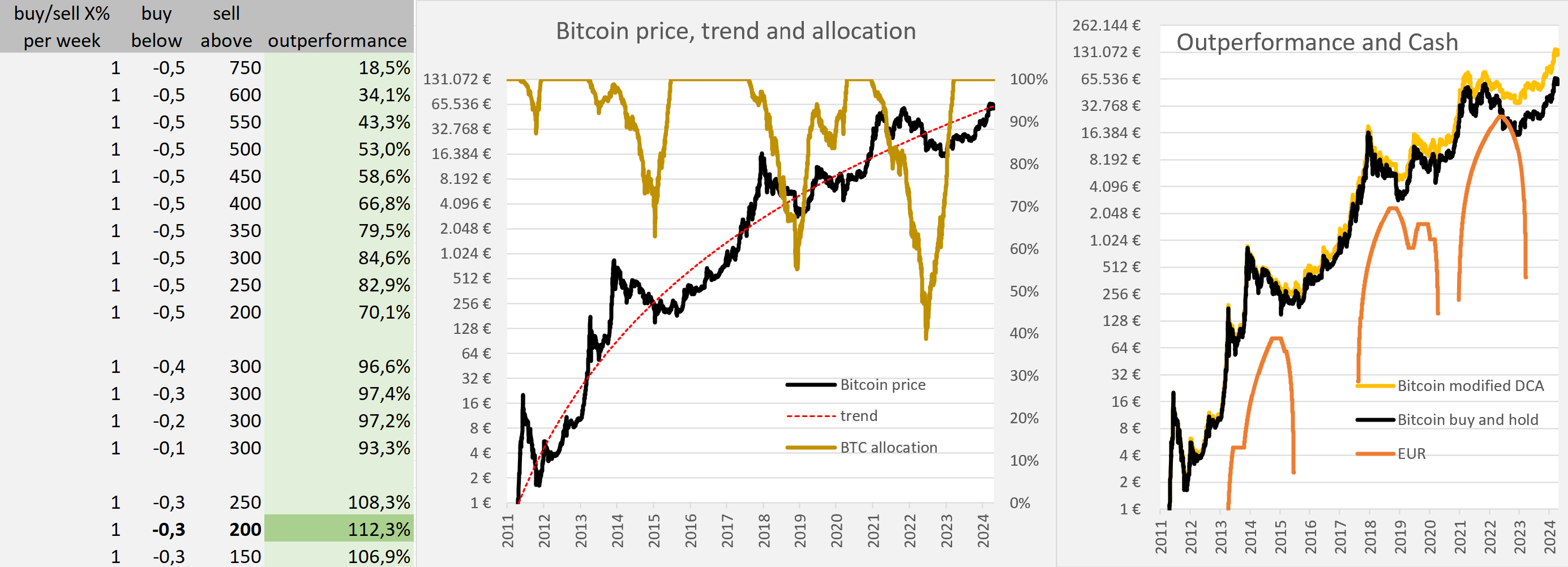 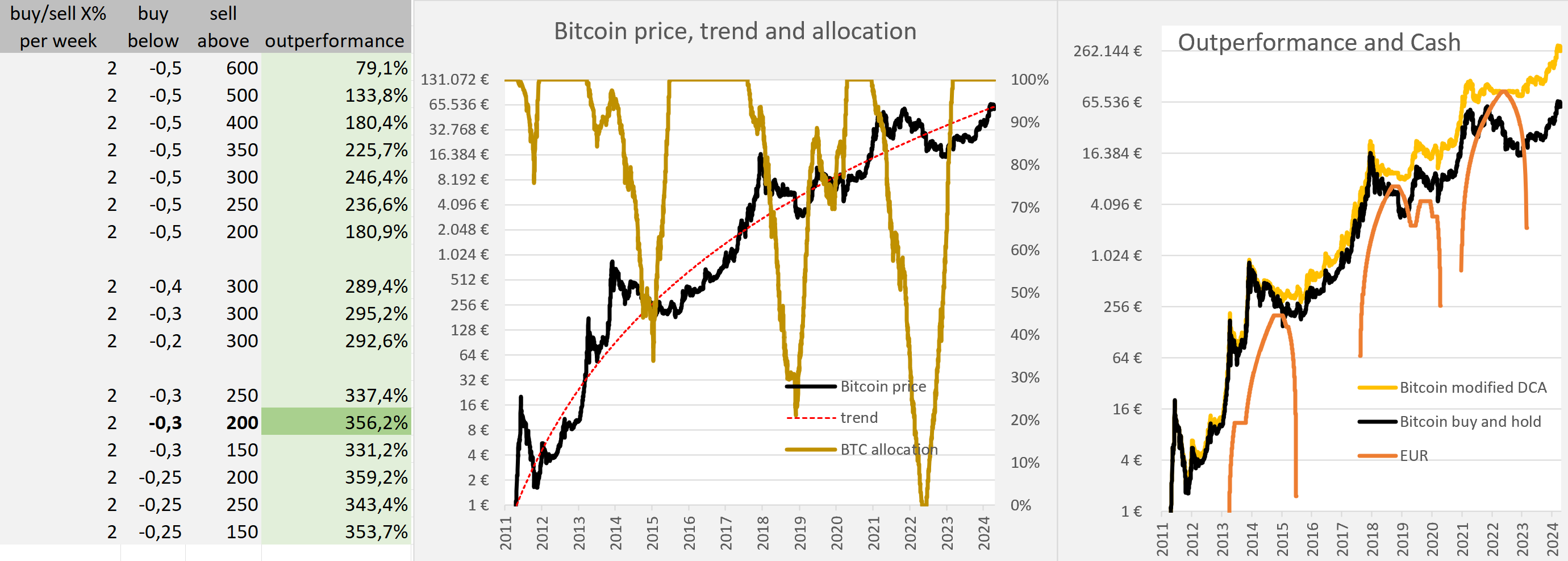 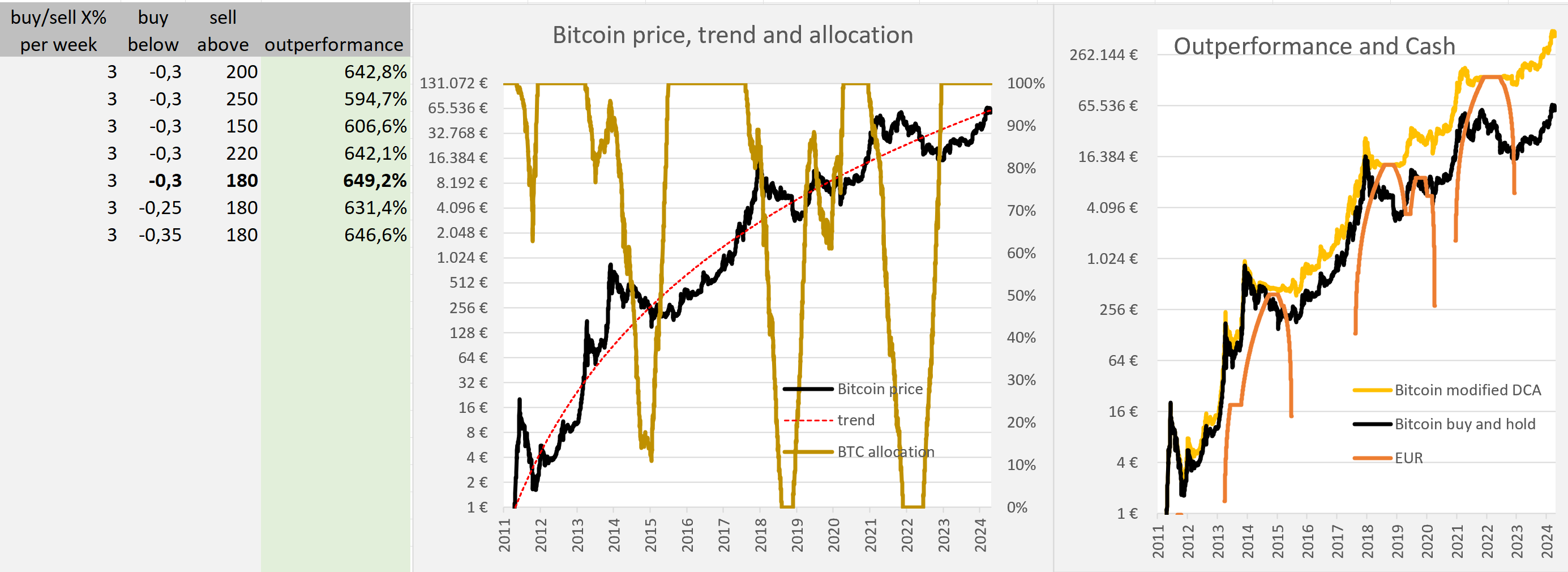 For 1%-3% trading restriction our limits are around (-0.3 and +200).  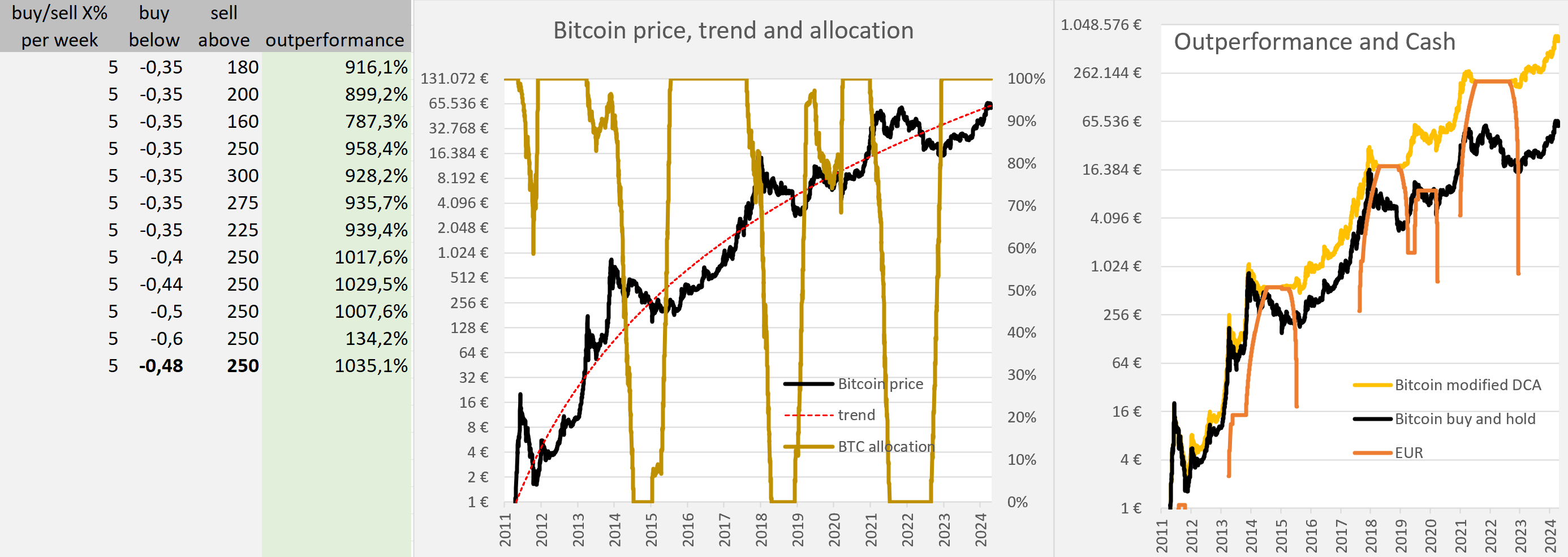 For a restriction of 5% our lower limit (-0.48) is almost at the optimum level without any restrictions (-0.5), but the sell limit is still much lower (250 instead of 750). The reason for this is, that the tops are short, but the bottoms take many days longer. For our trades to complete we therefore need to ease the restriction for selling more than the restriciton for buying. 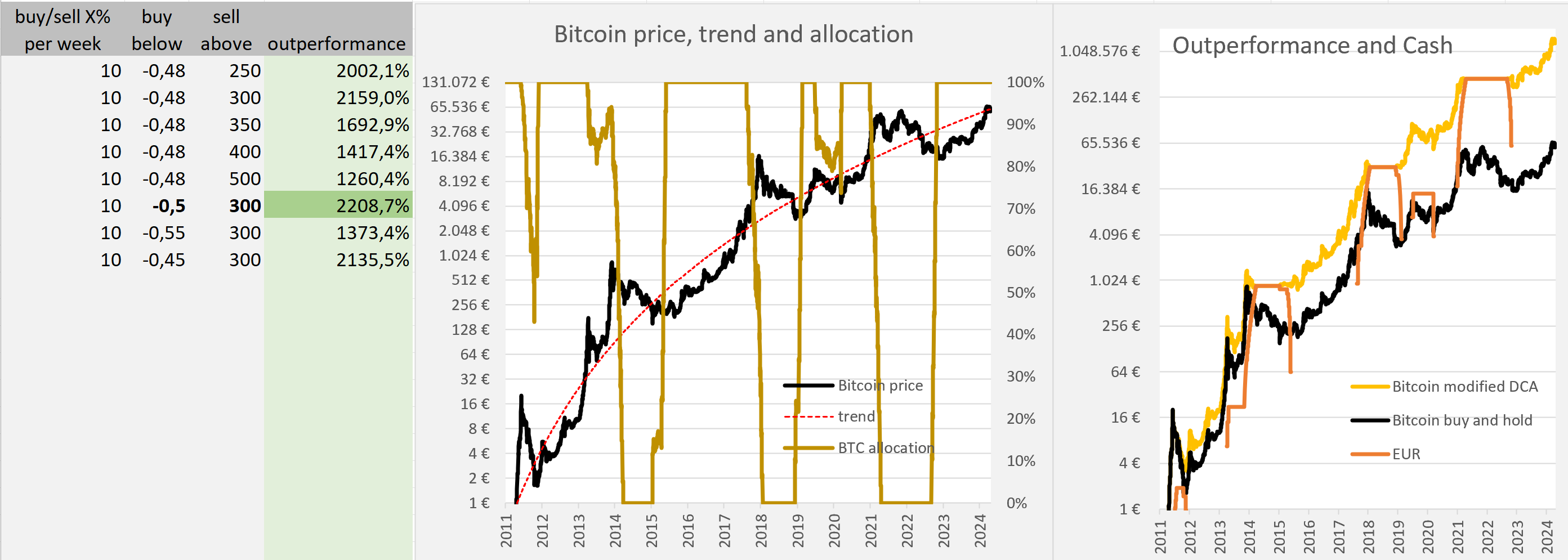 Even if our bank account is not very restrictive and allows us to trade 10% a week our sell trigger has to be eased quite a bit from 750 to 300.
Why not use all your Bitcoin for cycle-timing?Timing the cycle outperforms buy and hold by a wide margin, so why not use sell all our Bitcoin high and buy back low? Safety: Do we feel comfortable owning zero Bitcoin? Selling all your Bitcoin and leaving all that money in a bank may be risiky depending on your juristiction (Libanon, Egypt, Nigeria) and your relationship to the people in power (your are known as a critic of a powerfull corrupt politician in your contry). Privacy: You don't want to be targeted by robbers, who may hurt you and your family members to get you to transfer all your Bitcoin to them. So you don't want to spread the information how much Bitcoin you own around too much. Buying Bitcoin once, especially without KYC, checking your balances with your own node or over TOR, leaves less traces. Buying and selling all your Bitcoin every couple of years on a centralized exchange, leaves a lot of data for hacker and robbers to use. Non-fungibility: Maybe you think some UTXOs could have lower regulatory risk, so you might only sell UTXOs with higher regulatory risk and keep UTXOs with lower regulatory risk. -> We have to earmark which UTXOs and how many Bitcoin are we willing to sell.
Steps to perform for finding the optimal buy and the sell levels: Estimating the maximum fiat turnover: - How many and which bank accounts can you use? - How much turn over each bank account can stomach each month? Estimating maximum Bitcoin trading: - Earmarking UTXOs for selling: which UTXO in which order would I like to sell? - [Bitcoin earmarked for potential selling] * [Bitcoin trend price] [Bank limit in %] = [maximum fiat turnover] / ( [Bitcoin earmarked for potential selling] * [Bitcoin trend price] ) Backtesting the optimal buy and sell limit for your [Bank limit in %] |
Sicherheit für deine Familie, dich und deine BTC, dank der fundierten Sicherheits-Tipps der KryptoArche. Wir kaufen Bitcoin zum Vermögensaufbau oder zur Krisenvorsorge. Wir kaufen Bitcoin dezentral als Schutz vor Räubern, mit guter Historie und verwahren unsere Bitcoin sicher vor Verlust, Räubern und Dieben sowie versteckt Wir nutzen sichere Passwörter, Betriebssysteme, Software und sufen sicher. Sicher dir deinen kostenlosen Platz auf der KryptoArche! Die Zeit läuft ab! Steig ein, bevor es zu spät ist! Gemeinsam bleiben wir immer über Wasser!
|
|
|
|



